
Abandoned & Little-Known Airfields:
California: Central Los Angeles Area
© 2002, © 2025 by Paul Freeman. Revised 9/23/25.
This site covers airfields in all 50 states: Click here for the site's main menu.
For a 9th year, the CA pages of this website are sponsored by the California Pilots Association:

____________________________________________________
Please consider a financial contribution to support the continued growth & operation of this site.
Ardis Airport (revised 2/24/20) - Brand Field (revised 8/20/17) - Compton Central Airport (revised 11/21/23) - Dominguez Field (revised 6/10/20)
EMSCO Field / Baker Field / Vultee Field / Downey Field (revised 12/21/23) - Glendale Airport / Grand Central Air Terminal (revised 9/23/25)
Griffith Park Aerodrome (revised 8/10/25) - Montebello Airport / East Los Angeles Airport (revised 6/7/22) - Vail Field / Western Air Express Airport (revised 10/14/22)
____________________________________________________
33.86, -118.25 (South of Los Angeles, CA)

A poster promoting the 1/10/10 Aviation Meet at Dominguez Field.
According to Wikipedia, The Los Angeles International Air Meet of January 10-20, 1910 was among the earliest airshows in the world & the first major airshow in the United States.
It was held at Dominguez Field, southwest of the Dominguez Rancho Adobe in present-day Rancho Dominguez, CA.
Spectator turnout numbered approximately 254,000 over 11 days of ticket sales.
The Los Angeles Times called it "one of the greatest public events in the history of the West."
Shortly after the 1909 Reims France, airshow, Charles Willard & Roy Knabenshue resolved to stage the first such show in the United States, targeting the winter of 1909 - 1910 for its occurrence.
Knabenshue & Willard selected the Los Angeles area for its favorable winter weather.
After receiving a promise of participation from Glenn Curtiss, Knabenshue contacted Los Angeles promoter Dick Ferris, who in turn mobilized local businesses & formed an organizing committee.
A field near Santa Anita Park was considered, but physical obstructions such as tall trees led the aviators to search elsewhere.
By December 1909, they selected Dominguez Field atop a small hill that had been developed by Manuel Dominguez on land once part of Rancho San Pedro, an early Spanish land grant.
Once the site was finalised, promotion of the meet began & grandstands with a capacity of between 50,000-60,000 were erected,
and an aviators' camp was also constructed nearby.
Organizers invited pilots of monoplanes, biplanes, balloons, and dirigibles.
To reinforce the event's "international" billing, French aviator Louis Paulhan, a notable from the 1909 Reims meet, was invited.
Paulhan was guaranteed a small sum of money as encouragement to attend. Cash prizes were allotted for competitive events in altitude, speed, and endurance.
The 1910 Air Meet drew many famous aviators, most of whom were American.
Glenn Curtiss, American aviation pioneer & founder of the Curtiss Aeroplane & Motor Company was the most famous.
Other participants included Roy Knabenshue, Charles Willard, Lincoln Beachey, Charles Hamilton, Howard Gill, and Clifford Harmon, many of whom are listed among the Early Birds of Aviation.
French aviators at the event included Louis Paulhan & Didier Masson.
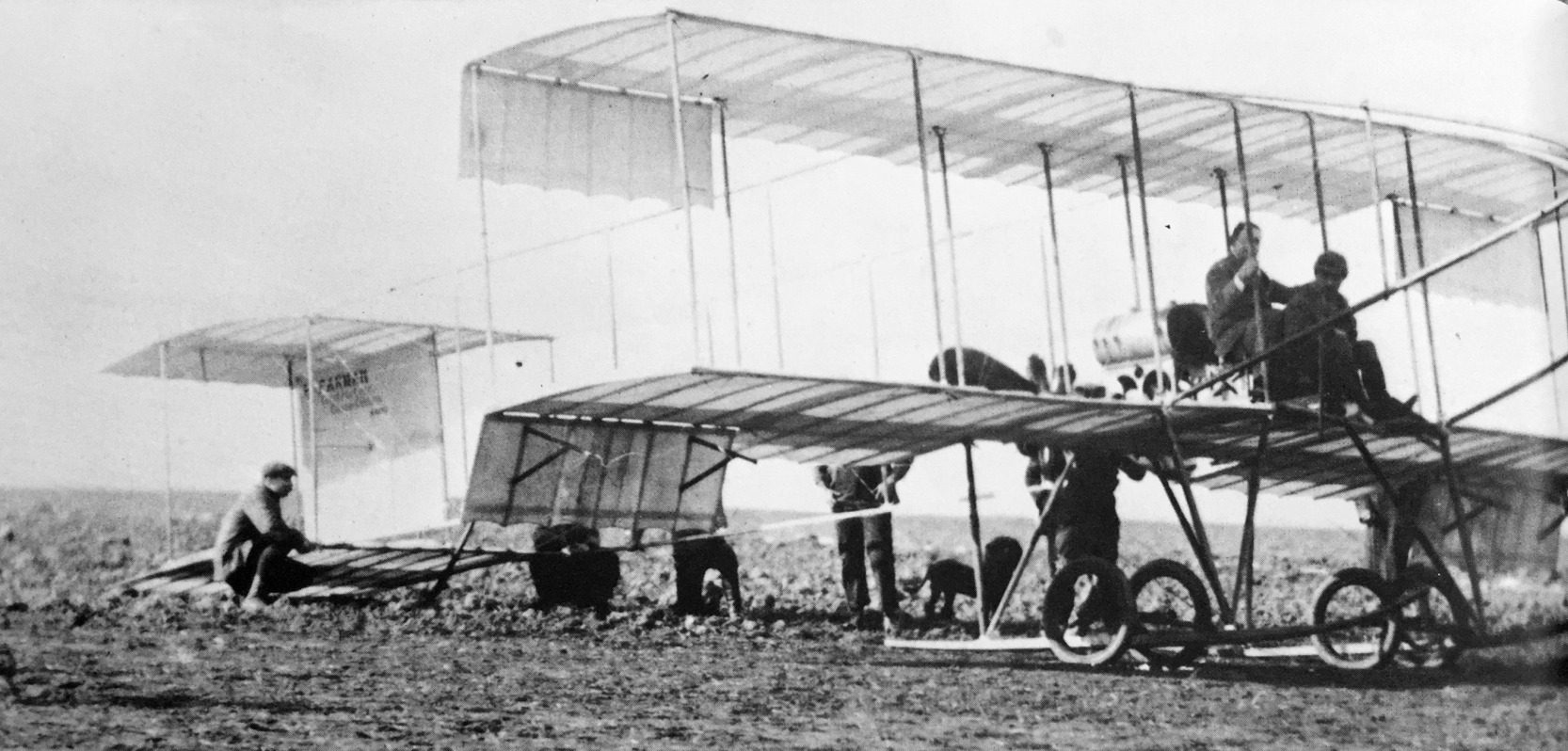
A 1910 photo of a William Randolph Hearst being taken for his first airplane ride by Louis Paulhan in his Farman III biplane at the Dominguez Field Air Meet (courtesy of Kevin Walsh).

A 1910 photo of Louis Paulhan taking off in his Farman III biplane at the Dominguez Field Air Meet.
The Wright brothers did not take part in the event, but were there with their lawyers in an attempt to prevent Paulhan & Curtiss from flying.
The Wrights claimed that the ailerons on their aircraft infringed patents. Notwithstanding their allegations, Paulhan & Curtis still made flights.
However, William Boeing, who had been enthused by the new invention of the airplane, was unable to get a ride on any aircraft at the air meet.
As part of the larger Wright brothers' patent cases, the Wrights actually won monetary damages in U.S. courts for Paulhan's public performances that day.
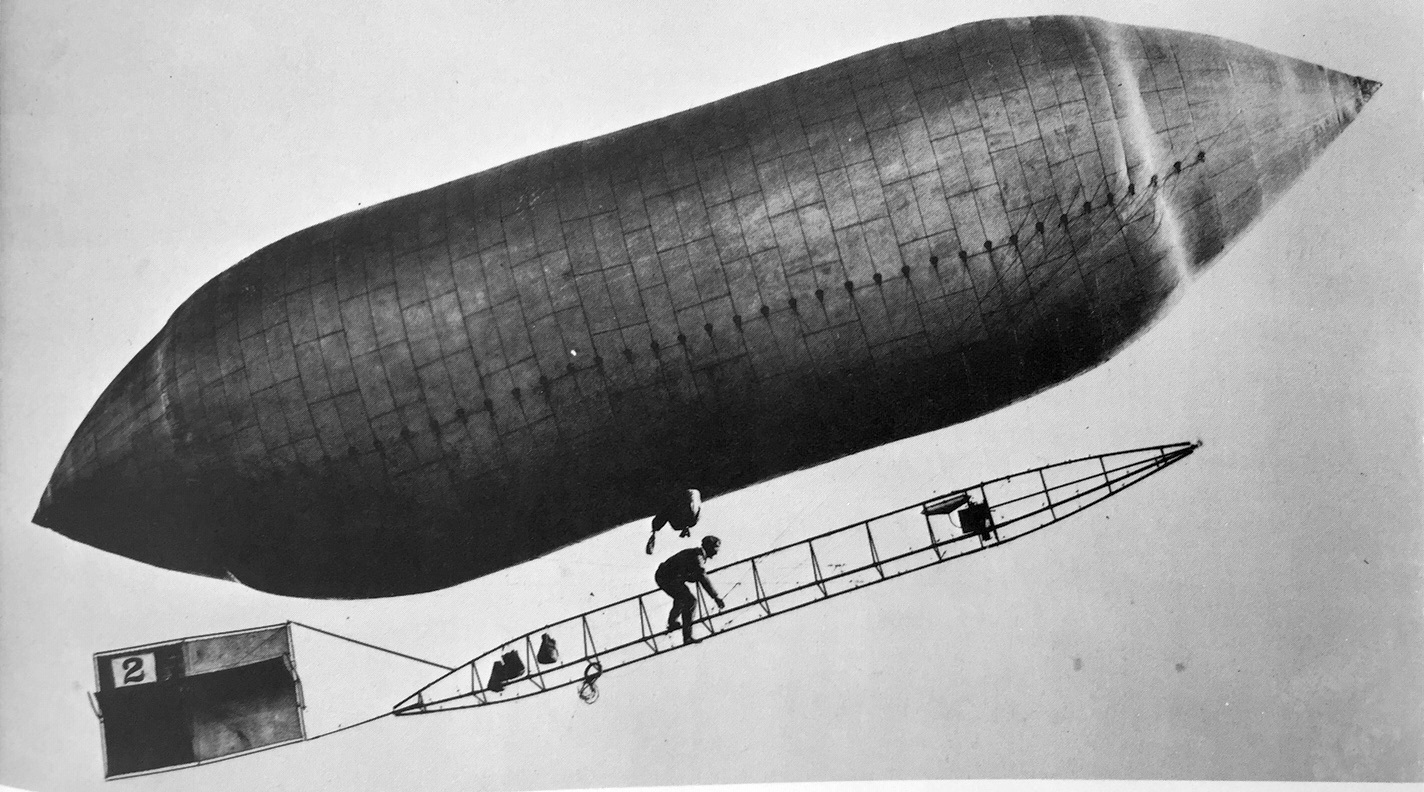
A 1910 photo of a Lincoln Beachey scampering up the open fuselage of a Knabenshue dirigible at the Dominguez Field Air Meet (courtesy of Kevin Walsh).
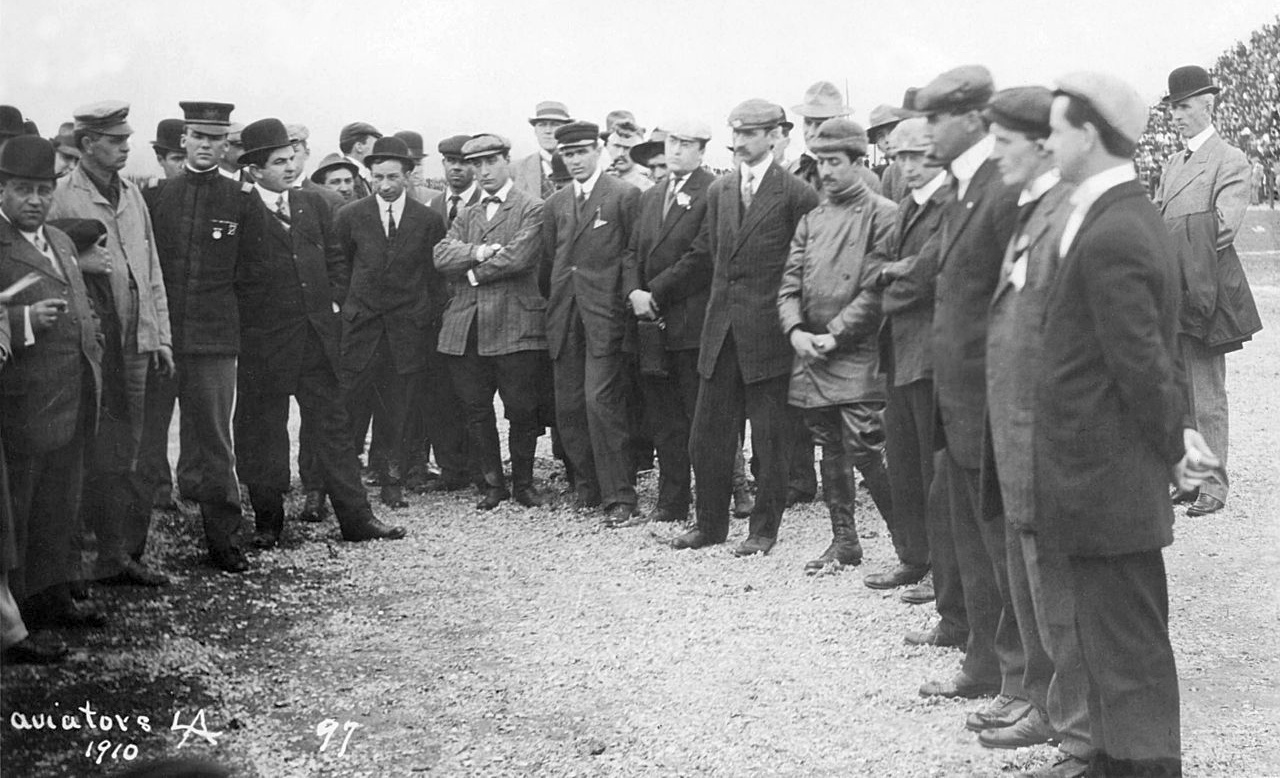
A 1910 photo of prominent participants of the Dominguez Field Air Meet, including Charles Miscarol, Hillery Beachey, Frank Johnson, Glenn Curtiss, Louis Paulhan, Charles Willard, Roy Knabenshue, and Charles Hamilton.
It is not known if Dominguez Field was ever used for aviation again after the 1910 Air Meet.

The last depiction which has been located of Dominguez Field was on a 1919 Pacific Electric system map (courtesy of Kevin Walsh), which labeled “Aviation Field” as a stop south of Dominguez Junction.
On 12/2/59 the site of Dominguez Field became a California Historical Landmark, #718.
The commemorative plaque near the site read: “About one half mile southeast of this spot, on Dominguez Hill in historic Rancho San Pedro,
the first air meet in the United States was held during January 10–20, 1910.
Subsequently, this area has evolved into one of the world's leading aviation-industrial centers.”

A 2018 aerial view shows no trace of Dominguez Field, with the area having been heavily developed.
The precise location of Dominguez Field has not been determined.
It was reportedly located east of the present-day campus of California State University Dominguez Hills,
which would be roughly northwest of the intersection of East Del Amo Boulevard & South Wilmington Avenue.
____________________________________________________
EMSCO Field / Baker Field / Vultee Field / Downey Field, Downey, CA
33.92, -118.13 (North of Long Beach, CA)
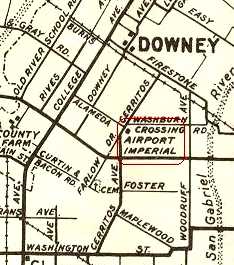
A 1931 street map (courtesy of Gary Alexander) labeled the Downey airfield simply as “Airport”.
This former industrial facility & airfield is a site which is steeped in American aviation & space history,
and yet is largely unknown outside of the immediate local area,
in spite of the tremendous milestones in American aviation & space history which were accomplished on its property.
In 1929, the Downey property was a ranch owned & operated by James Hughan.
E. M. Smith, a local industrialist & founder of the EMSCO company, purchased a 73-acre parcel from Hughan.
Smith’s EMSCO company had a division called Albatross, which manufactured small aircraft.
In addition to manufacturing aircraft, Smith saw the former farm land in Downey as a perfect landing field.
The oldest buildings on the Downey Site were built in 1929 to support the aircraft manufacturing effort.
The earliest depiction which has been located of the airfield in Downey was a 1931 street map (courtesy of Gary Alexander),
which labeled the Downey airfield simply as “Airport”.
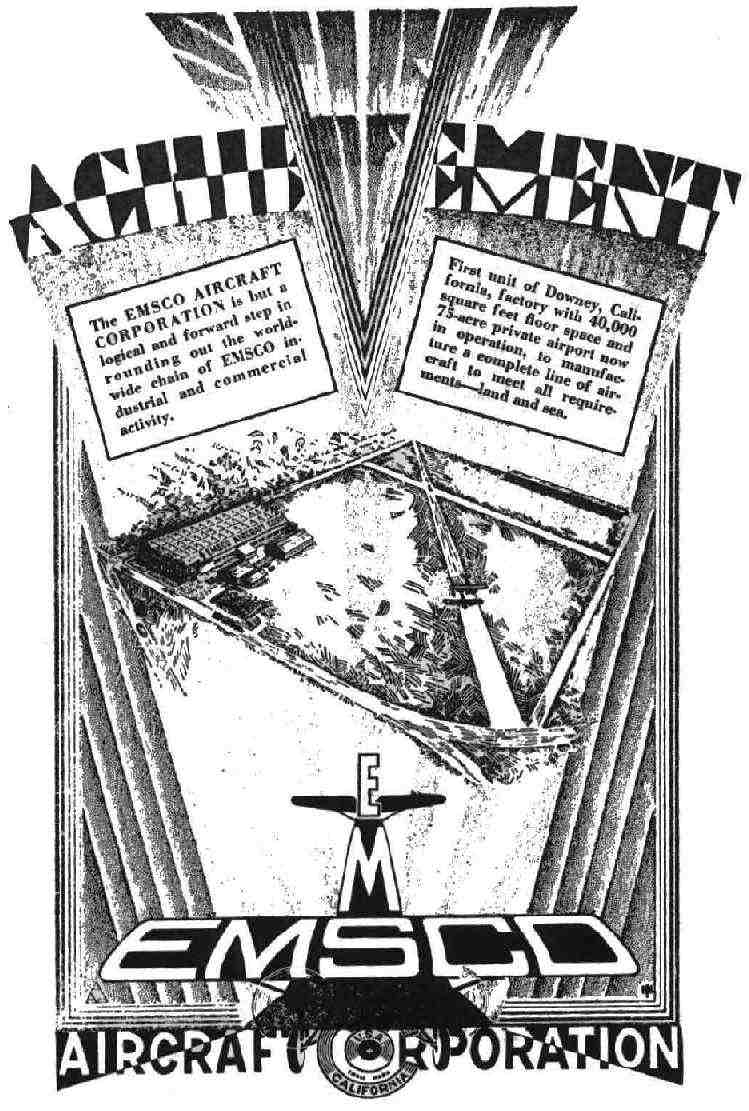
A circa 1929-32 advertisement for Emsco Aircraft Corporation's new Downey facility (from the Fall 2003 Downey Aviator),
describing it as a 40,000 square foot factory & 75 acre private airfield.
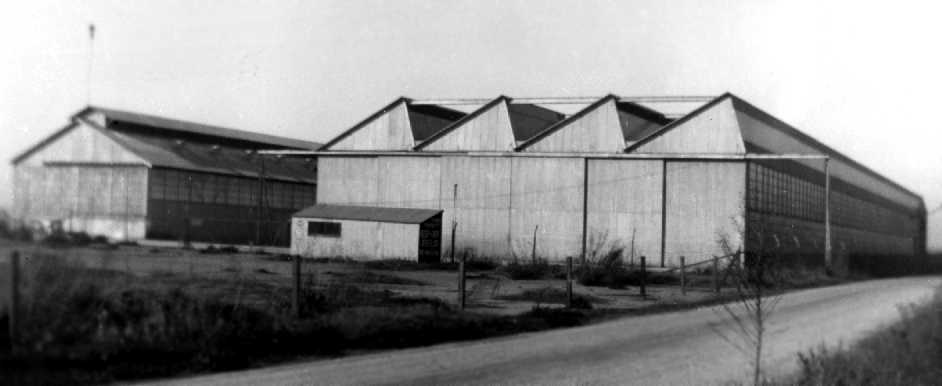
A 1932 photo of the back of the EMSCO aircraft factory buildings at Washburn Crossing facing Cerritos (Lakewood Blvd), (from the Spring 2009 Downey Aviator).
In 1932, with the Great Depression looming, causing poor sales,
EMSCO leased the site to Champion Aircraft Corporation, who manufactured small, inexpensive 2-seat aircraft.
EMSCO Airfield was not depicted at all on the 1932 LA Sectional Chart.
Seven months later, Champion also left the site due to poor sales,
and the site was leased to Security National Aircraft Corporation.
Security was owned by Walter “Bert” Kinner, who designed & built 2 planes for Amelia Earhart.
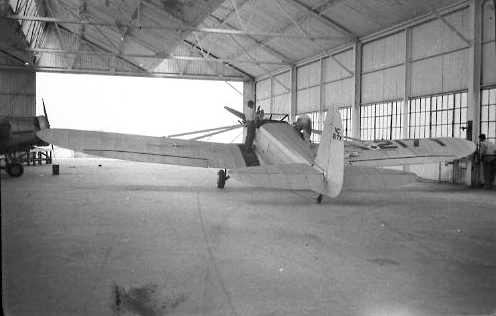
A circa 1933 photo of the Security-National Aircraft Co prototype S-1 Airster, X/NC217Y in Downey (believed to have been taken in Building 1).
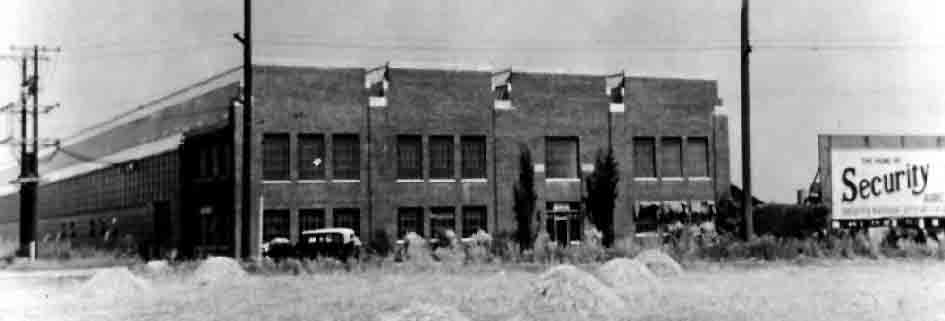
A 1933 photo of what was originally the Security Aircraft building on Lakewood Boulevard
(which still stands as part of Building 1, as of 2005).
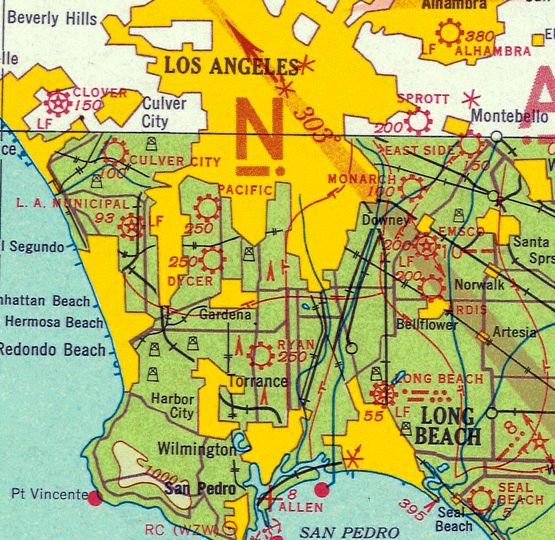
The field was still labeled “EMSCO” on the 1934 San Diego Airway Chart (courtesy of Roger Connor).

A 1935/36 aerial view (from the Library of Congress) looking south depicted Vultee Field as having a single paved northeast/southwest runway, and the Vultee plant on the northwest side.
The airfield name was misspelled as “EMSO” on the August 1936 LA Sectional Chart.

A 1936 aerial view looking northeast at the Vultee plant, with a single unpaved runway visible in the background.
Strangely, the 1936 USGS topo map didn't depict any airfield at this site.
Ownership continued to change hands, and in 1936, Aviation Manufacturing Corporation
moved their Vultee Aircraft Division from Glendale into the Downey Site at the suggestion of Gerard “Jerry” Vultee,
who once worked for EMSCO as their chief design engineer.
The airfield was renamed Vultee Field.
Vultee primarily manufactured large military aircraft & sold planes to the governments of China, the Soviet Union, Turkey and Brazil.
Vultee was working on a contract with the United States government
and was flying back from Washington DC when he & his wife were killed in a plane crash in 1938.
The company forged on without him.

A circa 1937 aerial view looking northeast at the Vultee plant, with “Vultee” written in large letters on the roof,
and a single unpaved runway visible in the background.

Inexplicably, the former EMSCO Field was labeled “Baker” on the January 1938 LA Sectional Chart.
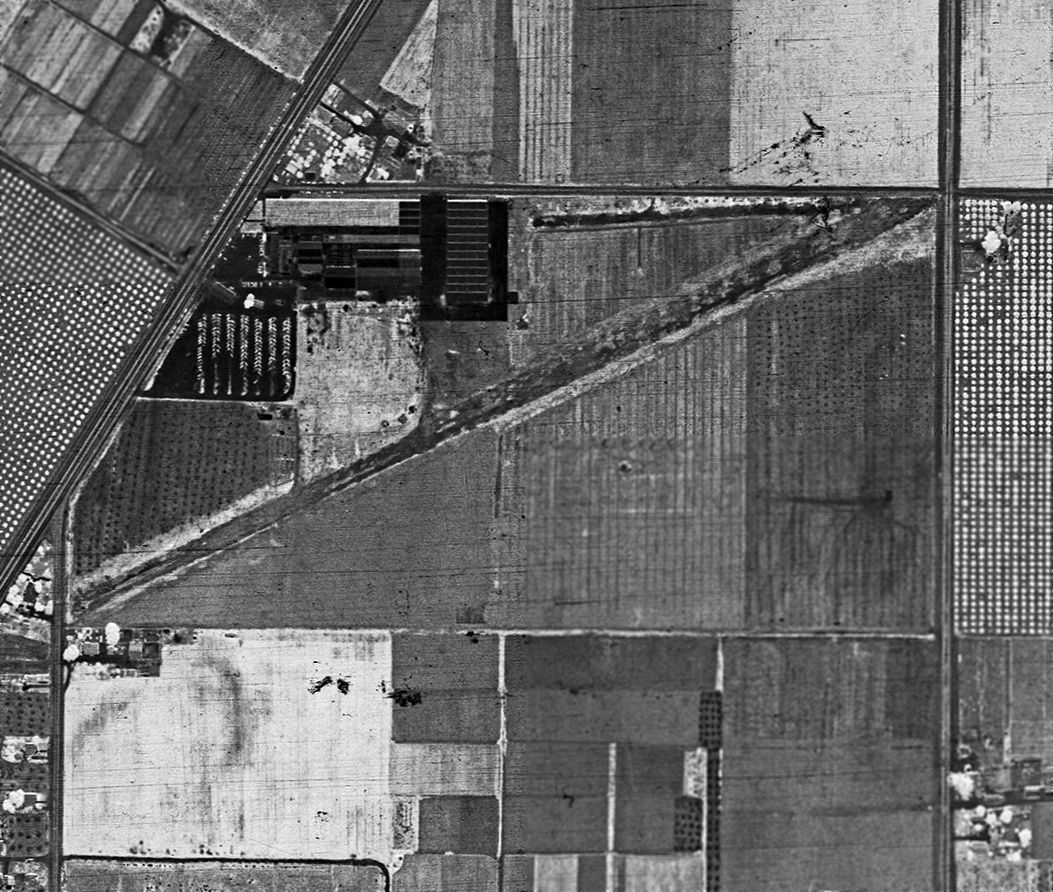
A 5/24/38 aerial view (from the UCSB Library) depicted Vultee Field as having a single unpaved northeast/southwest runway, and the Vultee plant on the northwest side.
By 1938, the Vultee Aviation Manufacturing Company has 1,500 employees
and was producing planes for several countries.
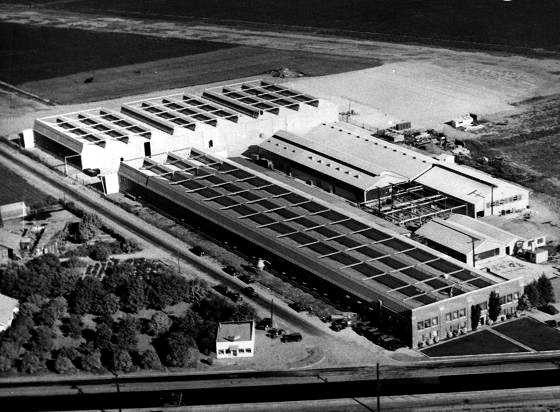
A circa late 1930s aerial view looking east at the Vultee factory, with the runway in the background.

A circa 1930s aerial view looking north at the Vultee factory, with one single-engine aircraft visible next to the the runway, which had been recently paved.


A circa 1930s aerial view of a Vultee V1-A overflying the Downey plant (from the Fall 2009 Downey Aviator).
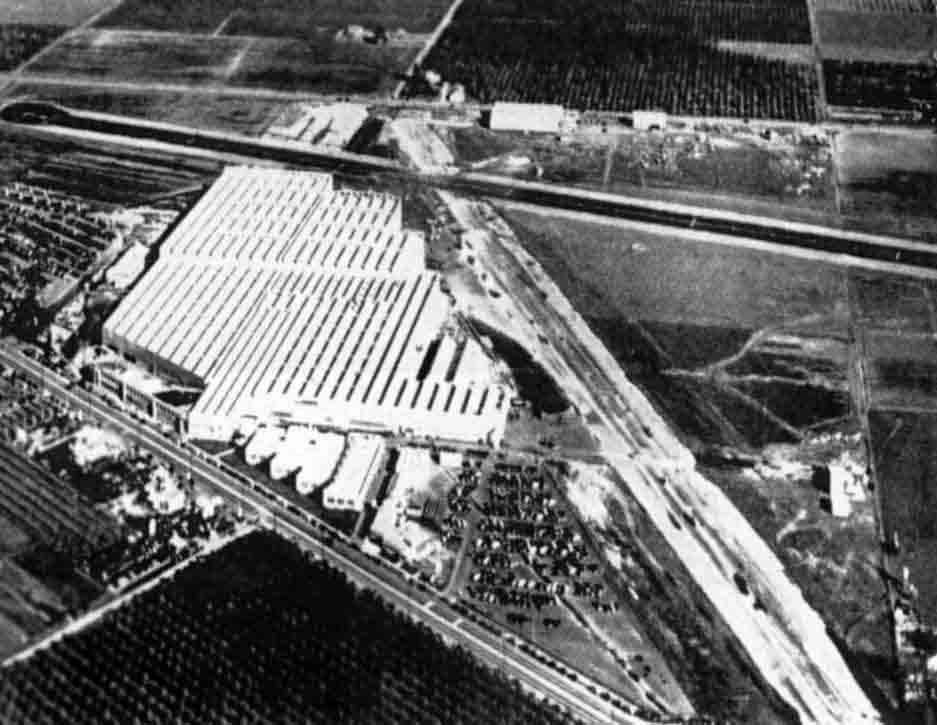
A circa 1930s aerial view looking east at Vultee Field, including the Vultee plant & 2 runways (from the Summer 2008 Downey Aviator).

The 1939 LA County Airports Map depicted Vultee Field as having a single northeast/southwest runway.
Strangely, no airfield in Downey was depicted on the 1939 LA Sectional Chart.

A circa 1940 photo of Vultee V-54A, NX21753, C/n 141, the BT-13 Valiant prototype, at Downey's Vultee Field.


A 1940 photo of huge numbers of BT-13 trainers ready for delivery at Downey's Vultee Field.
The site was labeled “Vultee Feld” on a 1940 LA street map (courtesy of Dan MacPherson).
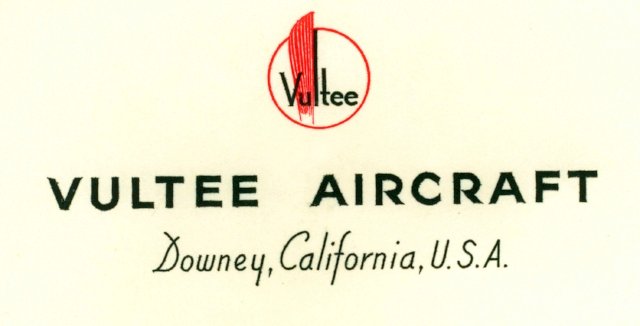
A circa 1940s logo of Vultee Aircraft, Downey, CA.
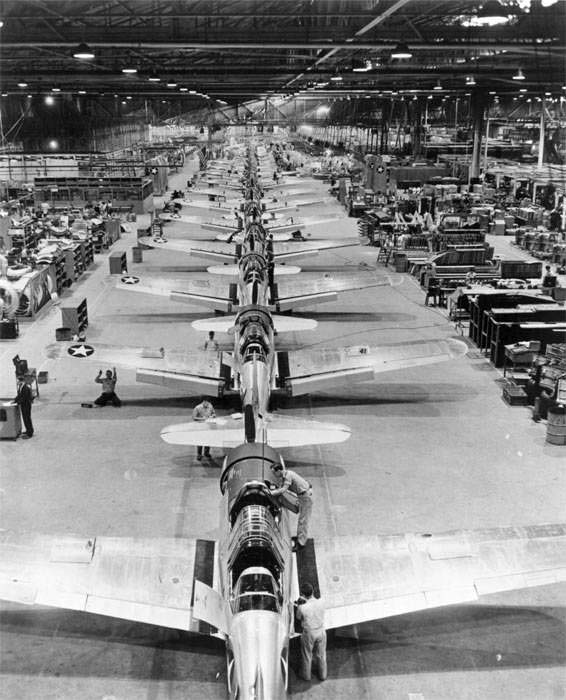
What was at the time "The world's fastest production line", at Vultee in Downey.
In the 1940s the Army Air Corps awarded Vultee Aircraft a contract to make a basic training plane, the Vultee Valiant.
The contract was the largest order ever placed by the Army Air Corps.
In need of additional space, LA Architect Gordon Kaufman designed space which would double Downey’s size.

A circa 1940s aerial view looking northeast at the Vultee plant (greatly expanded since the 1930s photos), with 2 runways visible in the background.
Note how undeveloped the surrounding area was.
Strangely, no airfield in Downey was depicted on the October 1941 LA Sectional Chart.
Due to the value of the Vultee industrial facility to the war effort, was this a case of intentional concealment?
Then came World War II & security at the plant was further increased.
In addition to the anti-aircraft gun which was mounted on the roof,
the entire plant was camouflaged to blend in with the surrounding farmland.
By 1941, the plant’s output represented 15% of all the military aircraft produced in the U.S.
and boasted the first powered assembly line in the aircraft industry.
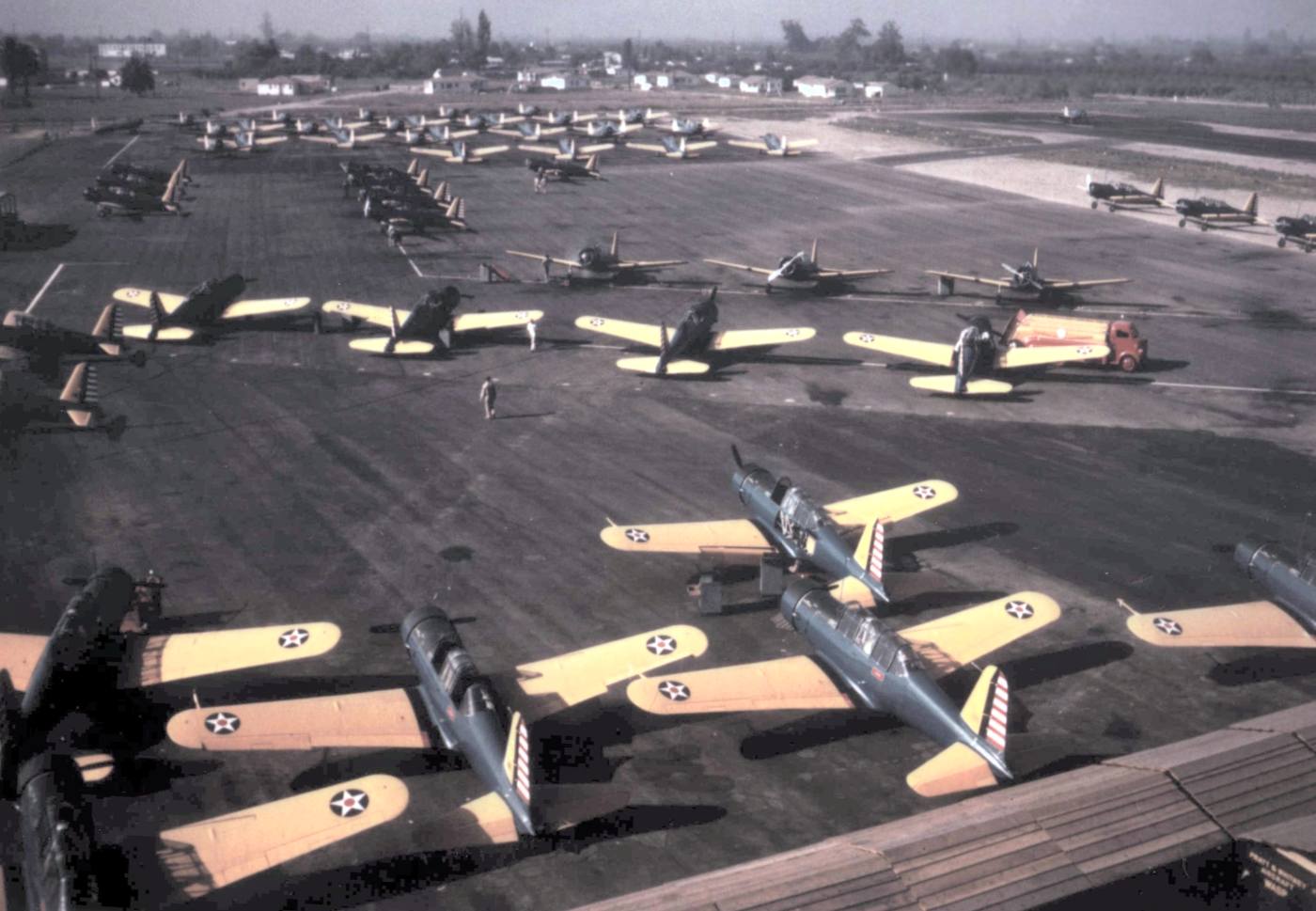
A circa 1941 colorized photo of huge numbers of Vultee BT-13 trainers ready for delivery at Downey's Vultee Field.
Just after Pearl Harbor, Vultee bought 34% of Consolidated Aircraft in San Diego.
Vultee's Downey facility produced Valiant basic trainers, the Vanguard P-66 pursuit plane, and the Vengeance A-31 dive bomber.
Vultee became famous for its ability to produce planes in large numbers quickly. It did this by constant retooling.
To support this unprecedented production at Downey, the Army Air Corps & Vultee greatly expanded the plant in the early 1940s.
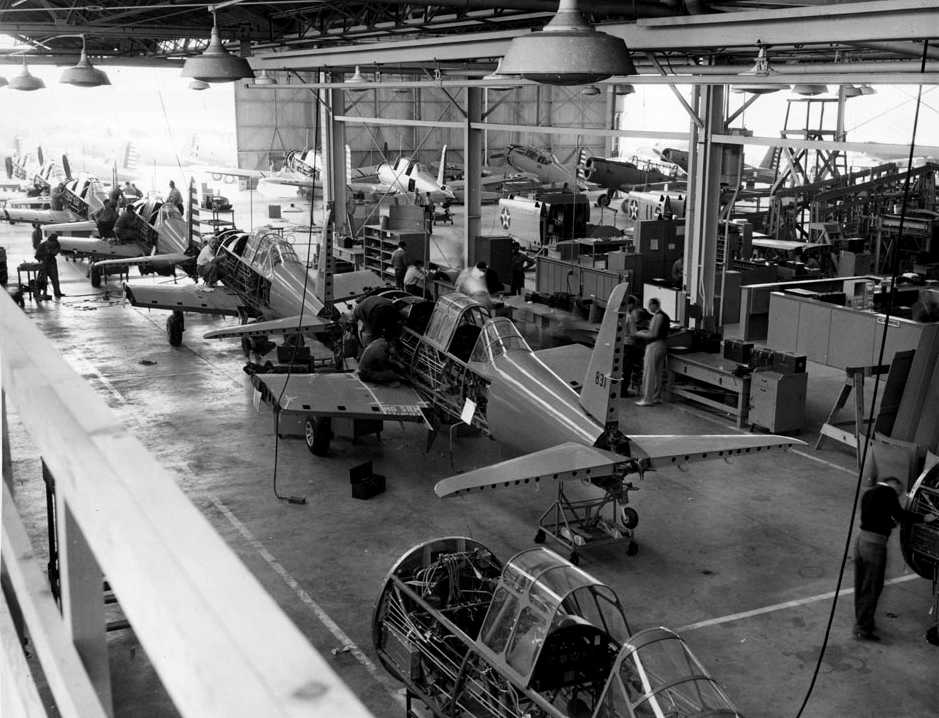
A circa 1940-45 photo of the interior of the Vultee Aircraft Company's plant, showing a production line of U.S. Army Air Corps BT-13 Valiant trainers.

A 1942 photo of 2 Vultee employees inspection an aileron hinge on a BT-13 at Downey.
Note the camouflage netting suspended over the front of the aircraft.

A 1940s aerial view looking northwest at Vultee Field, with camouflage netting suspended over the entire factory complex.

A WW2 view of the Vultee Vengeance assembly line.
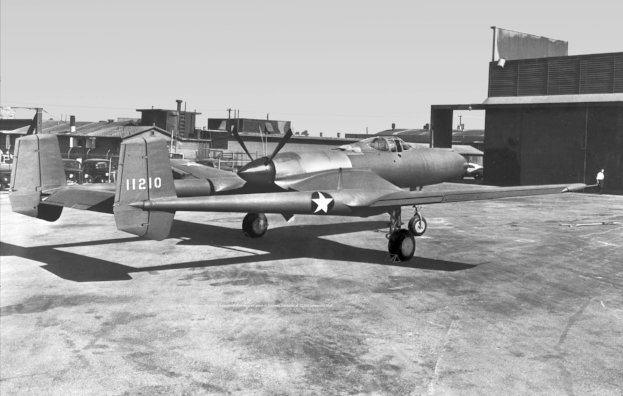
A circa 1943-45 photo of the 1st prototype of the unorthodox Vultee XP-54 Swoose Goose fighter at Vultee Field.
Vultee Field was described by the 1944 US Army/Navy Directory of Airfields (courtesy of Ken Mercer)
as having a 4,000' hard-surface runway.

A circa 1944 aerial view looking northeast at Vultee Field.
The 2 paved runways were plainly apparent, but the Vultee factory on the northwest side had been camouflaged, making it much less recognizable.
The Vultee airfield was still not depicted at all on the March 1945 San Diego Sectional Chart.
The Vultee plant had a USAAF Code of “VU” during WW2,
and built a staggering total of 11,537 BT-13 & BT-15 trainers.
It had a peak employment of over 30,000 people – back when Americans actually manufactured things.
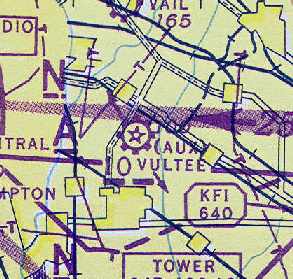
"(Aux)" Vultee" was depicted as a civil airfield
on the August 1945 San Diego Sectional Aeronautical Chart (courtesy of Chris Kennedy).

The 1945 AAF Airfield Directory (courtesy of Scott Murdock) described Vultee Airport
as a 165 acre irregularly-shaped field within which were 2 asphalt runways, measuring 3,956' NNW/SSE & 2,962' ENE/WSW.
The field was not said to have any hangars, although the diagram depicted a taxiway leading to what appeared to be a hangar west of the runway intersection.
The airport was described as being privately owned & operated.

A circa 1940s aerial view looking northeast at the Vultee plant, with the airfield behind it.
As the Second World War wound down, so did the Downey facility.
The Vultee Field Division of Convair won a Navy contract for LARK surface-to-air missiles in 1945.
Turning to the missile industry, the Vultee field division of Convair
was awarded a $1.2 million contract to study long-range missile weapons systems,
and focused on the ballistic missile concept, using the German V-2 as a model.
The government canceled this contract in 1946 for economic reasons,
With wartime contracts dried up, Vultee turned to peacetime products including pre-fabricated homes using plastic & aluminum.
In 1947, North American Aviation, which had a number of jet military contracts to fill,
leased a portion of the Vultee assembly line in Downey.
North American used Downey to produce its AJ-1 Navy bomber & T-28 Trojan post-war trainer.
A 1947 street map (courtesy of Kevin Walsh) labeled the property as “Vultee Aircraft Inc.”
All Vultee use of the Downey facility ceased by 1948.

Vultee Field was depicted on the September 1948 San Diego Local Aeronautical Chart (courtesy of Chris Kennedy)
as having 2 hard surface runways, with the longest being 4,000'.
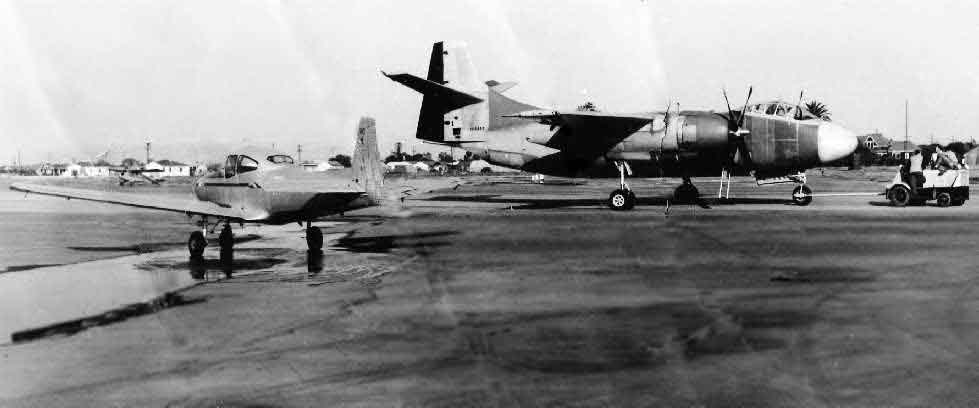
A circa 1949 photo of an Aeronca 65TC, a North American Navion, and the 1st prototype North American AJ-1 Savage at Downey
(courtesy of Nick Glavinich, who worked for many years at the Downey site under North American & Rockwell, via Nick Taylor).
Nick observed, “The photo shows a North American Navion (NC4998K) running its engine
while the very first production AJ-1 Savage is being towed in the background.
The 1st Savage (BuNo 122590) had its first flight in May of 1949. I would assume this is close to the date of the photo.”

The 1949 USGS topo map depicted the Downey “Industrial Airport” as having 2 paved runways, with the factory & other buildings at the northwest corner.
North American Aviation needed more research space, and in 1950 purchased the Convair portion of the Downey plant.
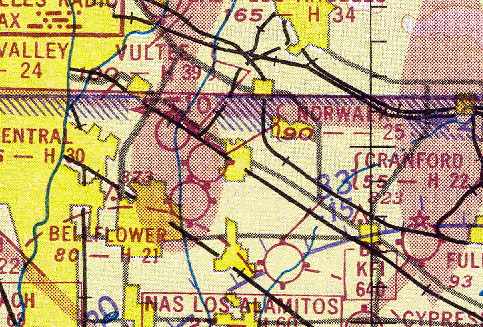
Vultee Field was evidently closed at some point between 1948-51,
as the Aerodromes table on the March 1951 San Diego USAF Sectional Chart (courtesy of Chris Kennedy)
described “Vultee Field” as "Closed", even though the field was still depicted on the chart.
The Downey facility developed the Navaho intercontinental cruise missile in 1953-54,
whose technology would give birth to our first space vehicles.
A 1952 aerial view showed the field as having a paved Runway 17/35.
Two closed crosswind runways still remained, and dozens of aircraft lined both sides of the western end of the southern crosswind runway.
At some point between 1951-54 the field may have been reopened as a private airfield, now named "Downey",
as that is how it was depicted on the September 1954 USAF LA Sectional Chart (courtesy of Chris Kennedy).
It was described as having a 3,900' hard surface runway & its own control tower.

A 1954 aerial view of Vultee Field, captioned as “USAF Plant 16”.
Both runways were still intact, the crosswind runway was being used to store a large number of aircraft.

A circa 1950s photo of a North American North American T-28D sitting on the Downey compass rose after production
(courtesy of Nick Glavinich, who worked for many years at the Downey site under North American and later Rockwell, via Nick Taylor).
Nick observed that “T-28D 51-3508 according to online sources is S/N 174-46.”
The 1955 San Diego Sectional Aeronautical Chart (courtesy of John Voss)
described "Downey" as a private airfield having a single 3,928' asphalt runway.
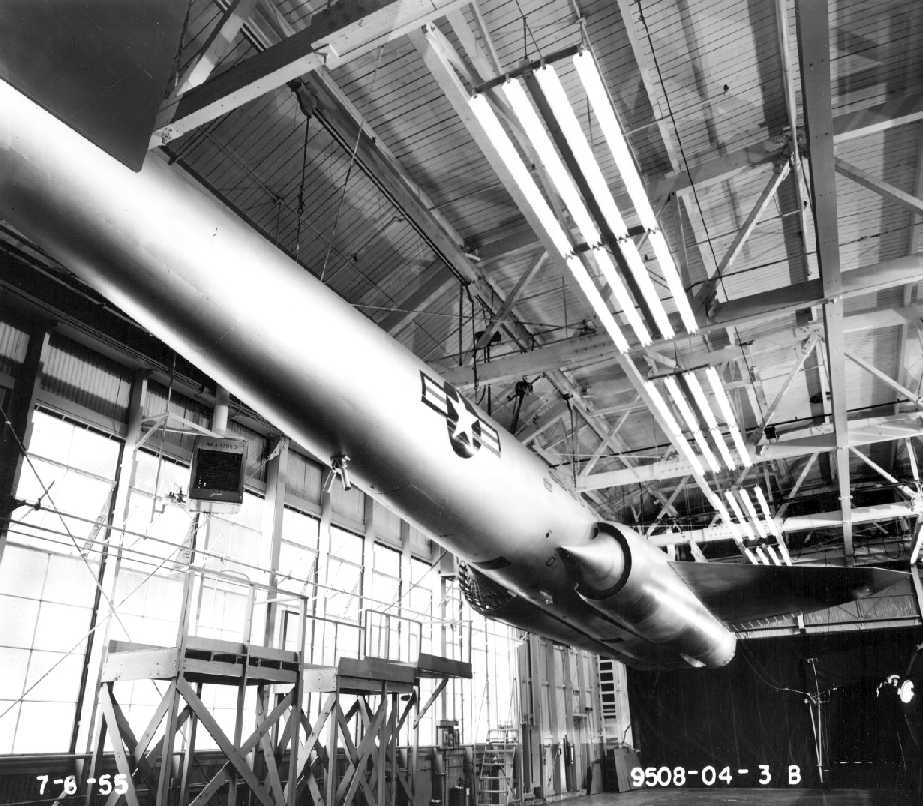
A 7/6/55 photo of a mockup of the North American G-38 Navajo III (XB-64A/XSM-64A) cruise missile,
most likely taken inside the Downey plant (from the Summer 2008 Downey Aviator).

A 1955 street atlas (courtesy of Kevin Walsh) labeled the property as “North American Aviation Inc. Downey Plant".

The last aeronautical chart depiction which has been located showing Vultee Field as an active airfield
was on the 1956 LA Local Aeronautical Chart (courtesy of Tim Zukas),
which depicted "Downey" as a private airfield having a 3,900' paved runway.
In the late 1950s North American's Downey plant became the location for developing the AGM-28 Hound Dog supersonic nuclear air-to-ground missile.

A 1958 aerial view looking southeast at the Vultee factory, with at least one aircraft visible on the far side of the primary runway.
The majority of the crosswind runway had been taken over for employee parking.
Vultee Field was apparently closed at some point between 1956-60,
as it was labeled "Abandoned airport" on the 1960 LA Local Aeronautical Chart.

A circa early 1960s aerial view of rows of North American AGM-28 supersonic cruise missiles on the Dowey ramp (from the Fall 2009 Downey Aviator).
North American's Downey plant went on to become a major contributor
in developing the technology that was central to the Space Race.
The company won the contract to make the “Little Joe Launch Vehicle” to test the Mercury capsules.
In 1960, North American was working on the development of the X-15 aircraft, truly a pioneer in aviation history.
The X-15 aircraft was the first winged craft to reach 4, 5 and 6 times the speed of sound,
and fly at altitudes greater than 100,000 feet.
In 1961 North American was awarded 2 contracts from NASA:
the Saturn SII launch vehicle & the Project Apollo Spacecraft Development program.
With that, Downey became the hub of America’s lunar mission.
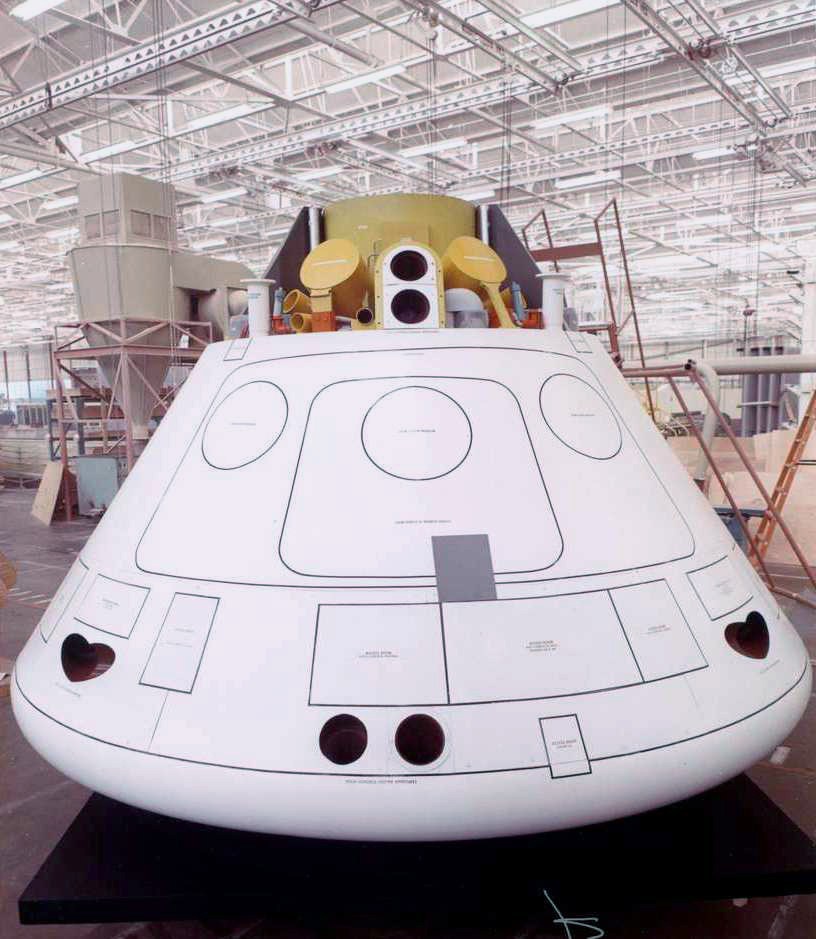
A circa 1960s photo (enhanced by David Waters) of an Apollo Command Module mock-up or prototype inside Downey's Building 1.
According to Wikipedia, a total of 722 Hound Dog nuclear cruise missiles missiles were produced by North American Aviation by the time its production ended in March 1963.
Dan recalled, “In 1963 the runway & some hangar buildings still existed but the airstrip had not been used for some time.”
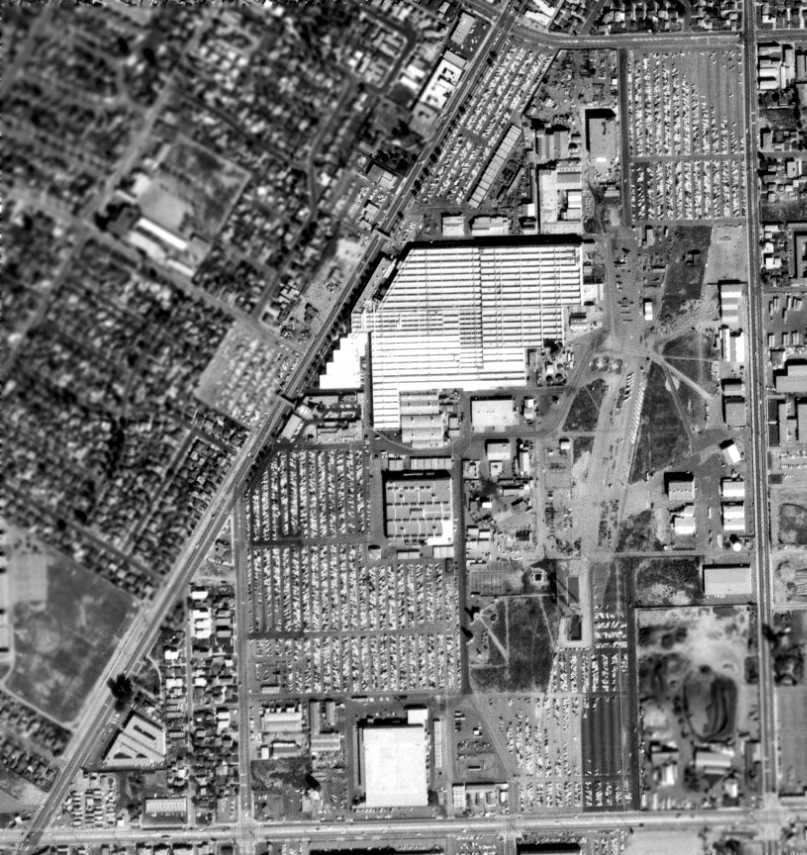
A 2/28/63 USGS aerial view showed the dramatic transformation of the Downey site compared to the 1958 photo,
with most of the airfield having been covered by parking lots & other buildings related to the site's bustling activity for its new role for the space program.

but the southern half of the runway still remaining intact.
In 1964, the North American Downey AFP16 facility was transferred to NASA, thence being known as NASA Industrial Plant, Downey.
North American merged with Rockwell in 1967, becoming North American Rockwell Corporation.
A 1972 aerial view showed only sections of runways still recognizable,
with the majority of the former airfield having been covered by various industrial buildings.
In July 1972, at the end of the Apollo program,
Downey was given the job of assembly & component manufacture of the Space Shuttle Orbiters.
According to the Spring 2006 Downey Aviator, “In the early 1970s Rockwell built a full-scale mock-up of the orbiter
in the DEI Room of Building 1 at the Downey plant.
Built with steel framing, a plywood skin & a variety of other materials representative of each of the shuttle’s components.”
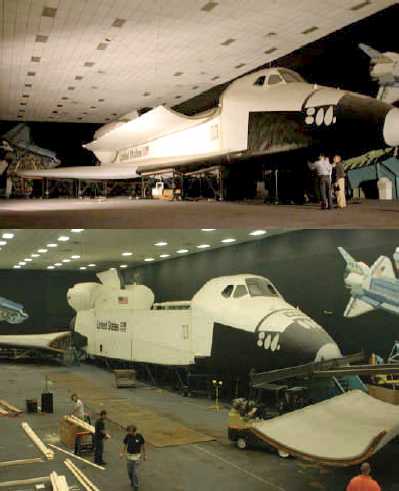
Two circa 1970s photos of the full-scale Space Shuttle mockup inside the DEI room of Downey's Building 1 (from the Spring 2006 Downey Aviator).
This massive artifact of American spaceflight history would remain hidden in storage in the Downey buildings for most of the next 30 years.
North American Rockwell changed its name to Rockwell International in 1973.
From 1975-90, a total of 5 Space Shuttle Orbiters (Columbia, Challenger, Discovery, Atlantis, and Endeavor) were constructed at Downey,
perhaps being one of the site's most prominent accomplishments in aviation history.
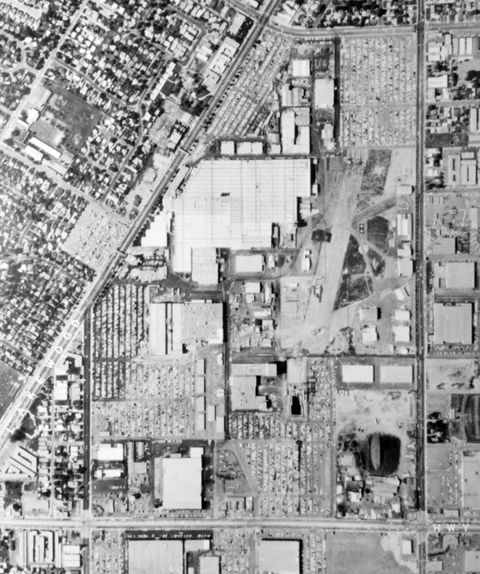
A circa 1983 aerial view (courtesy of Kevin Walsh) showed the majority of the Downey airfield had been covered by parking lots & other buildings,
but a few small sections of runway remained recognizable.

A 1994 aerial view looking north at the Vultee Field site showed a 1,400' long piece of remaining runway pavement was still very evident,
east of the factory building, running north-northeast/south-southwest, along with at least 3 other smaller intersecting portions of runways or taxiways.
At some point before 1994 the southeast corner of the former Downey airfield property (previously the location of Vultee Building 288)
was reused as the site of a Kaiser Permanente medical complex, with several multi-story buildings.
During the 1990s, the North American Rockwell workforce at Downey was decreased.
According to Rockwell employee Ryan Pierson, “Boeing purchased the aerospace & defense divisions of Rockwell in 1996.
Technically, it was a merger using a Reverse Morris Trust.
Hence, the merger-sounding name of Boeing North American was given to those divisions, resurrecting the North American name.”
Boeing began consolidating its space operations shortly after the purchase.
On the 1998 USGS topo map, the Downey facility was still labeled "NASA Industrial Site".
According to the Spring 2006 Downey Aviator, the full-scale mockup of the Space Shuttle in the DEI Room of Downey's Building 1
“was continually updated & was in active use until the Downey facility was officially closed in 1999.”
Boeing announced that it would close the Downey plant permanently by the end of 1999.
According to the Spring 2006 Downey Aviator, the full-scale mockup of the Space Shuttle in the DEI Room of Downey's Building 1
“was officially deeded to the City of Downey in December 1999 as a unique artifact of the space shuttle program.”
According to the Spring 2006 Downey Aviator, “In the summer of 2003, in order to protect the mock-up [Downey's full-scale mockup of the Space Shuttle]
from encroaching development activities at the former engineering and manufacturing facility,
the City engaged a team of professional museum conservators & movers to evaluate, inventory, partially disassemble,
and move the shuttle to a nearby storage facility where it can be better protected & stabilized until it can be moved to a new, permanent home.”
At some point between 1999-2005, most of the former Vultee / North American complex was reused as “Downey Studios”,
the largest independent film facility in Los Angeles.
Downey Studios was managed by Industrial Realty Group,
which is among the country’s largest private owners of commercial & industrial properties.
The Downey Studios had extensive production facilities,
including the biggest undeveloped back lot (20 acres of open space – the former airfield area),
over a million square feet of production space (inside the former factory buildings),
and a 5 million gallon indoor water tank (the largest in North America).
The “back lot” included a “suburban street”, with facades of 17 houses.
Major movies which have been shot at Downey Studios include Spider-Man 2, Catch Me If You Can, Van Helsing, and The Italian Job.
All former Vultee buildings to the north of Building 1 were evidently torn down at some point between 2004-05
to make way for a retail development.
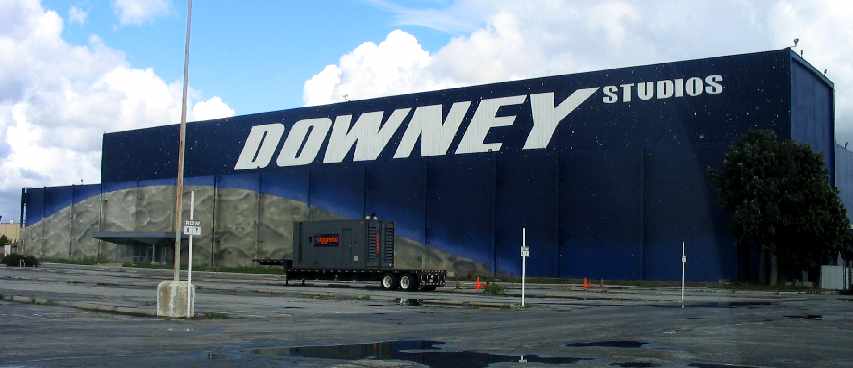
A February 2005 photo by Paul Freeman looking east at the front of Building 290,
a 122,000 square foot former North American factory building at the southwest end of the Downey complex.
It had been repainted “Downey Studios”, with a huge mural of the moon along the front face of the building.
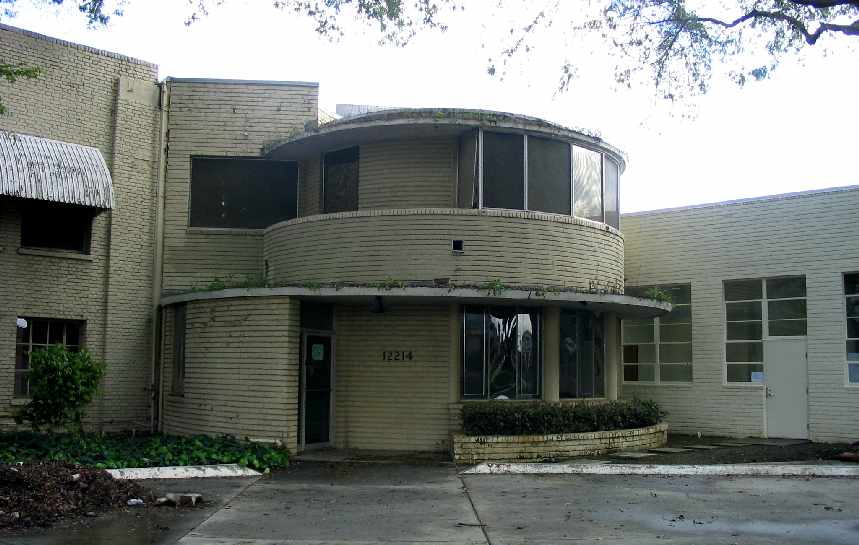
A February 2005 photo by Paul Freeman looking east at the main entrance of the 300,000 square foot former Consolidated Vultee headquarters building.

A February 2005 photo by Paul Freeman of the “Consolidated Vultee” logo
which sits in the center of the lobby of the company's headquarters.
According to former Rockwell employee Ryan Pierson, “The Consolidated Vultee logo on the floor of the lobby of the Building 1 Annex
was part of the linoleum or ceramic tile floor.
That logo was covered by carpet for years.
I believe the plan is to move that logo to the museum that is being built on the site by the Aerospace Legacy Foundation.”
Behind the headquarters building sits the massive (627,000 square foot) former Vultee factory (Building 1).
A Kaiser Permanente medical complex occupies the southeast end of the former airfield.

A February 2005 photo by Paul Freeman, looking northwest at one of the number of smaller hangars
which remained on the eastern side of the former airfield area.

A February 2005 photo by Paul Freeman, looking west across the former airfield area.
In the center of the photo are visible some of the facades of the front of “houses”
which have been constructed on the site (presumably for TV/movie filming work).
One of the WW2-era small hangars is on the right.
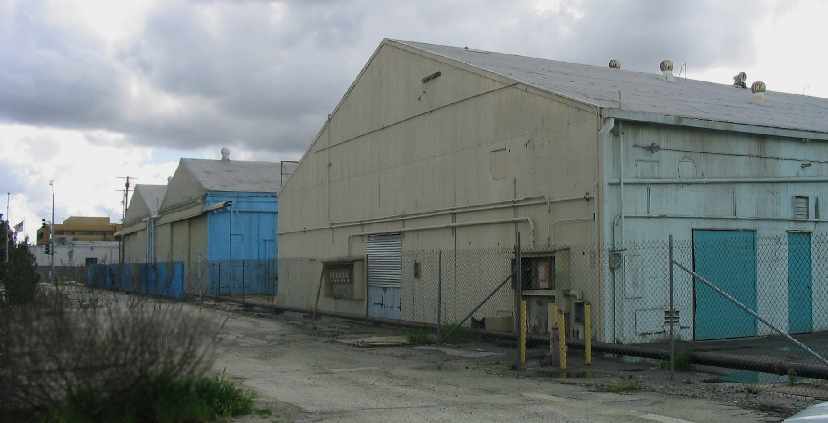
A February 2005 photo by Paul Freeman, looking southwest at a few of the number of smaller hangars
which remained on the eastern side of the former airfield area.
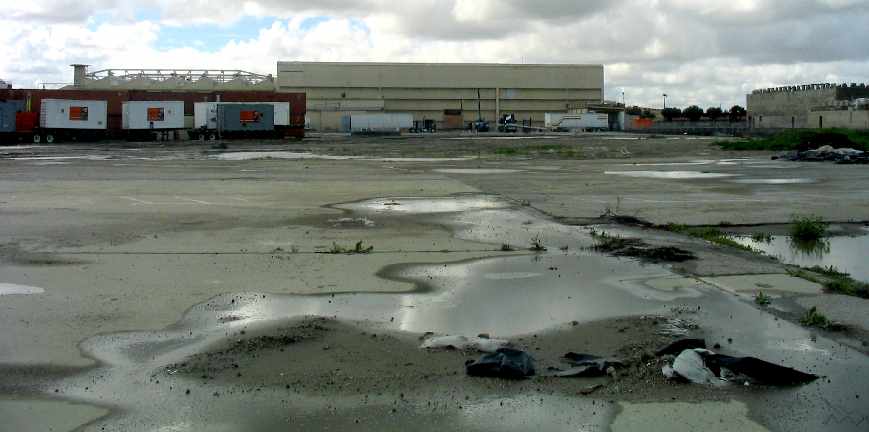
A February 2005 photo by Paul Freeman, looking west at the rear
of the former Vultee factory (Building 1) in the middle of the west end of the site.
The former runway pavement in the foreground still remained intact.
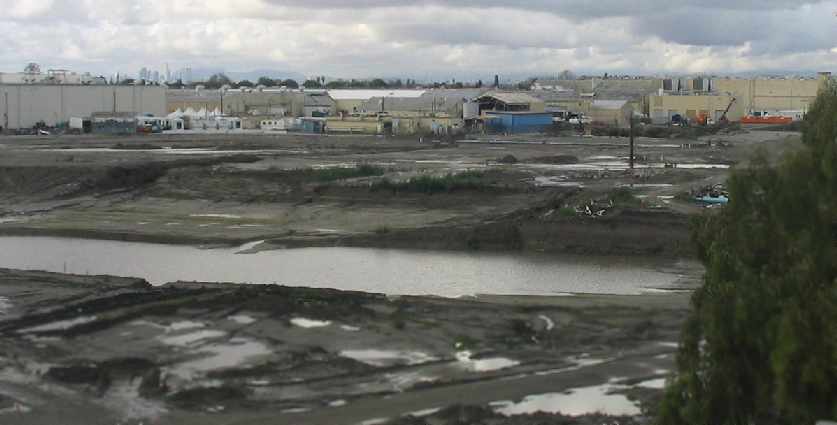
A February 2005 photo by Paul Freeman, looking northwest across the former airfield area,
toward the rear of the former Vultee factory (Building 1).
The former runway area in the foreground was excavated at some point between 2004-05.
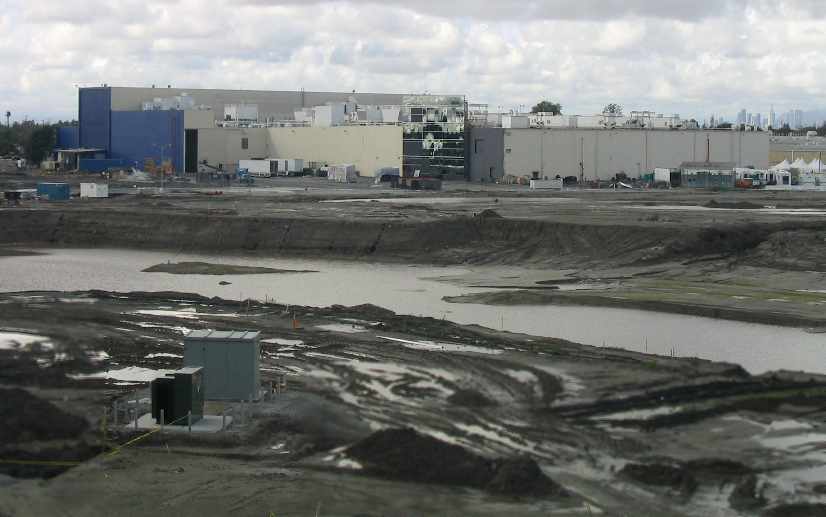
A February 2005 photo by Paul Freeman looking northwest at the rear
of Building 290 (presumably the former North American factory building) at the southwest end of the Downey complex.
What appears to be a “mirror wall” was constructed at the southeast end of the building (presumably for movie filming work).
The former runway area in the foreground was evidently excavated at some point between 2004-05.
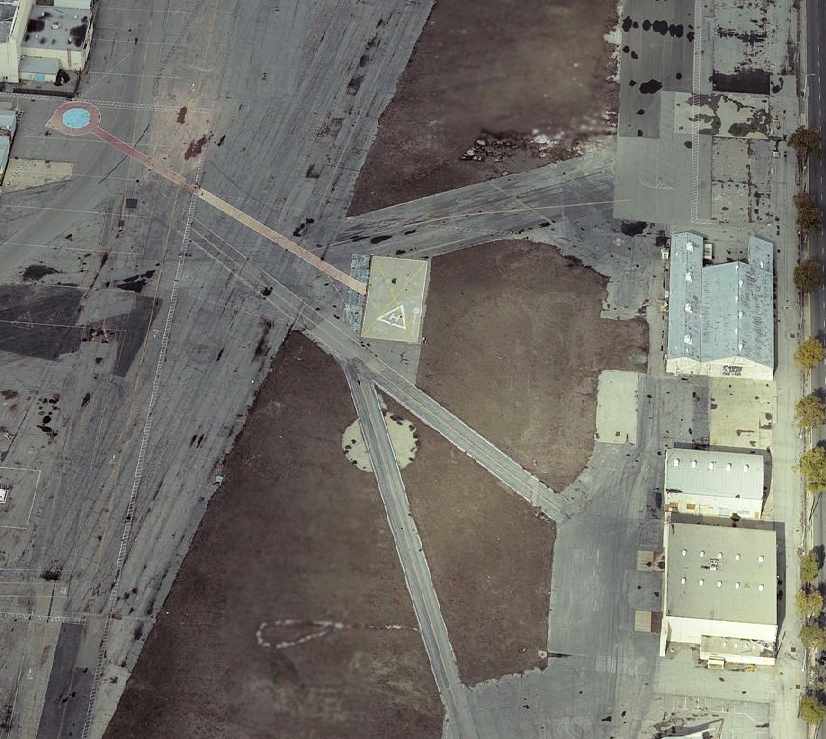
A circa 2005 aerial photo looking north at a former helipad as well as several vintage hangars on the east side of the Downey facility.
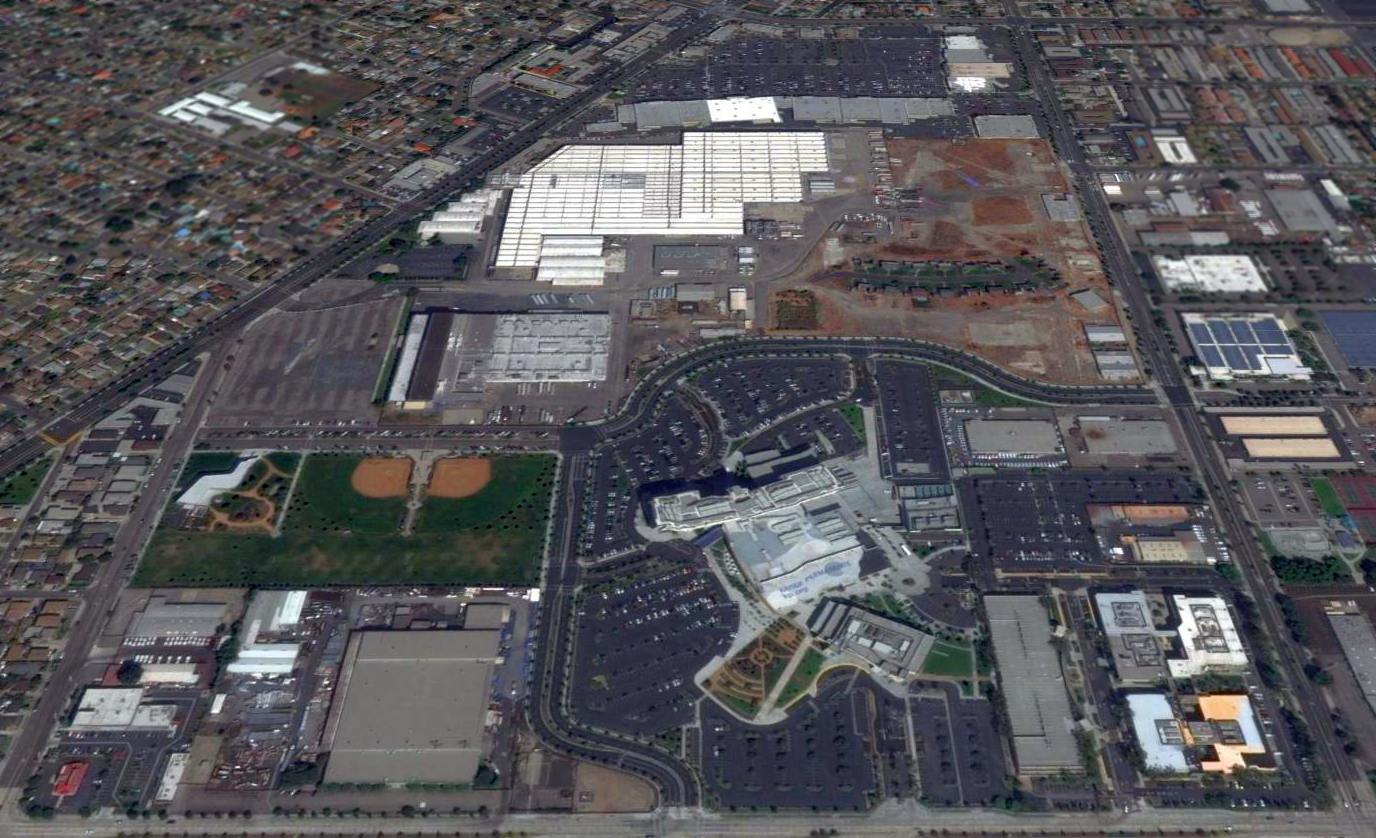
The last photo which has been located showing the Vultee factory complex still intact was a 2011 aerial view looking north.
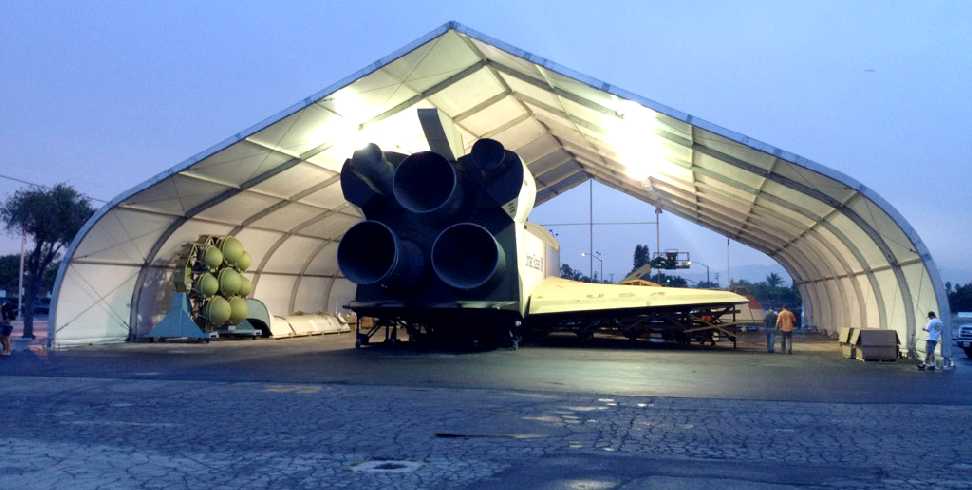
A 7/12/12 photo of the original full-scale Space Shuttle mockup,
after finally seeing the light of day after 30 years of being hidden in storage inside a former North American Downey building.
This priceless artifact of America's technological history has been temporarily moved to an outdoor tent,
until the Columbia Memorial Space Center can construct a building to properly display it.

A sad November 2012 photo of the former Vultee / North American factory buildings, the site of so much American aviation technological development,
being demolished to make way for the new Tierra Luna shopping center.
A 2013 aerial photo showed that 95% of the historic Vultee / North American buildings had been completely removed,
with only the former Vultee headquarters building remaining along Lakewood Boulevard.
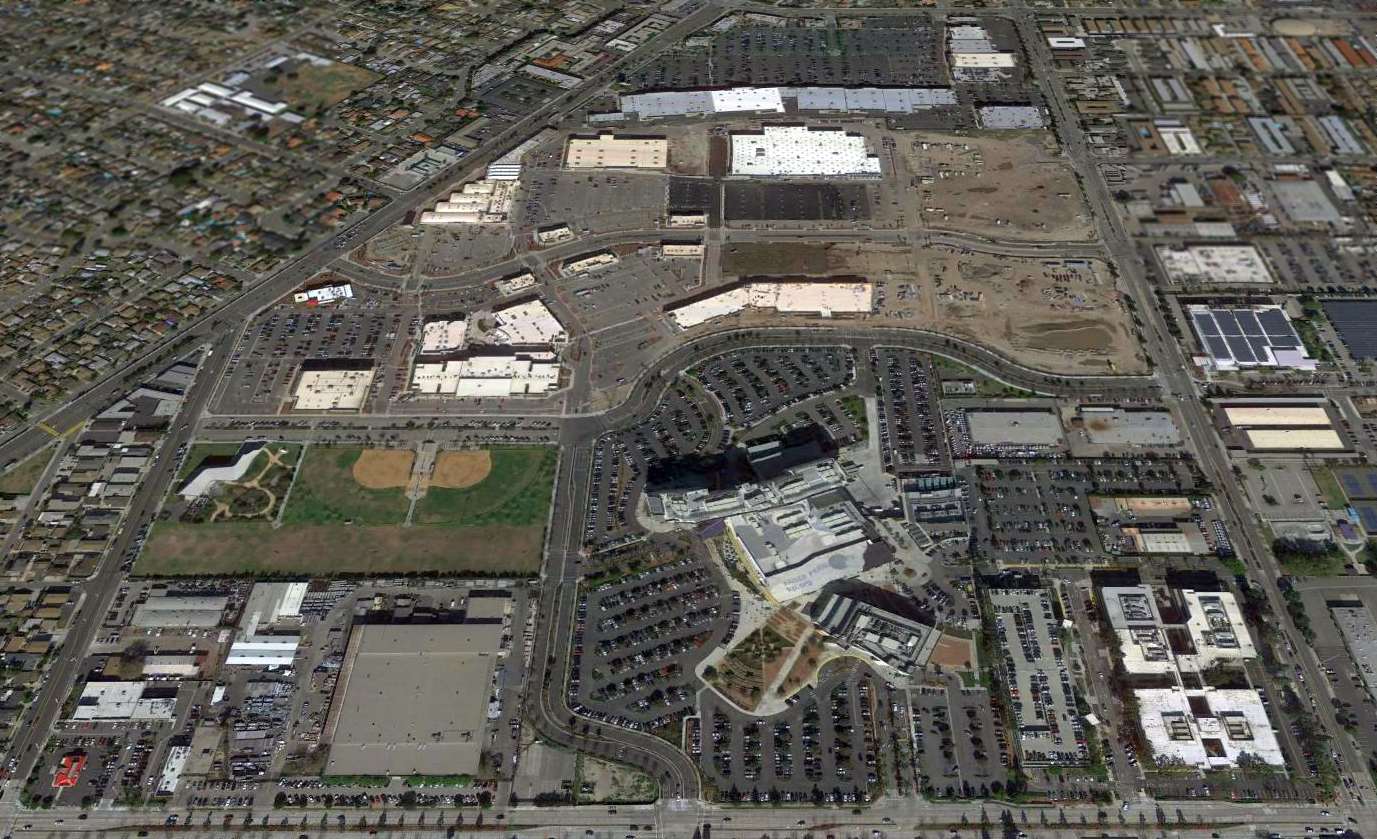
A 2016 aerial view looking north at the Vultee Field site showed the Vultee headquarters building along the northwest side is the only remaining trace
of this former airfield & aircraft manufacturing complex.
The massive factory buildings have been completely removed, replaced by big-box retail stores.
Not a good trend for our country: high-pay engineering & manufacturing jobs replaced by low-pay retail jobs selling imported goods.
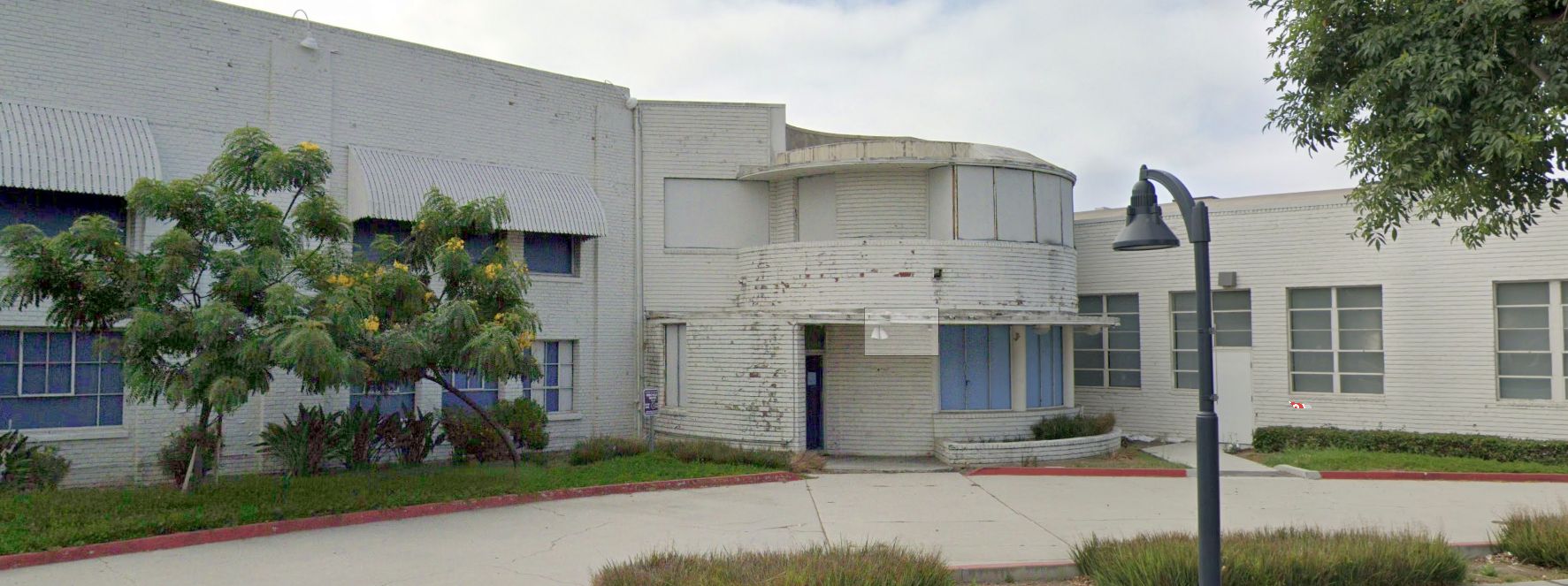
A 2022 photo looking east at the main entrance of the abandoned former Consolidated Vultee headquarters building.
The site of Downey Field is located northeast of the intersection of Imperial Highway & Lakewood Boulevard.
See also:
http://www.b25.net/bt13/bt13.html
http://thepaperink.com/1994/94tt0909.htm
http://thepaperink.com/1993/93tt1126.htm
____________________________________________________
33.88, -118.132 (Southeast of Downtown Los Angeles, CA)

A 3/24/33 Commerce Department Ratings Certificate awarded to Ardis Airport (courtesy of Mark Gebert).
This short-lived little general aviation airport was not yet depicted on the June 1932 LA Sectional Chart.
The earliest reference which has been located to Ardis Airport was its 3/24/33 Commerce Department Ratings Certificate (courtesy of Mark Gebert).
It granted Ardis Airport the rating of D-4-X, and indicated that it was owned by J.H. Ardis, and managed by Lloyd Ruether.
According to an article by John Adams (courtesy of Mark Gebert),
Arids Airport “ran between Clark Avenue & Lakewood Boulevard north of what is now Somerset.
Access was by way of a now defunct road called Cerritos.
Dorothy Ruether flew an OX-5 Eaglerock with her husband, Lloyd.
The plane was based in the mid-1930s at an airfield (actually a pasture) owned by the Ardis family.
The land was rented to a dairy which sublet portions that were used as an airstrip.
What the cows thought of all the goings-on is pure conjecture.
The pilots who used the field called themselves the Clearwater Flying Club.”
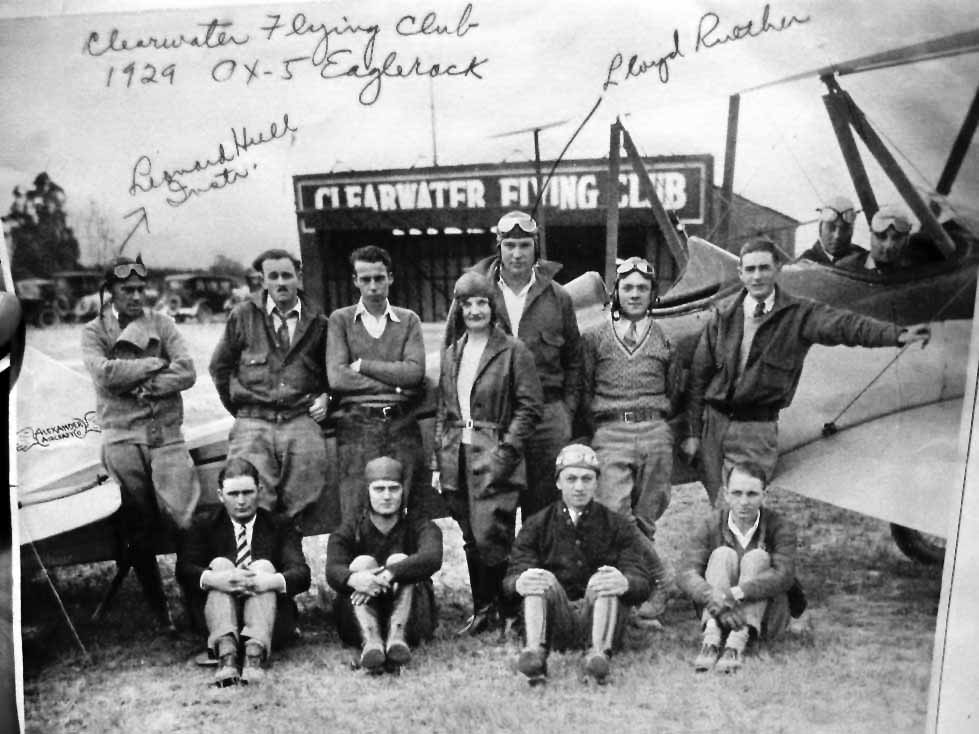
The only ground-level photo which has been located of Ardis Airport was a circa 1930s photo (courtesy of Mark Gebert)
of the members of the Clearwater Flying Club in front of their 1929 Eaglerock OX-5 biplane.
Among those pictured was Leonard Hull (instructor) & Lloyd Ruether (airport manager).
A hangar labeled “Clearwater Flying Club” was visible in the background.

The earliest aeronautical chart depiction which has been located of Ardis Airport was on the June 1933 LA Sectional Chart.
It depicted Ardis Airport as a commercial/municipal airport.
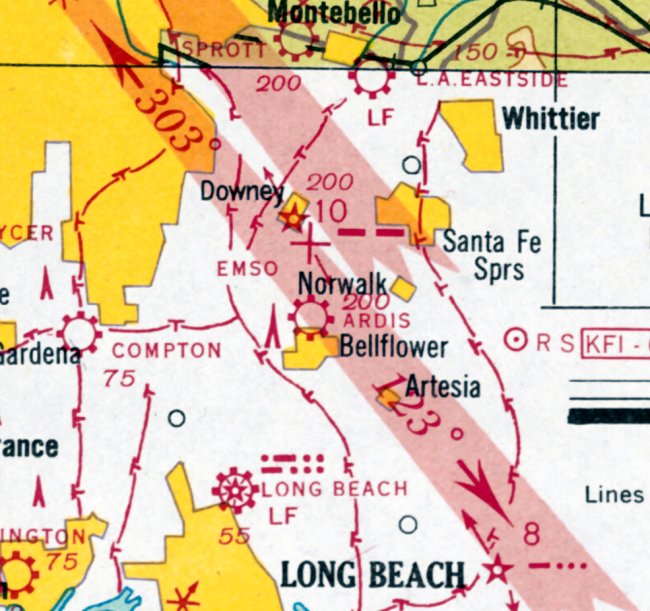
The last aeronautical chart depiction which has been located of Ardis Airport was on the August 1936 LA Sectional Chart.
It depicted Ardis Airport as a commercial/municipal airport.
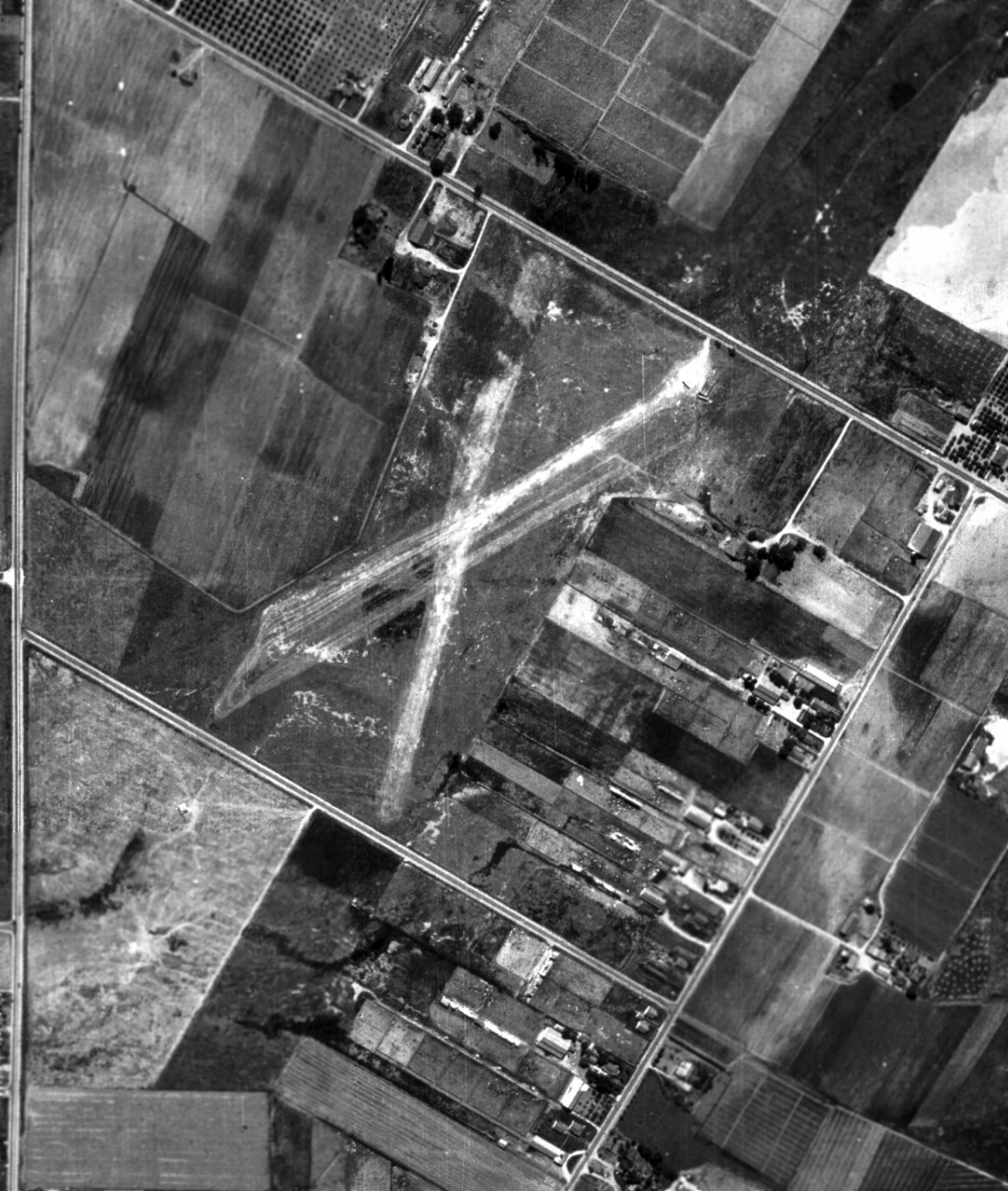
The only dated photo which has been located of Ardis Airport was a 7/2/38 aerial view (from the UCSB Library).
It depicted Ardis Airport as having 2 unpaved runways in an X-shape.
The airport may have already been abandoned by that point, as there were no aircraft visible or other signs of recent aviation use.

The 1939 LA County Airports Map depicted Ardis Airport as having a single northwest/southeast runway.
Ardis Airport was evidently closed (for reasons unknown) at some point between 1936-38,
as it was no longer depicted on the January 1938 LA Sectional Chart.

Ardis Airport was evidently still depicted on the 1942 USGS topo map (the unlabeled propeller symbol),
even though it had evidently already been closed for several years by that point.
Ardis Airport was no longer depicted on the 1943 USGS topo map.
The 1949 USGS topo map showed that Clark Avenue had been cut through the site of Ardis Airport.
A 1952 aerial photo showed that the site of Ardis Airport had been densely developed with housing,
with no trace remaining of the airport.

In a 3/8/11 aerial photo of the site of Ardis Airport, not a trace of the airfield appears to remain.
____________________________________________________
Glendale Airport / Grand Central Air Terminal, Glendale, CA
34.16, -118.286 (North of Downtown Los Angeles, CA)
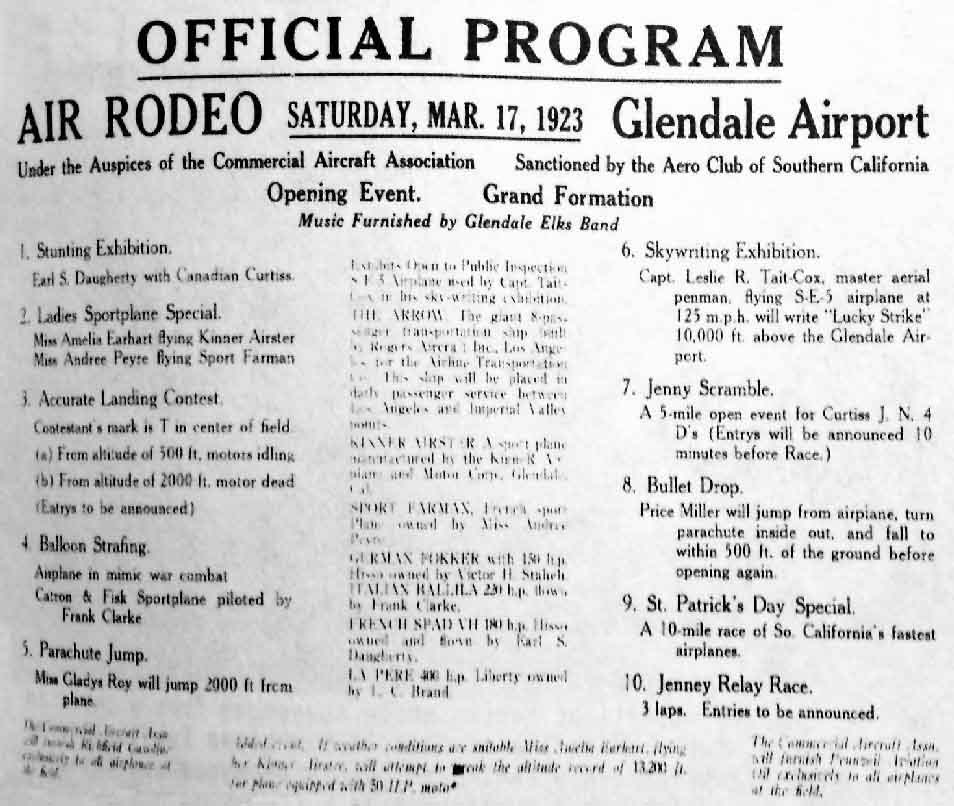
The program for the Air Rodeo commemorating the 3/17/23 dedication of Glendale Airport (courtesy of Ken Morrison).
During the first couple of years of the 1920s, a group of airplane owners made an appeal
to the Glendale Chamber of Commerce to assist them in securing a landing field where private hangars could be erected,
as well as servicing facilities & manufacture of aircraft.
A Chamber committee consisting of approached John D. Radcliffe,
a property owner who had a 33 acre site south of the Southern Pacific right-of-way
and at the southern end of Grandview Avenue (now where the Golden State Freeway and Ventura Freeway meet) about purchasing his property.
The site was purchased in 1922 for $66,000.
The city immediately began clearing the land & built a paved runway (which was very elaborate for an airport of that time).
However, their ownership of the property was short-lived due to a threatened lawsuit.
The sponsors of the threatened lawsuit put together a syndicate & took control of the airport,
paying the city in full for all funds already paid out.
Shortly thereafter, private hangars began appearing.
Glendale Airport was dedicated on 3/17/23 with an “Air Rodeo” (according to a program courtesy of Ken Morrison).
The first hangar to be constructed at the airport, labeled rather pretentiously as the Kinner Airplane & Motor Corporation,
was a mom & pop enterprise financed on a shoestring.
Bert Kinner had yet to build a successful airplane engine,
but his sprightly little biplane quickly captured the fancy of a tomboy called Amelia Earhart.
The management of the airport was placed under the direction of Maj. C. C. Moseley, one of the founders of Western Air Lines
and also the commander of the Air National Guard unit at Griffith Park Aerodrome (across the LA river from Grand Central).
For airport expansion, new capital was needed, so the remaining 20 acres were sold to Edward Spicer,
who started a new development on the property.
He purchased additional acreage until there was about 175 acres,
on which he erected permanent buildings & increased the airport's industrial use.
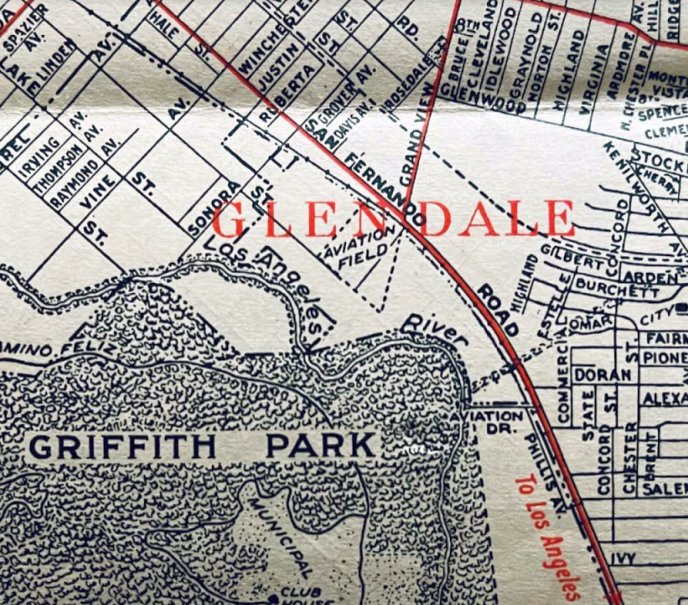
The earliest depiction which has been located of Glendale Airport was on 1924 Security Bank map (courtesy of Kevin Walsh), which depicted a regular generically labeled “Aviation Field”.
Glendale Airport was depicted on a circa-1925 LA-area airfields from Ross Diehl's Air National Guard yearbook (courtesy of Dan MacPherson).
In 1925, Thomas Slate leased space adjacent to the south side of the Glendale Airport for the construction of an all-metal dirigible,
a very novel (but ultimately unsuccessful) design.
The dirigible was made out of duralumin & was filled with hydrogen.
It was forecast to have a cruising speed of 80 mph & would accommodate 40 passengers & 5 crew.
The dirigible was to be powered by oil & driven by steam-turbine,
using one rotary blower, which would create a vacuum, instead of traditional propellers.
Slate also constructed a metal hangar, the largest built in the United States at the time.

The earliest photo which has been located of Glendale Airport
was a 7/12/27 aerial view looking southeast, showing the field in an early configuration with a smaller border, with a peach orchard forming the northern border.
The Slate Aircraft Corporation dirigible hangar is visible on the south side of the field,
and Griffith Park Airport is visible across the river.
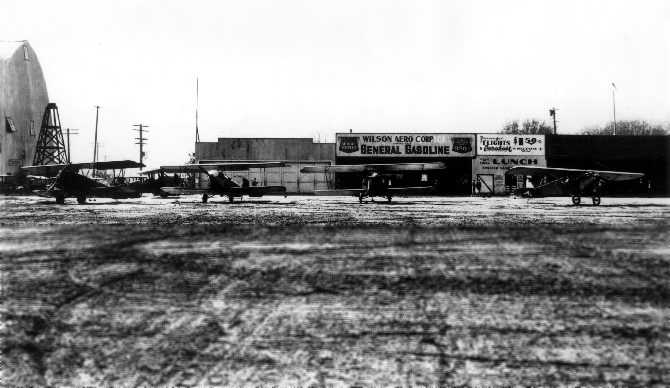
A 1927 photo of Glendale Airport showed unidentified biplanes & 1 monoplane in front of the Wilson Aero Corporation hangar,
with the Slate Aircraft Corporation dirigible hangar also visible on the left.
Will Adams recalled, “I grew up on Glendale & was 10 years old in 1927.
My stomping ground was the Grand Central Air Terminal area, which included the LA River, and the dirigible hangar.”
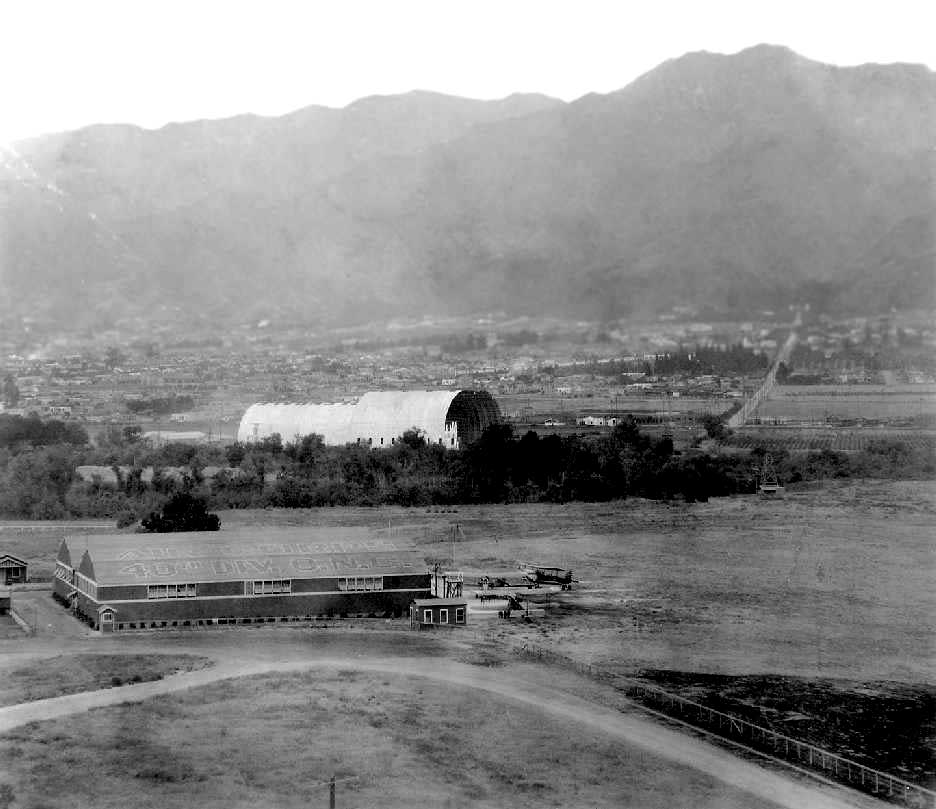
A 1927 aerial view looking northeast, with the National Guard hangars at Griffith Park Airport in the foreground,
and just across the river in the immediate background is the Slate dirigible hangar at Grand Central Air Terminal.
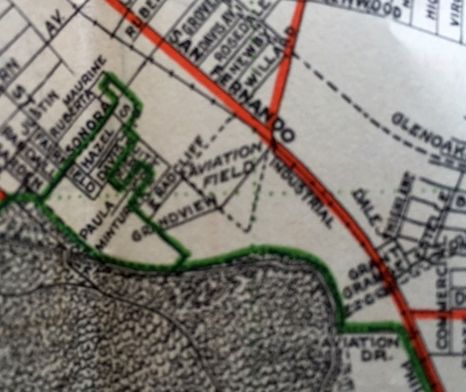
Glendale Airport was depicted on a 1927 Security Bank map (courtesy of Kevin Walsh)
as an irregularly-shaped “Aviation Field”, considerably smaller than the airfield's eventual size.
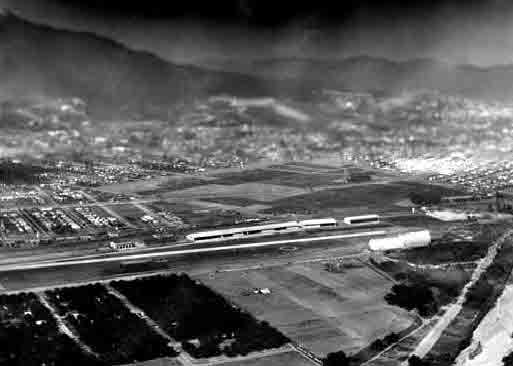
A pre-1928 aerial view looking east at Glendale Airport, showing the Slate dirigible hangar, and the row of hangars on the east side of the runway.

An undated aerial view of Glendale Grand Central Terminal from a LA Chamber of Commerce brochure
“Los Angeles County Spreads Her Wings, History of National Air Races, 1928” (courtesy of Tom Heitzman).
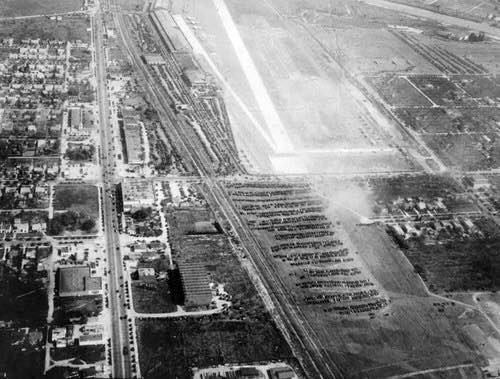
A circa 1920s aerial view looking at Glendale Grand Central Air Terminal during an Armed Forces Day event (courtesy of Kevin Walsh),
with a large number of cars parked to the north of the runway (foreground of picture).

Glendale Airport, as depicted among an amazing total of 55 LA-area airports on a map from an LA Chamber of Commerce brochure
“Los Angeles County Spreads Her Wings, History of National Air Races, 1928” (courtesy of Tom Heitzman).
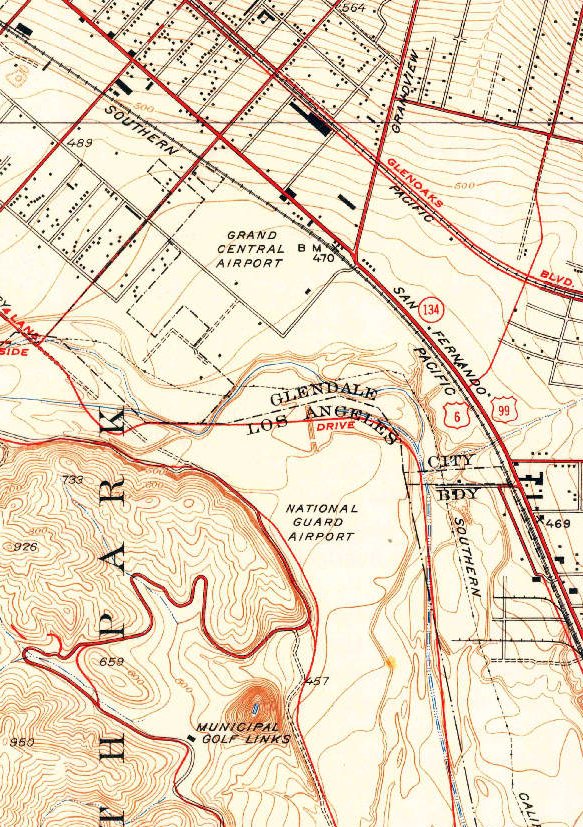
The 1928 USGS topo map depicted “Grand Central Airport” as an open area without any specific runways.
It also depicted the nearby Griffith Park “National Guard Airport” to the south.

A 1928 aerial view looking northeast at Gelndale Airport, with the runway & hangar under construction, and a biplane on the left side.
In the late 1920s, a concerted effort was mounted to establish a proper municipal airport for the Los Angeles area.
Several sites were considered in the southern California area, including Glendale.
Sensing a good opportunity, Captain Charles C. Spicer, a World War I fighter pilot,
formed a syndicate of venture capitalists in 1928, to purchase the Glendale Municipal Airport & develop it further.
The airport was to be an airline terminal from the outset & the architect planned accordingly.
The Grand Central Air Terminal with its control tower was designed by architect Henry Gogerty.
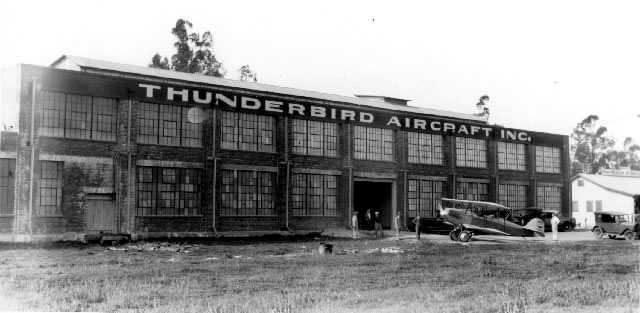
A 1928 photo of an unidentified biplane in front of the factory of Thunderbird Aircraft Inc.,
which had been established in 1927 at 900 Allen Avenue, only 2 blocks northwest of Grand Central Air Terminal.
Cliff & Phil Henderson operated a Thunderbird sales office at Grand Central Air Terminal.
The company produced a few examples of their H-14 biplane before ceasing production in 1929.
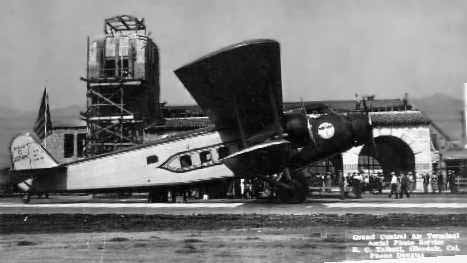
A 1928 view looking northeast at a Boeing 80-A with Glendale's Grand Central Air Terminal under construction in the background.
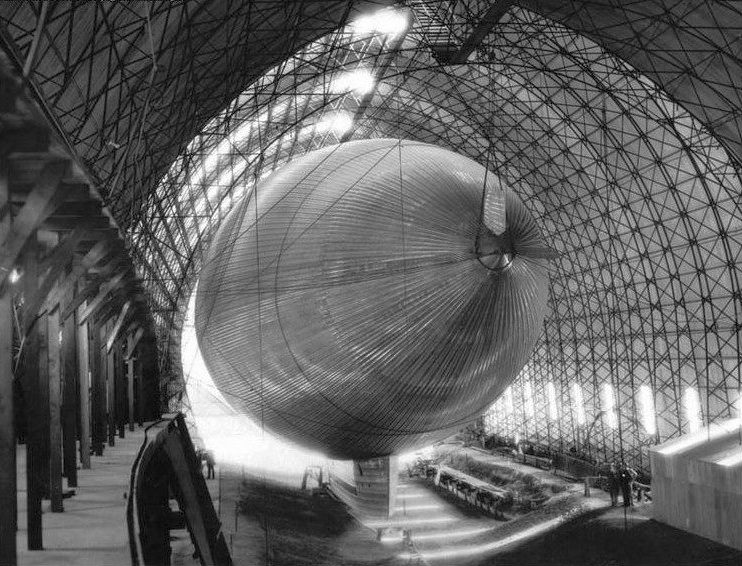
A 1928 interior view of the Slate dirigible inside its hangar at Glendale Airport.

A 1928 photo of the Slate dirigible outside its hangar at Glendale Airport.

A 1928 view looking south along the Grand Central hangars, with several biplanes visible.

A 1928 photo of a Western Air Express Fokker F.10 NC4458 C/n 1000 in front of the Grand Central terminal.
In 1929 the Grand Central Air Terminal facility was sold to Curtiss-Wright for about $2,000,000.

The earliest aeronautical chart depiction which has been located of Grand Central Air Terminal was on the 1929 LA – Las Vegas Air Navigation Map.
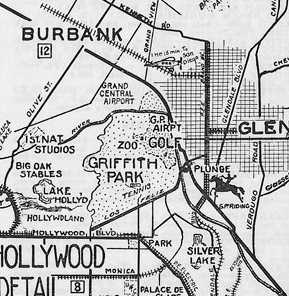
Grand Central Airport, as depicted on 1929 LA County map (courtesy of Mark Shoemaker).
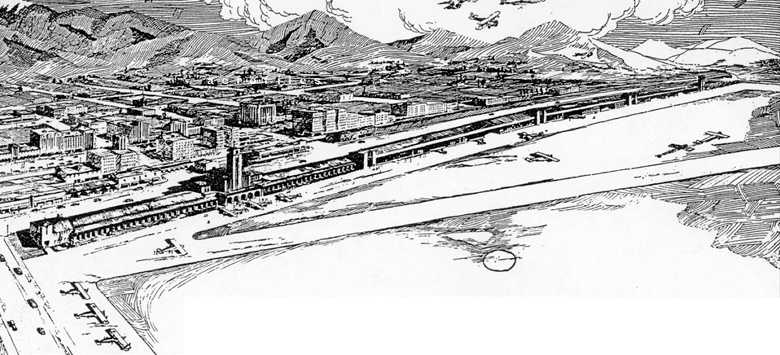
A 1929 sketch showing Grand Central Air Terminal as planned when fully completed.
The plans were mostly realized, with the exception of the buildings on either end.
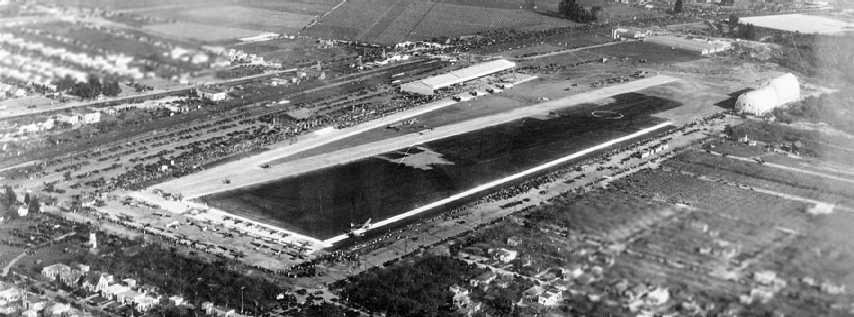
A 1929 aerial view looking southeast at Grand Central Air Terminal, presumably during its dedication.
Note the Slate Aircraft Corporation dirigible hangar at the top-right.
Hundreds of cars can be seen parked near the runway at left, and a large number of planes are parked on the north end (left side of photo).
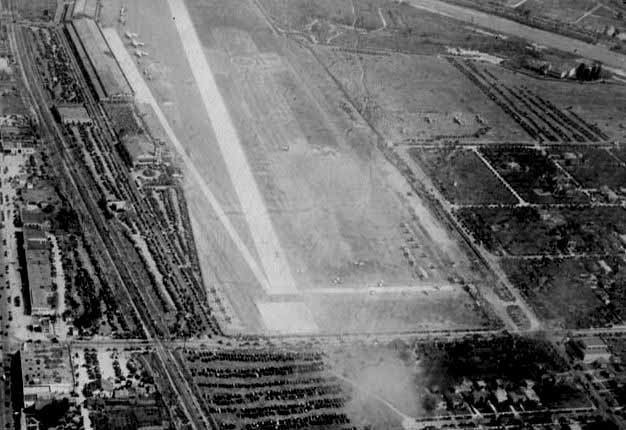
A circa late 1920s aerial view looking south at Grand Central on U.S. Army Air Force Day.
Planes are parked in front of hangars & on the field, and a large number of cars are parked on a field in the foreground.
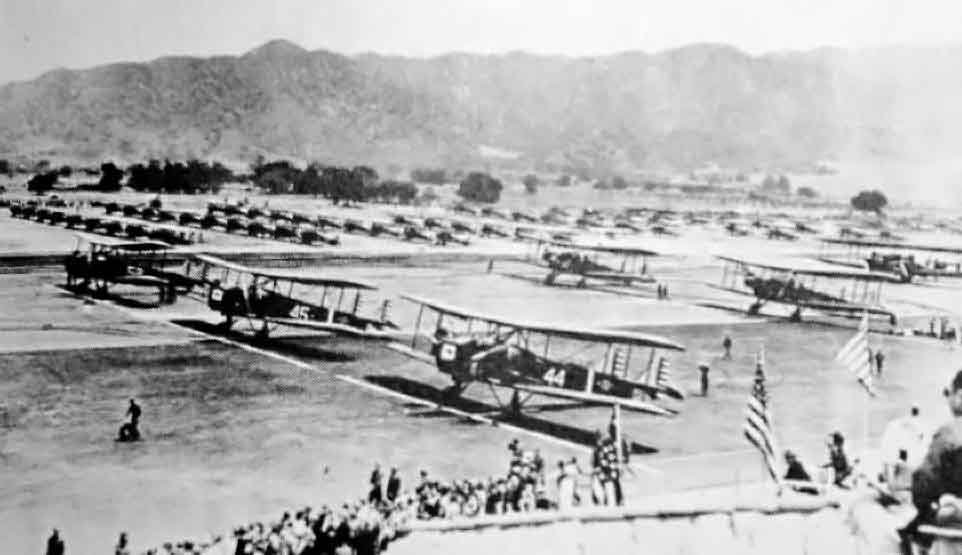
A huge fleet of military aircraft participated in the dedication of Grand Central Airport on 2/17/29 (courtesy of Ken Morrison).
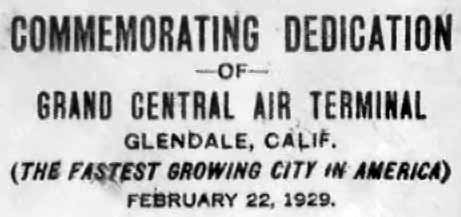
A postmark commemorated the 2/22/29 Dedication of Grand Central Air Terminal.
Grand Central Air Terminal's official opening on 2/22/29 was a gala affair.
The Hollywood film colony turned out in force, many of its luminaries arriving in their own planes.
Wallace Beery arrived piloting his own Travelair. Other attendees included Hoot Gibson, Gary Cooper, and Jean Harlow.
The first airline service from Southern California to New York was from Grand Central, piloted by Charles A. Lindbergh.

A circa 1929 photo of a group in front of Grand Central's Slate dirigible hangar.
Originally captioned: “Glendale - Photo shows Captain T.B. Slate designer & builder of the first steam-driven all-metal dirigible 'City of Glendale' on his arrival at the hangar.
Members of the crew of the revolutionary craft are shown with a tiny model of the ship which is being readied for its first flight."
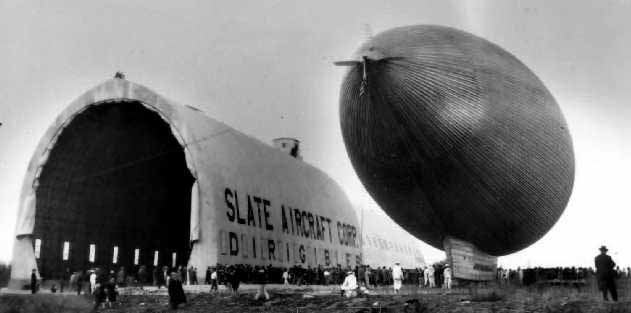
A 1929 photo of the Slate Aircraft Corporation dirigible hangar & the “City of Glendale” metal airship at Glendale.

A 1929 photo of the City of Gelndale Slate dirigible outside its hangar at Glendale Airport.
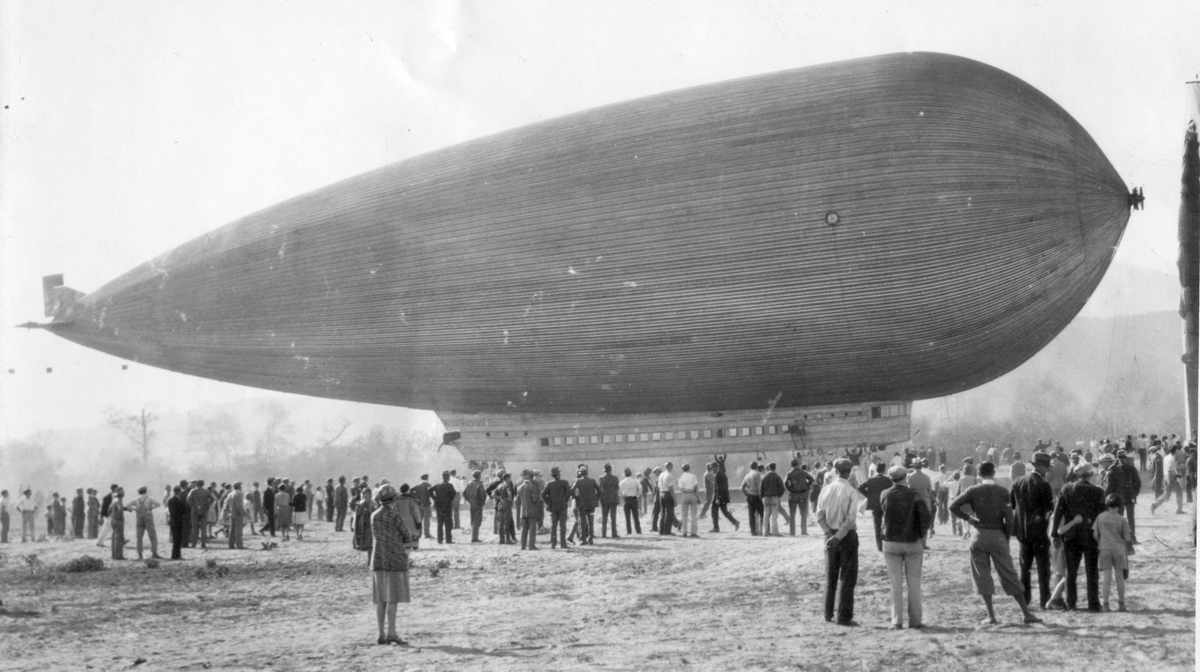
A circa 12/17/29 photo of the City of Gelndale Slate dirigible in its final configuration outside its hangar at Glendale Airport.
Slate's dirigible, christened the "The City of Glendale", became finally airborne in 1929 at Grand Central, after 2 unsuccessful attempts.
However, because of pressure build-up from a stuck fuel intake valve the dirigible's rivets popped.
The huge vessel collapsed on the ground & was put back in its hangar, where it gathered dust.
Slate lost his own fortune (along with the funds of others) in these unsuccessful efforts,
and he never attempted to build another dirigible, thus ending a curious chapter in the Grand Central history.
According to Joe Handelman, “Kreutzer built Air Coaches (Tri-motors) at Grand Central Air Terminal in the late 1920s & early 1930s.”
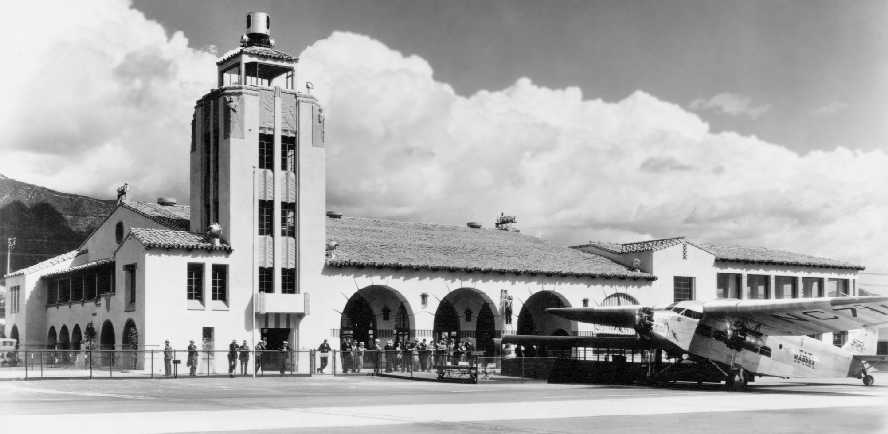
A circa 1920s-30s photo of a Ford Trimotor in front of the Grand Central Air Terminal.
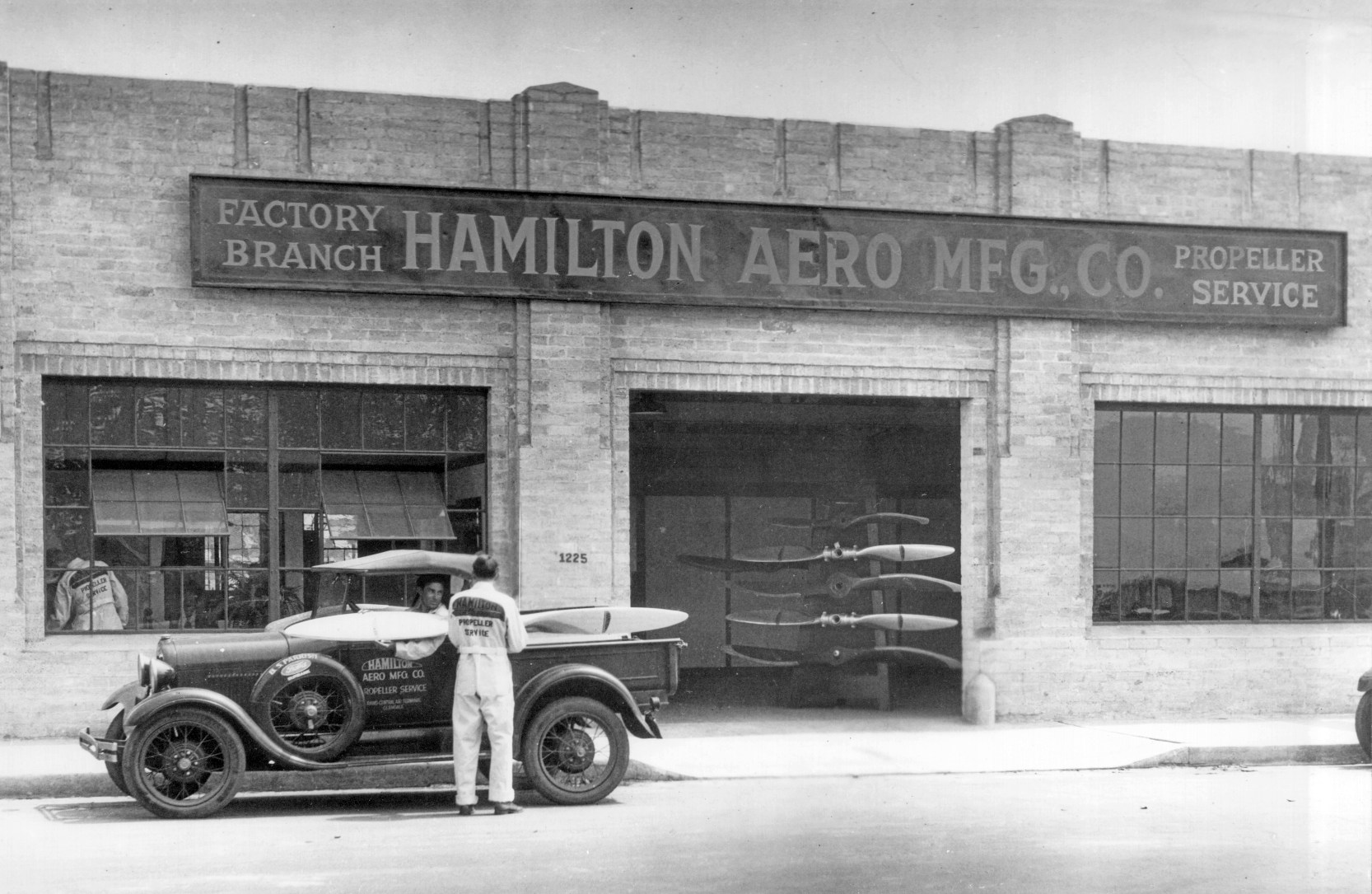
A circa 1920s/30s photo of a delivery truck painted “Hamilton Aero Mfg Co. - Propeller Service - Grand Central Air Terminal - Glendale” in front of the Hamilton Aero Manufacturing Company building
(courtesy of Andrew Smith, who obtained the photo at an auction, “among a few items reported to have come from the estate of a Pratt & Whitney executive”).
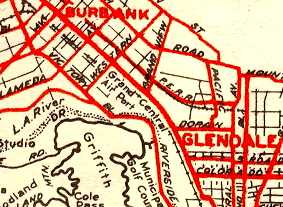
Grand Central Airport, as depicted on a 1930 street map (courtesy of Gary Alexander).

A 1930 photo of a Ryan monoplane (model undetermined) landing behind Grand Central Airport's “Airplane crossing” sign (courtesy of the Glendale Library).
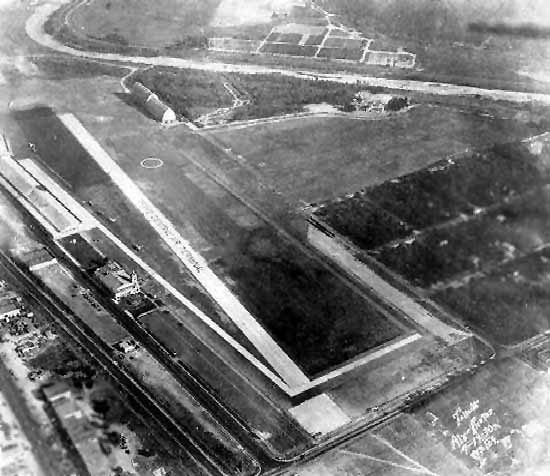
A 7/19/30 aerial view looking south at Grand Central Air Terminal.
Note the Slate Aircraft Corporation dirigible hangar at the top-left.
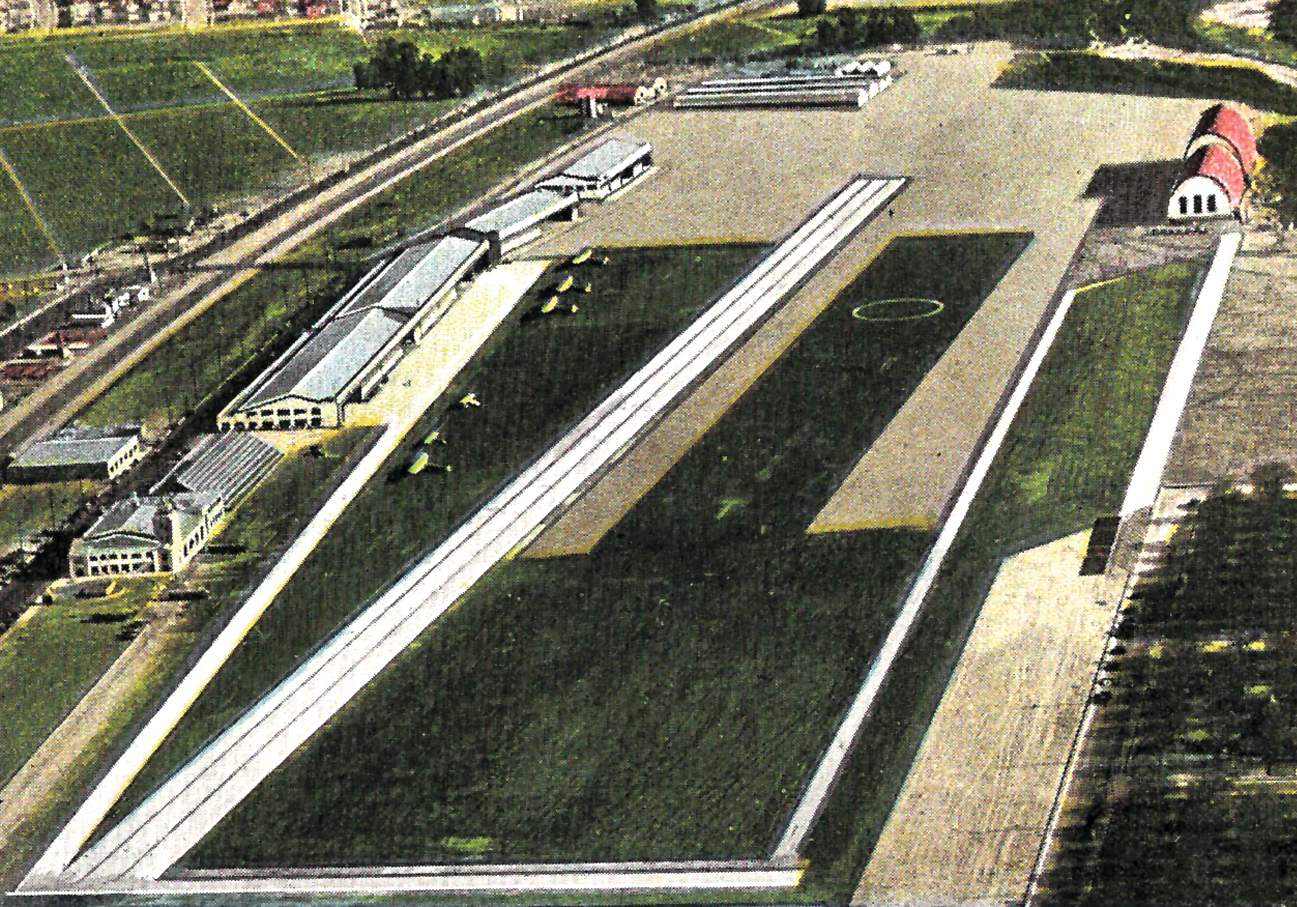
A circa 1930s colorized aerial view looking southeast at Grand Central Air Terminal, with the Slate Aircraft Corporation dirigible hangar at top-right.

A circa late 1920s aerial view looking north at Grand Central Air Terminal, showing the Slate Aircraft Corporation's dirigible peeking out of its hangar at left,
and note the airport's name painted along the paved runway.
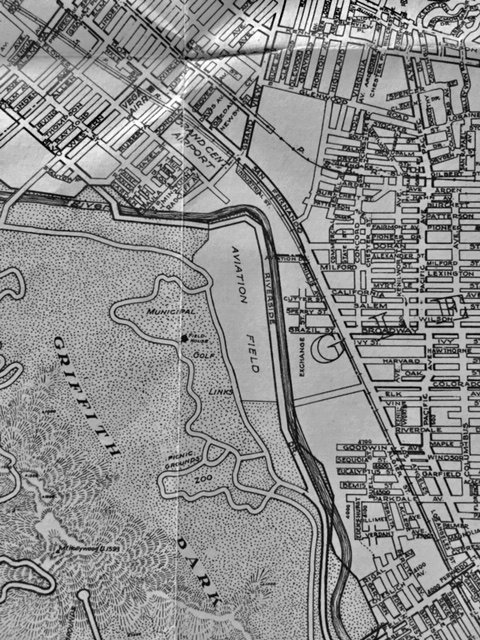
Grand Central Airport was depicted as a small property on a 1930 street map (courtesy of Kevin Walsh).
According to Tom McCart, “My Dad purchased an airplane from Kinner Motors or Airplanes (demoed by sales lady Amelia Earhart) at the Glendale Airport in 1930 or 1931.
The story from my Dad was he purchased the prototype Kinner Security Airster (Security Bank financed the Airster thus the Security part).”
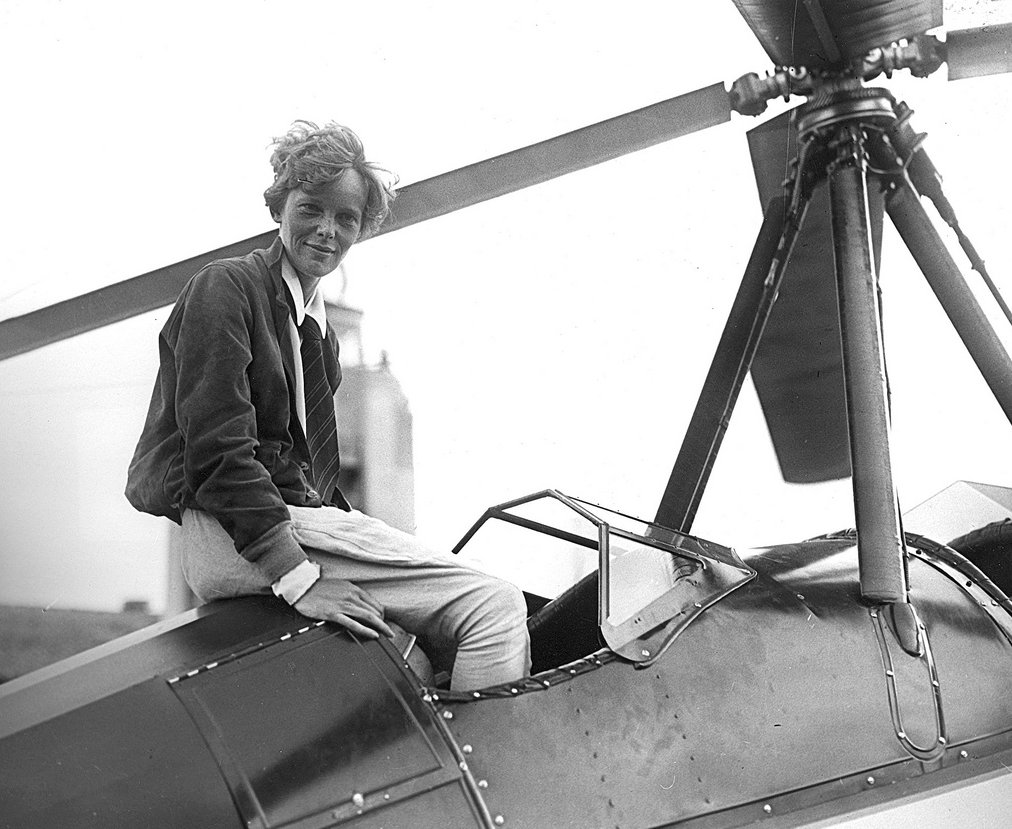
A May 1931 photo of Amelia Earhart arriving with a Beech-Nut Pitcairn PCA-2 autogiro at Grand Central Air Terminal, with its iconic control tower in the background.

A 7/7/31 view of Amelia Earhart with the Beech-Nut Pitcairn PCA-2 autogiro at Grand Central Air Terminal.
Earhart had arrived from PA on what she thought was the first transcontinental autogiro flight, only to discover that Johnny Miller had beaten her by 10 days.
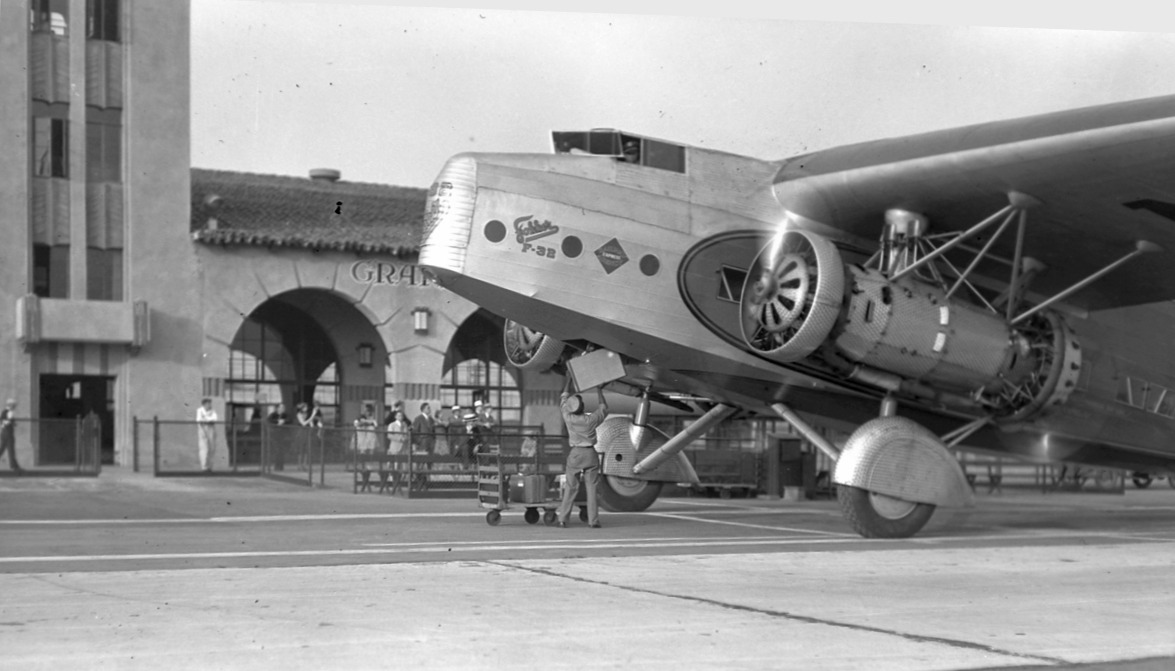
A circa 1930s photo of one of only 2 Fokker F-32 airliners which served Western Air Express, seen in front of the Grand Central Air Terminal.

A 1932 advertisement for the Grand Central's Curtiss-Wright Flying Service featured an undated aerial view looking southeast at the field.
The concrete runway was shown, with a lineup of aircraft parked to its left, and the Slate dirigible hangar was still visible at the top-right.
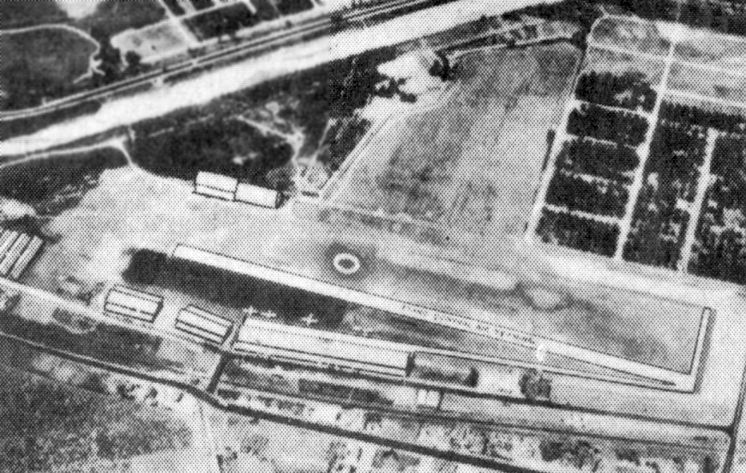
An undated aerial view looking southwest at Grand Central Air Terminal from a 1932 U.S. Navy Aviation Chart (courtesy of Roger Connor).

A 2/28/32 aerial view looking west at Grand Central Air Terminal.
Two small aircraft are parked directly in front of the terminal, and hundreds of automobiles are parked all around the airfield.

The earliest Sectional Chart depiction which has been located of Grand Central Air Terminal was on the June 1932 LA Sectional Chart.

A circa 1932-33 photo of Goodyear's Type TZ airship Volunteer descending steeply for a landing at Grand Central Air Terminal
while T&WA's Fokker F-32 NC-333N taxis up to the terminal.
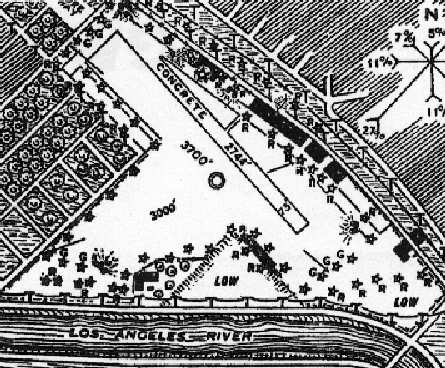
A 1933 airport directory depicted Grand Central
as having a single 2,744' concrete runway, oriented northwest/southeast,
along with a 3,700' parallel grass runway & a 3,000' crosswind grass runway.
The Slate dirigible hangar was still depicted on the south side of the field.
The airport manager was listed as C. C. Moseley.
The operators were listed as Air Associates Inc., Airplane Development Corporation,
American Airways Inc., Max Cornwell, Curtiss-Wright Approved Repair Station, Curtiss-Wright Technical Institute,
G & G Air Lines, Pacific Seaboard Air Lines, Palm Springs Air Lines, and Transcontinental & Western Air.
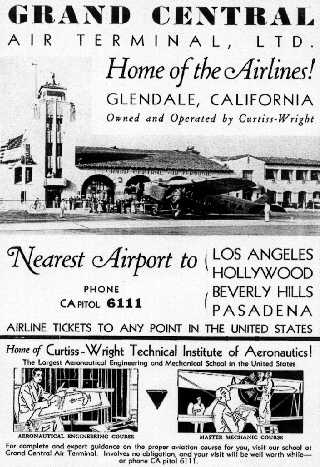
An advertisement from the 1933 National Air Races program proclaimed Grand Central Air Terminal to be the “Home of the Airlines!”
The sole prototype of the new Douglas DC-1,
which dropped in unannounced to the Grand Central Air Terminal on 8/16/33 (courtesy of Dan MacPherson).
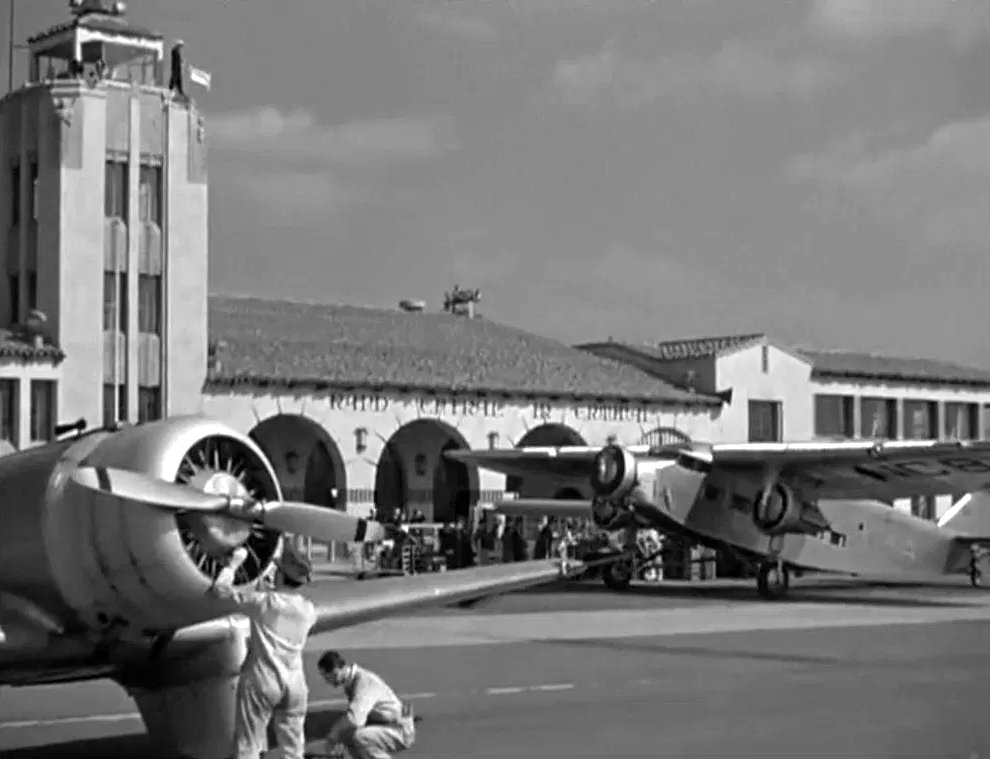
A still from the 1933 movie “Air Hostess” filmed at Grand Central Air Terminal, showing an unidentified single-engine plane & a Ford Tri-Motor,
which in the movie was a TWA flight which had arrived from Albuquerque.
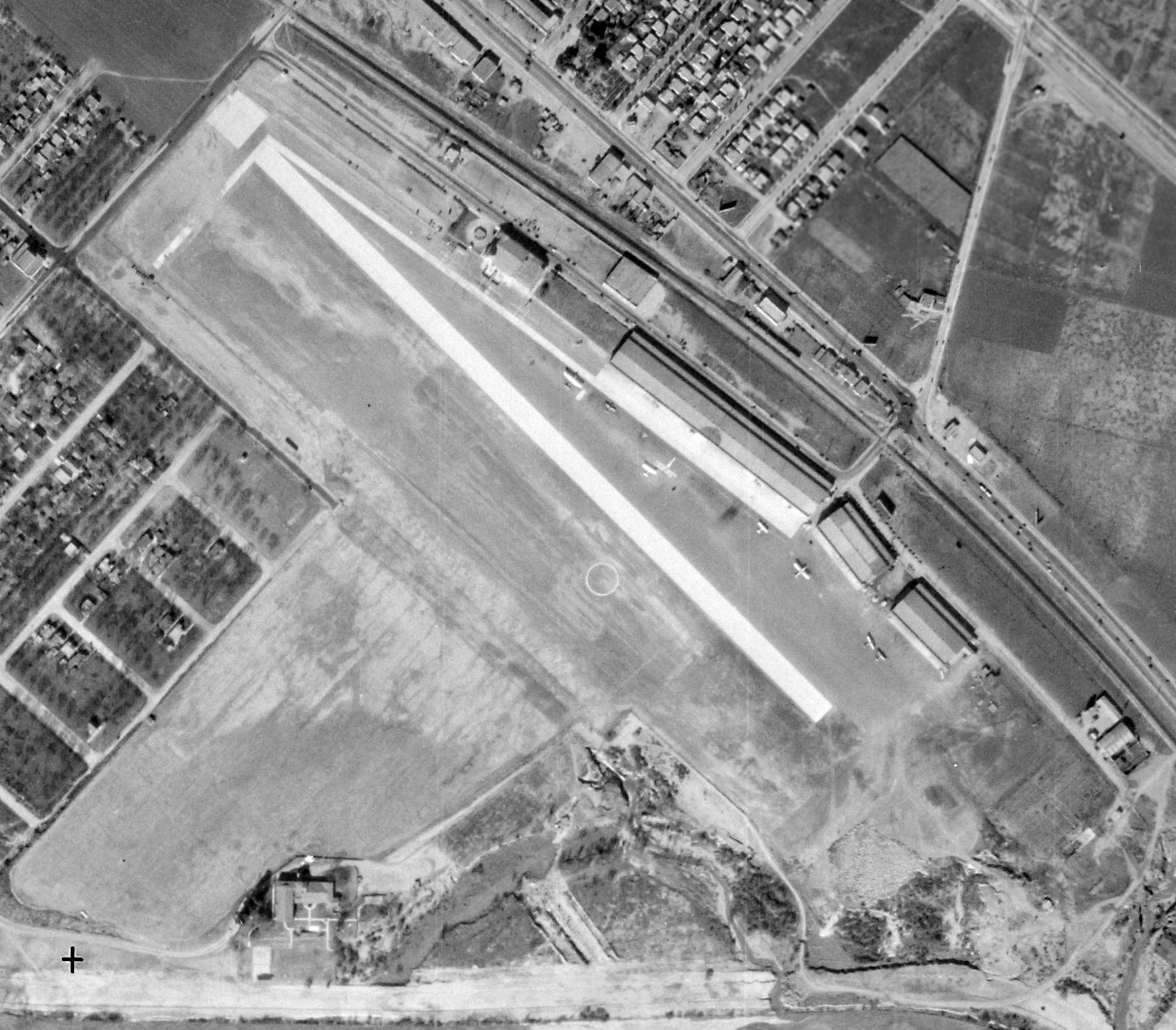
A 1/13/34 aerial view of Grand Central Air Terminal (from the UCSB Library), showing numerous aircraft parked northeast of the runway.
The Slate dirigible hangar had evidently been removed at some point between 1933-34 on the south side.
In 1934, Maj. Moseley leased the field & facilities from Curtiss-Wright, and later purchased the property.
He immediately changed the name of the technical school operated at the airport
from Curtiss-Wright Technical Institute to Cal-Aero Technical Institute.
According to Dan MacPherson, Moseley ran 3 other flight schools from his home base at Grand Central:
the Cal Aero Flight Academy at Ontario (now Chino Airport),
the Mira Loma Flight Academy at Oxnard (now Oxnard Municipal Airport),
and the Polaris Flight Academy at War Eagle Field, Lancaster (now Mira Loma Prison).
Suzanne Gilreath reported, “Grace Huntington took flying lessons in the 1930s from Joe Plosser who ran a flight school out of Glendale Central Air Terminal.
I have heard he was a fixture there. I have also seen an advertisement for his school.
Grace Huntington got her pilot’s license in 1934 or 1937.”

A circa 1934-36 photo of Roscoe Turner's Weddell Williams Racer in front of the Grand Central Air Terminal (courtesy of Dan Rhinehart).
In 1934, wealthy industrialist Howard Hughes leased a small building
owned by Charles Babb at 911 Air Way (on the southeast corner of the airport)
to build his Hughes Special Model A airplane (later known as the H-1 Racer).
Dick Palmer & his staff moved in at the end of April.
Before work began, Hughes (eventually to be infamous for his obsession with secrecy)
had a plywood wall erected around the construction site
and posted an armed guard on duty overnight.
Hughes brought Glen Odekirk from New York to act as shop superintendent & liaison man.
As expenses on the Racer project mounted, and with them the need for more specific accounting,
Howard established the Hughes Aircraft Company as a division of the Hughes Tool Company,
thus marking the beginning of what would eventually become a powerhouse of the American aerospace industry.
The Hughes Racer was finished on 8/10/35,
but it was trucked to Mines Field for its first flight (presumably due to Mines having a longer runway?).
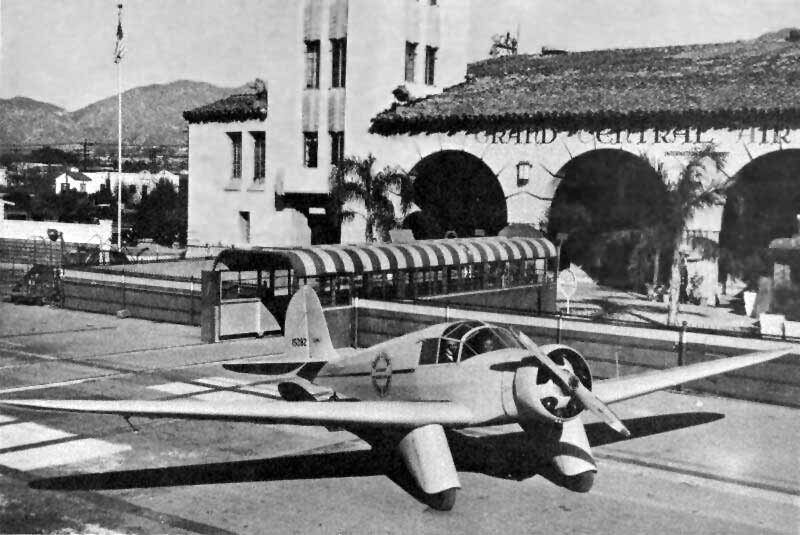
An undated photo (courtesy of Kevin Holcomb) of the 1st production example of the Aeronca LA (which first flew in 1935)
pictured in front of the tower of the Grand Central Air Terminal.
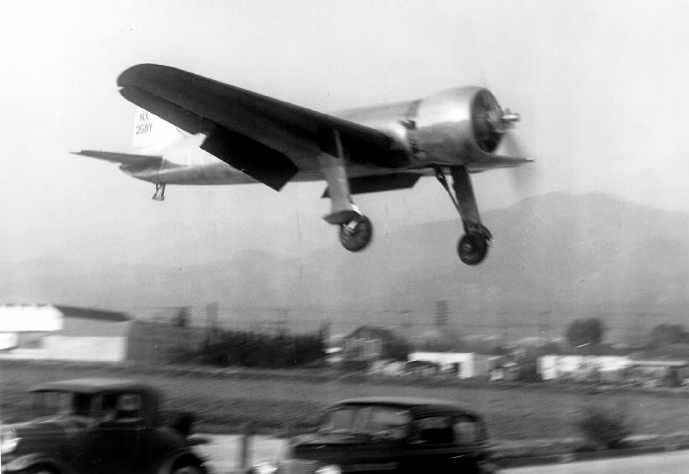
A 1935 photo of Howard Hughes landing the beautiful Hughes Special Model A (later known as the H-1) at Grand Central Air Terminal.
The record-setting H-1 had been built on the southeast corner of Grand Central Airport.

A circa 1930s view of the interior of the Grand Central Air Terminal cafe, showing the Art Deco wall features & an aviation mural.

A circa 1930s photo of an American Airlines Vultee V-1 in front of Grand Central Air Terminal.
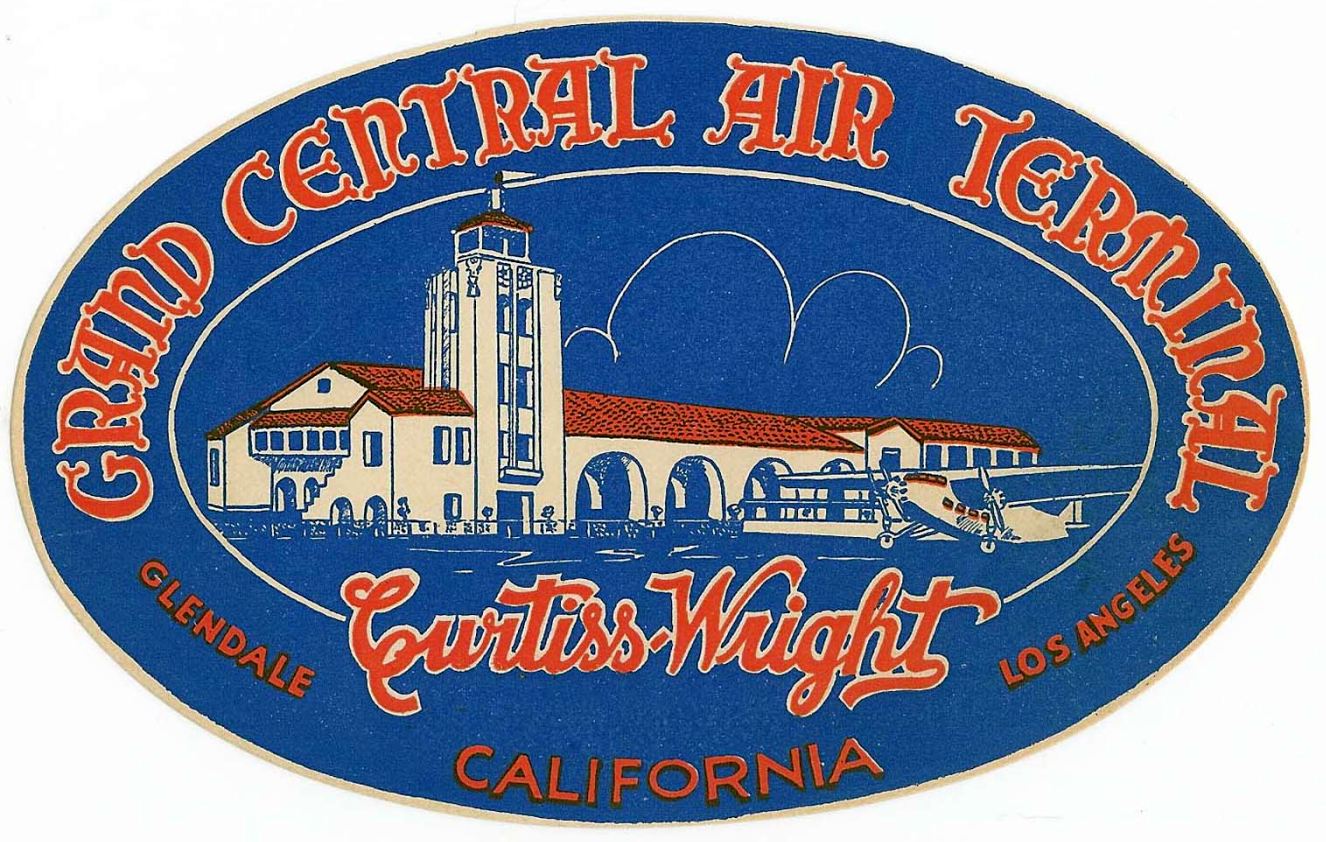
A circa 1930s Grand Central Air Terminal luggage label.
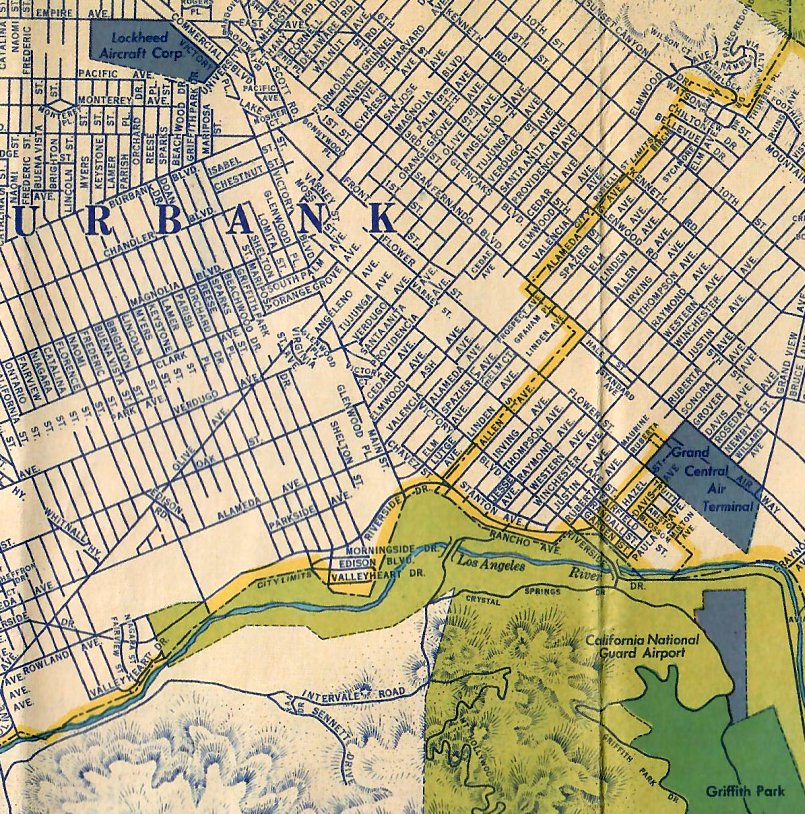
The 1935 H.M. Gousha / Shell Oil LA map (courtesy of Michael Binder) depicted “Grand Central Air Terminal” as an irregularly-shaped property outline.
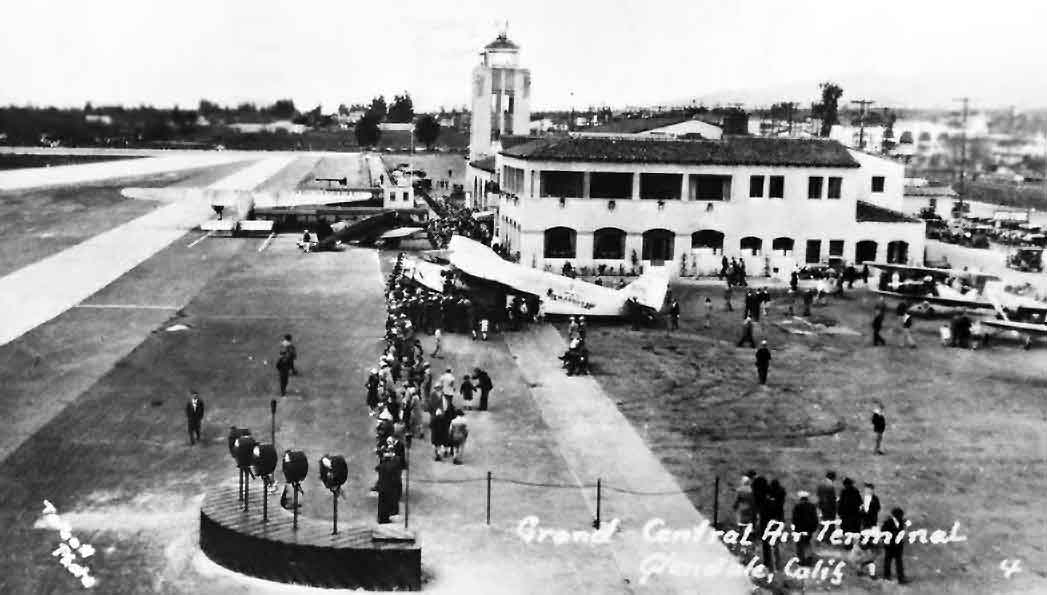
A 1936 photo of an airshow at Grand Central Air Terminal.
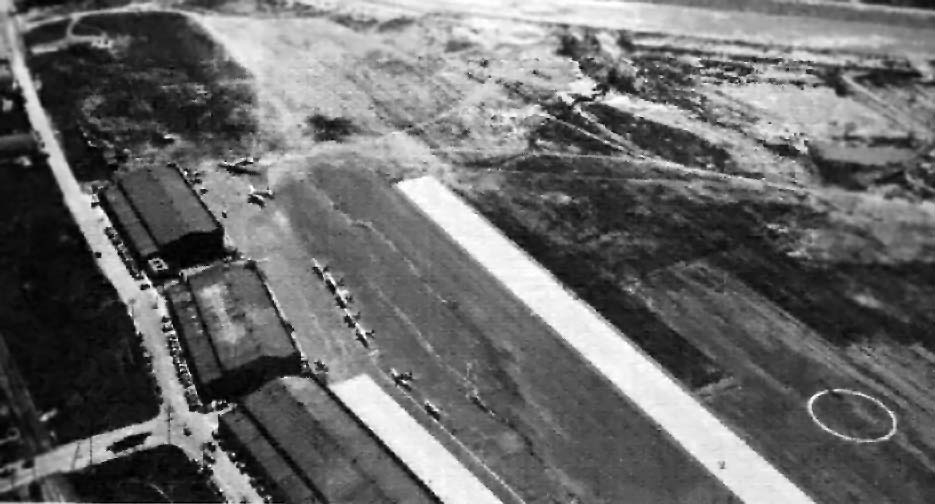
A 1936 aerial photo looking south at the hangars at the southern end of the Grand Central Air Terminal (courtesy of Ross Diehl, via Dan MacPherson).
The 2 southern most hangars (upper 2 hangars in this photo) still exist today,
while the big hangar (the Maddux hangar) no longer exists.
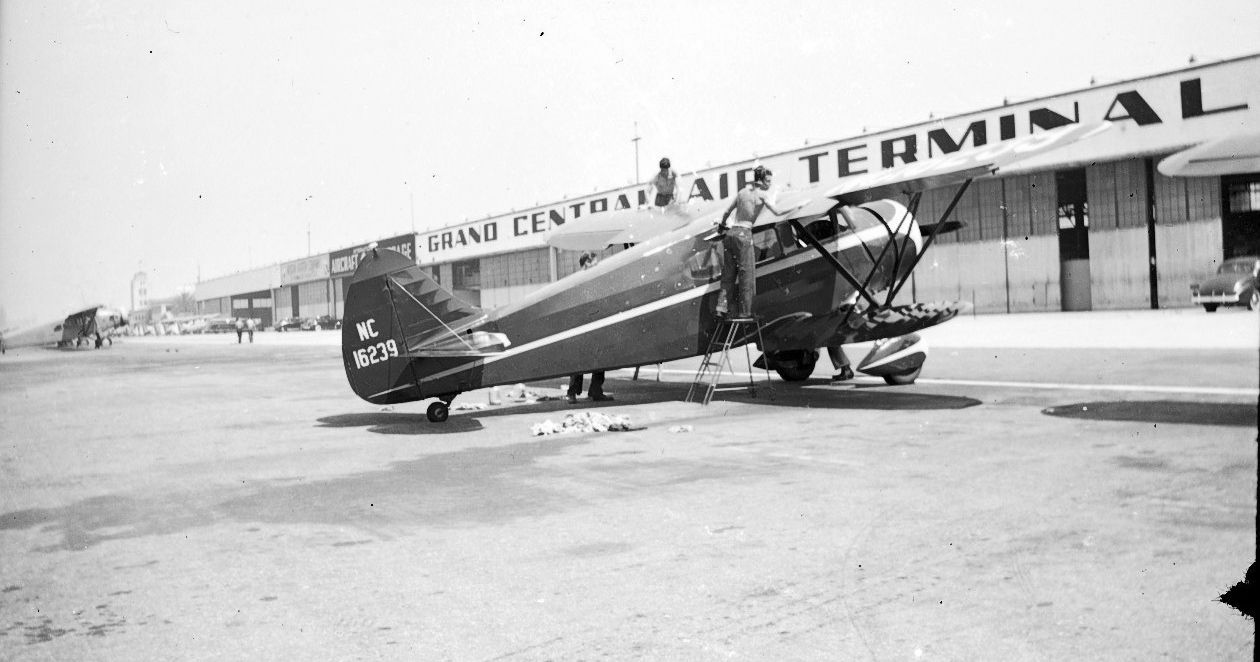
A 1930s photo of NC16239, a Waco ZQC-6, serial #4442 in front of the Grand Central Air Terminal hangars.
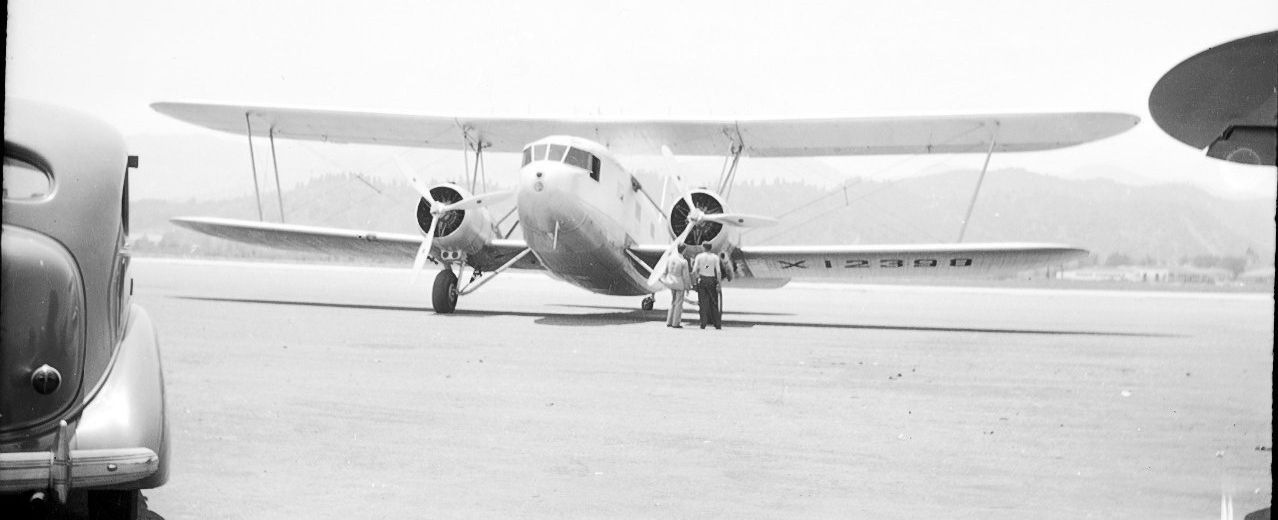
A 1930s photo of N12398, a Curtiss AT-32D Condor, serial #50, at Grand Central Air Terminal.
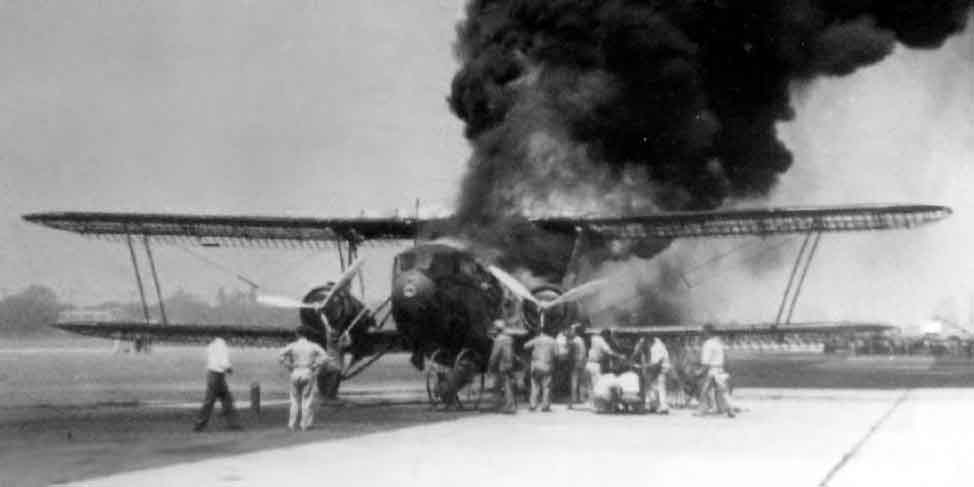
An 8/13/36 photo of an American Airlines Curtiss Condor T-32 NC12353, seen on fire at Grand Central Air Terminal.
Some spilled gas & an engine backfire resulted in the aircraft's doped linen-covered wings catching fire.
The plane was a loss but no lives were lost.

A 1936 photo by John Underwood of the American Gyro AG-4 Crusader prototype NX14429 C/n 101 at Grand Central Air Terminal.
The 4-seat twin-boom metal plane had first flown in 1935 in Denver, but the design was sold in 1936 to Glendale's Timm Aircraft Company.
An aerial view looking north at the Grand Central Air Terminal
from The Airport Directory Company's 1937 Airports Directory (courtesy of Bob Rambo),
showing the paved north/south runway (with several large hangars along its east side),
as well as the unpaved east/west runway.
The directory described Grand Central as having 2 runways,
with the longest being a 3,700' northwest/southeast runway, of which 2,744' was paved.
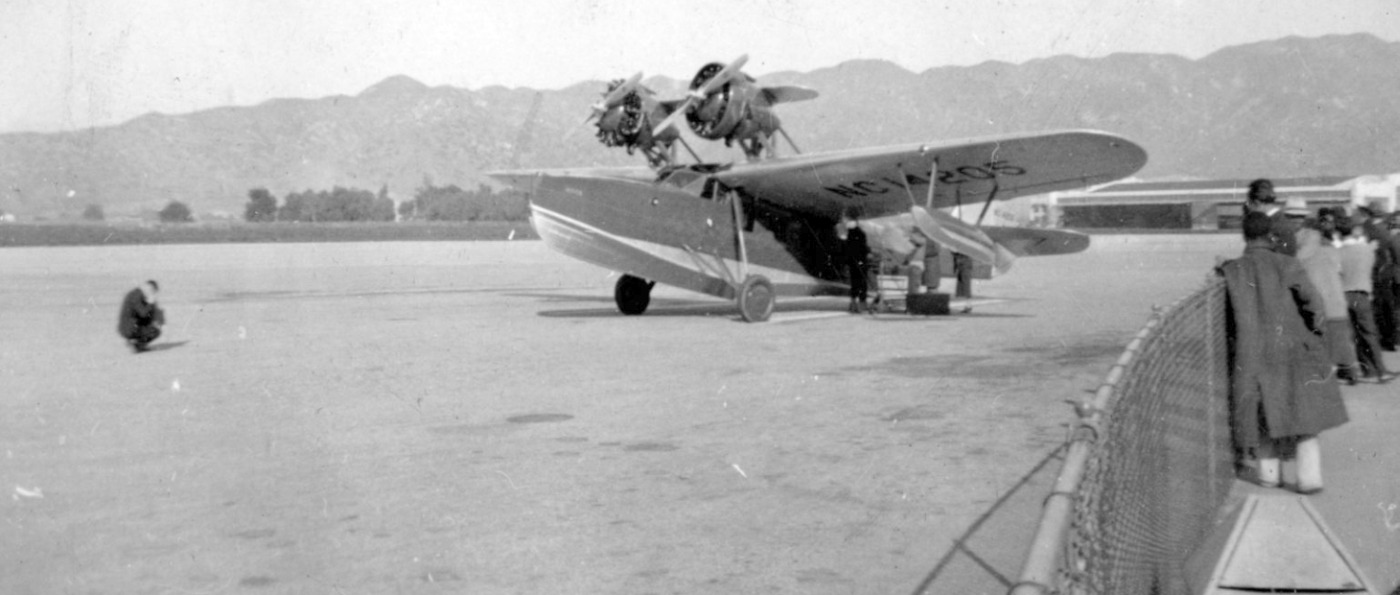
A circa 1930s photo of a Douglas Dolphin amphibian NC14205 at Grand Central Air Terminal.
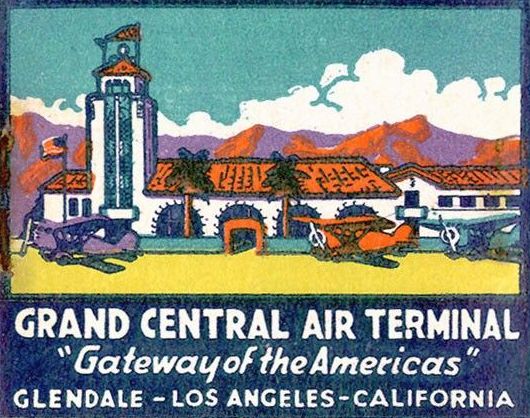
A circa 1930s promotional artwork for “Grand Central Air Terminal, “Gateway to the Americas” (courtesy of Steve Owen).
A vintage advertisement from The Airport Directory Company's 1937 Airports Directory (courtesy of Bob Rambo).
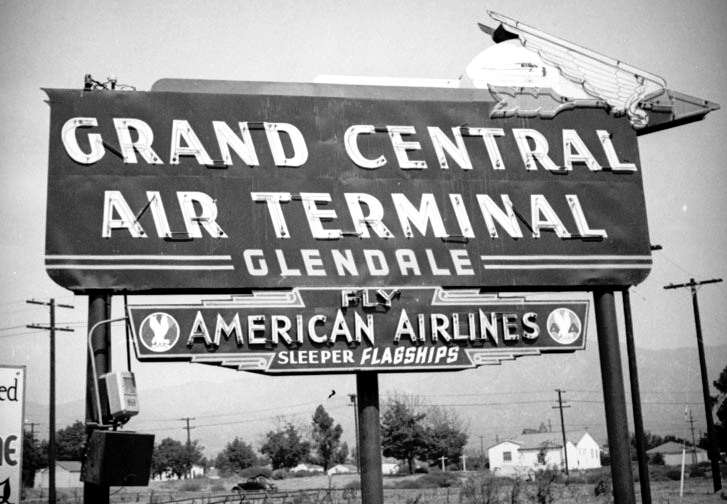
A circa 1937 photo of the sign for Grand Central Air Terminal & its American Airlines service.

A January 1937 photo of the beautiful world speed record holder Hughes H-1 at Grand Central Air Terminal.

A circa 1937 photo of a sign for American Airlines' Grand Central Air Terminal service.

A still of a DC-2 landing at Grand Central from the 1937 movie “Hollywood Hotel” (courtesy of John Schlesinger).
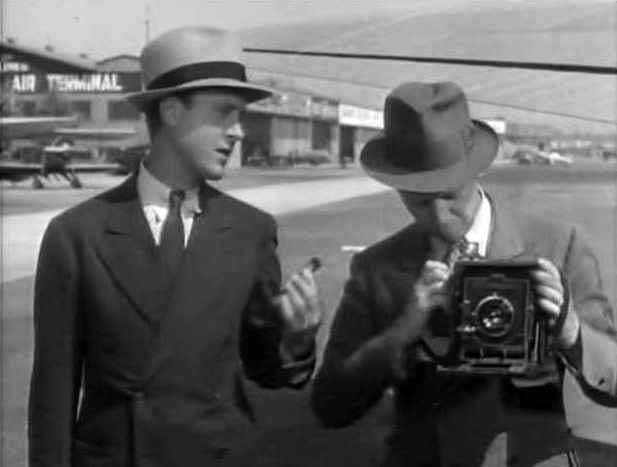
A still of 2 actors in front of a Grand Central hangar from the 1937 movie “Hollywood Hotel” (courtesy of John Schlesinger).
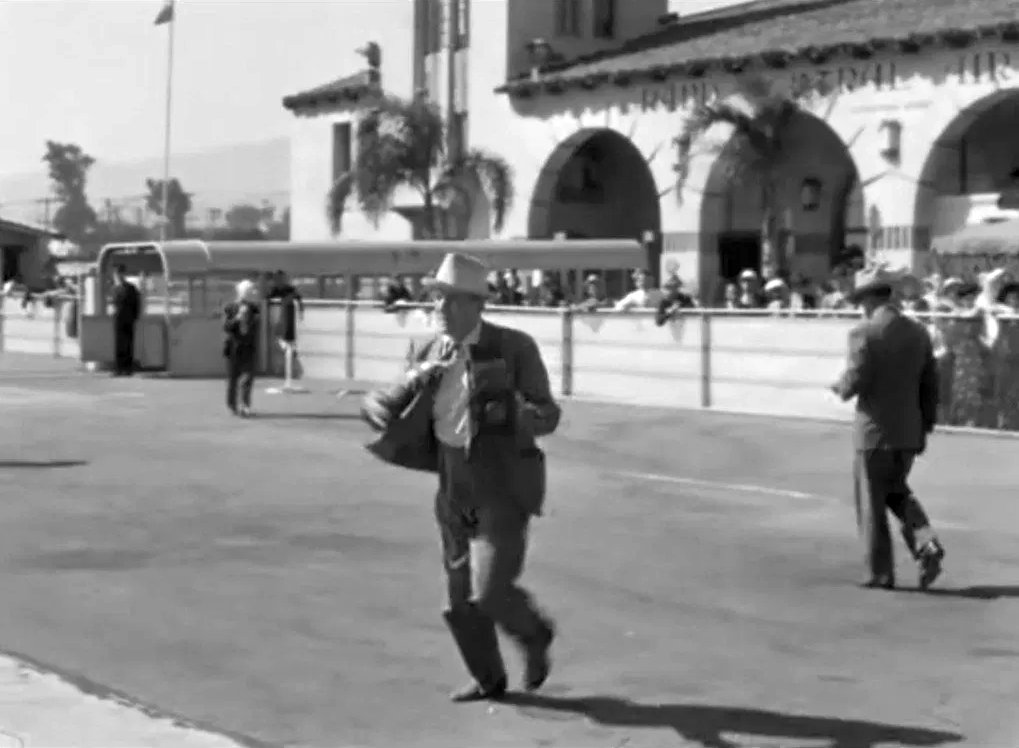
A still from the 1937 movie “Hollywood Hotel” showing saxophonist Ronny Bowers (Dick Powell) arriving at Grand Central Air Terminal.
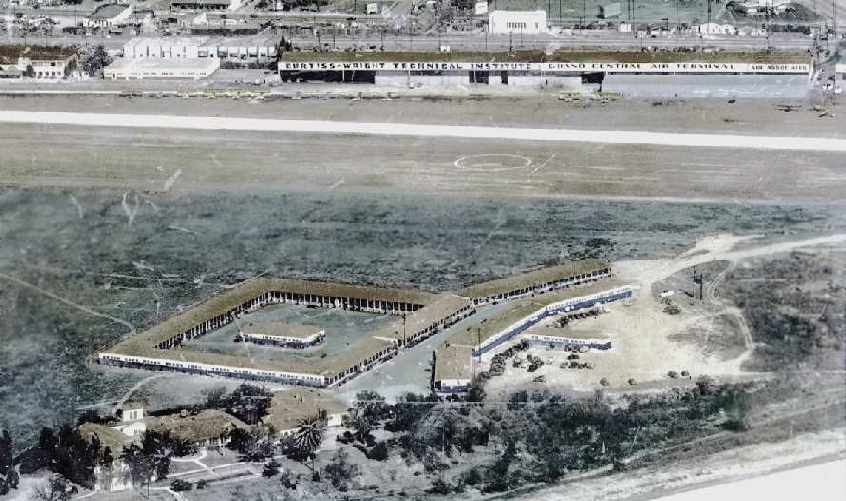
A circa 1937-39 photo (courtesy of the Southern CA Aero Club, via Don Ayres)
showing the buildings of the Cal-Aero Technical Institute (in the foreground)
which had been built at some point during 1937-39 over most of the former crosswind runway.
The hangars of the Curtiss-Wright Technical Institute were visible across the runway in the background.

The logos of the Cal-Aero schools, from an original poster, courtesy of Dan MacPherson.
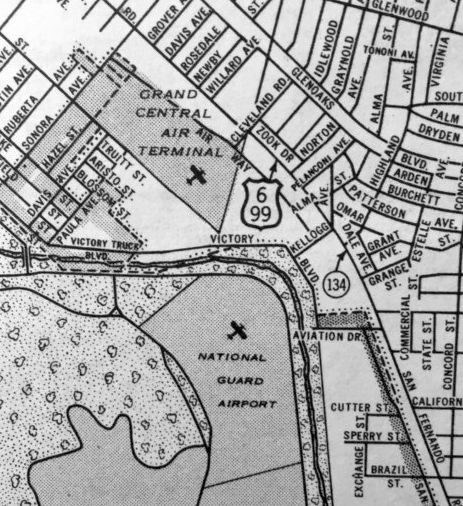
Grand Central Air Terminal & the nearby Griffith Park National Guard Airport, as depicted on a 1938 Rand-McNally Texaco map (courtesy of Kevin Walsh).
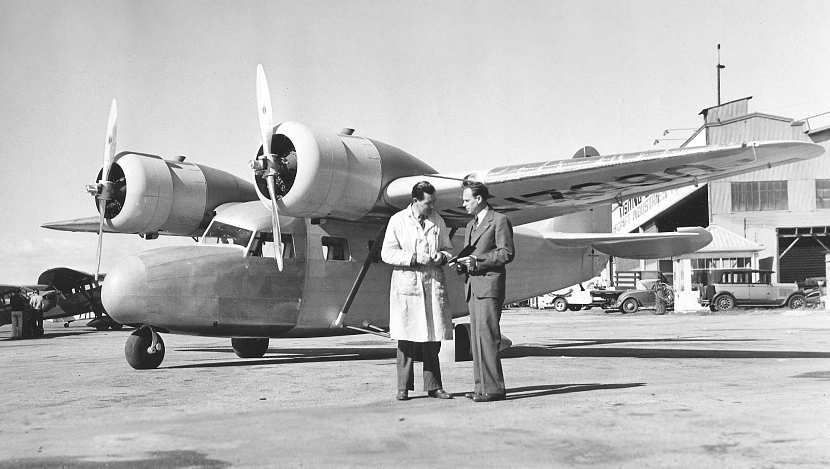
It made its maiden flight on 2/10/38 from Grand Central Air Terminal.

A 1938 photo by Ralph Johnson of the Timm T-840 prototype NX17390 C/n 201, in front of the Timm Grand Central hangar.

Grand Central Air Terminal, as depicted on the 1939 LA Sectional Chart (courtesy of Jon Karkow).
Suzanne Gilreath reported, “Grace Huntington set a series of altitude records. The first one was set on either 5/31/39 or 6/1/39 at Glendale Central Air Terminal.
For Grace’s training & altitude record set at Glendale, she flew her uncle Charles’ Fairchild 24.”
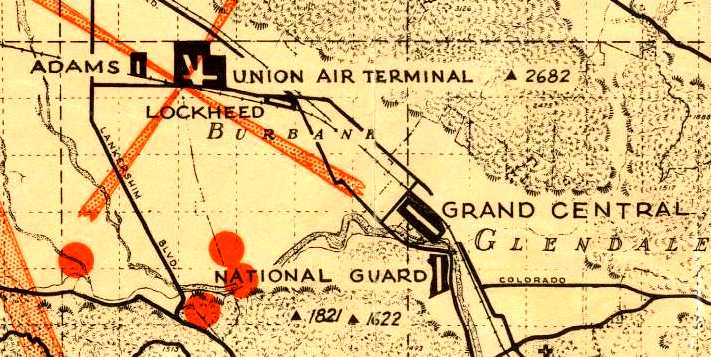
Grand Central Air Terminal, as depicted along with several other nearby airfields on the 1939 LA County Airports Map.
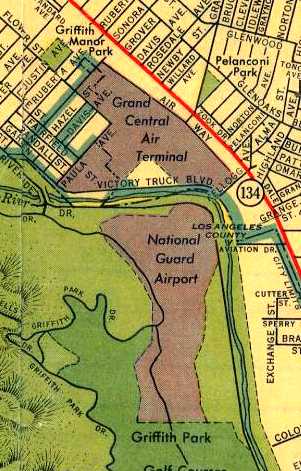
Grand Central Air Terminal & the nearby Griffith Park National Guard Airport, as depicted on the 1939 LA County Airports Map.
Will Adams recalled, “When I joined the Air Corps in 1940, the recruiting office & examining doctor's office were in the Grand Central Terminal building.”
During WW2, TWA had its western terminus at Grand Central.

A circa 1939-43 photo of a very rare & unusual Capelis XC-12 in front of Grand Central Air Terminal.
Mr. Capelis is in front of his plane.
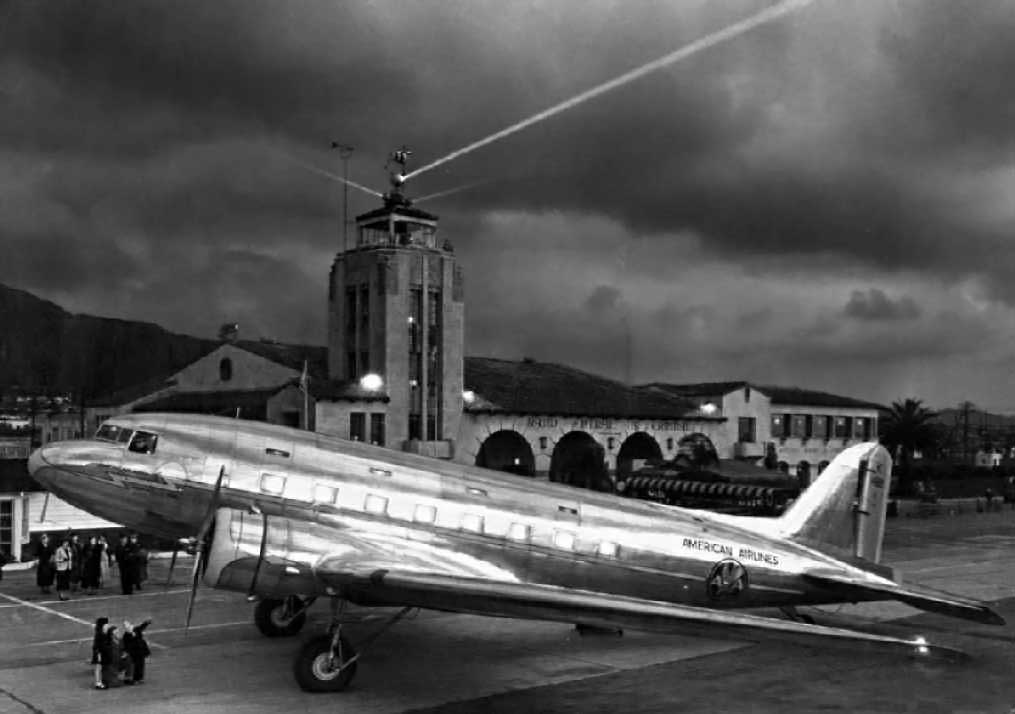
An atmospheric 1940 shot of an American Airlines Douglas Douglas Sleeper Transport DC-3,
in front of the beacon lights emanating from Grand Central's tower.
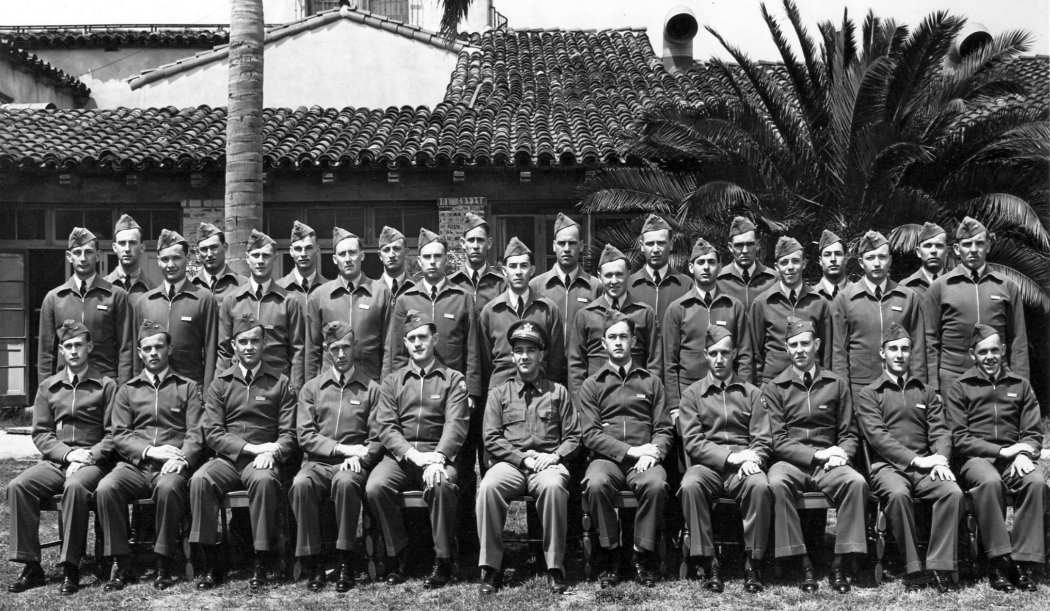
A 3/31/41 photo (courtesy of Patrick Fruedenthal) of Class 41-H of Cal Aero Training Corporation at Grand Central Airport.
Patrick Fruedenthal recalled, “My uncle was a cadet at Cal-Aero in 1941.”
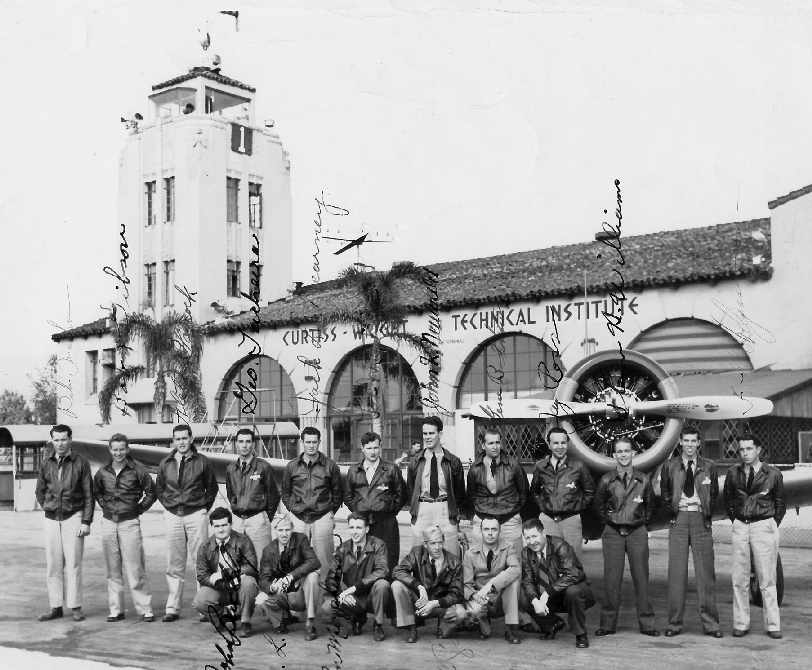
An October 1941 photo (courtesy of Sidney Linton) of Eugene Crane & others
in front of a Vultee BT-13 Valiant trainer in front of Grand Central Air Terminal,
which was marked as the “Curtiss-Wright Technical Institute.”
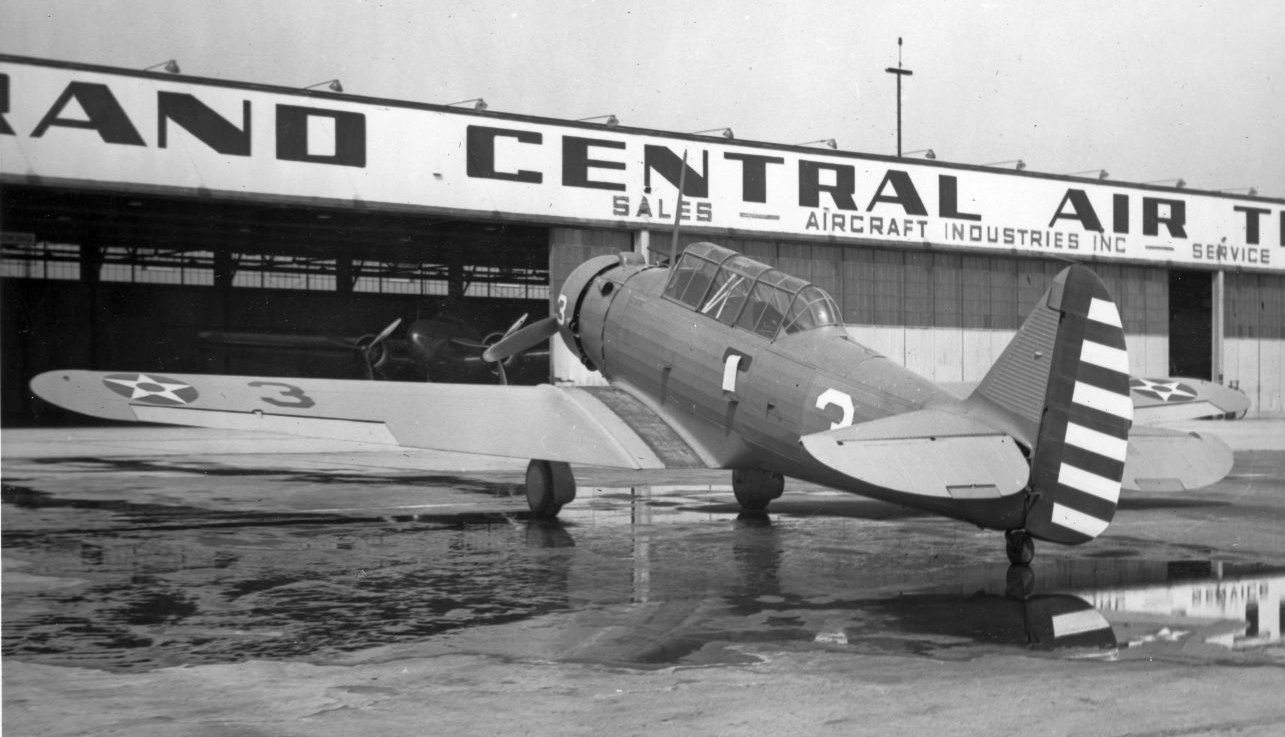
A early 1940s photo of a North American BT-9 trainer in front of the Grand Central Air Terminal hangars.
A squadron of Lockheed P-38 Lightning fighters arrived arrived at Grand Central Air Terminal in February 1942 to augment the air defense of the LA area.
Angelo Rivera recalled, “Curtiss Wright Technical Institute where many of us trained back in the early days of WW2.
Shortly after my induction into service, I was sent to that school where we spent the next 6 months
with instructors learning the whys & wherefores of what made airplanes tick.
It certainly was one great experience for a 19 year old who had never been away from home.
I arrived there in early April 1943, and for the next 6 months it was a lot of schoolwork & not much of anything else.”
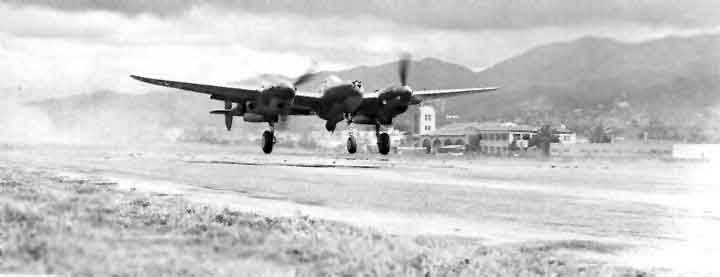
A WW2 era photo of a Lockheed P-38 Lightning fighter taking off, with the Grand Central terminal visible in the background.
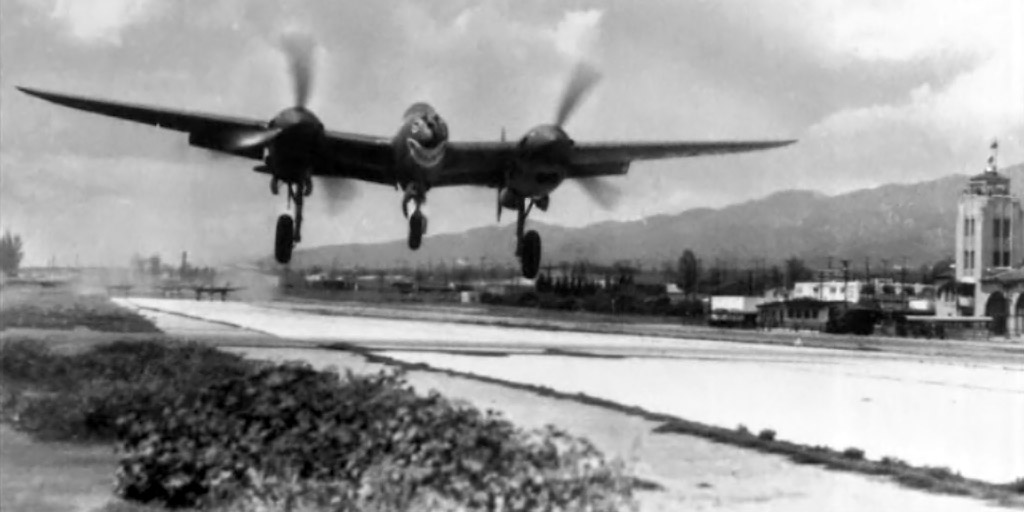
A WW2 era photo of a shark-mouthed Lockheed P-38 Lightning fighter taking off, with the Grand Central terminal visible in the background.

A watercolor by Collin Campbell of P-38 Lightning fighters at Grand Central Air Terminal.
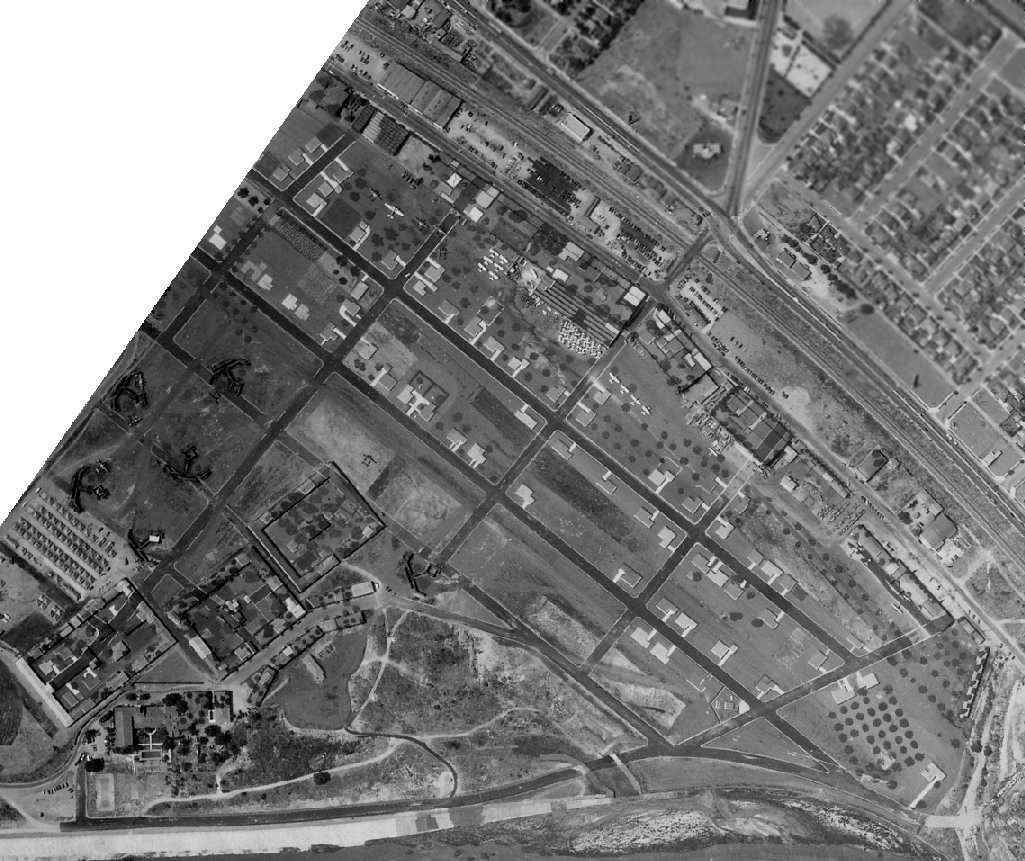
An amazing 6/6/42 U.S. Navy aerial view (courtesy of Brian Rehwinkel)
depicted the incredibly effective camouflage which was applied to the Grand Central Air Terminal during WW2.
Although the photo appears to depict a series of city streets,
a closer inspection will reveal the layout of hangars along the west side,
and the characteristic shape of the contract flying school buildings along the east side,
along with dozens of aircraft parked on the west & east side of the runway (including at least 9 P-38 Lightning fighters).
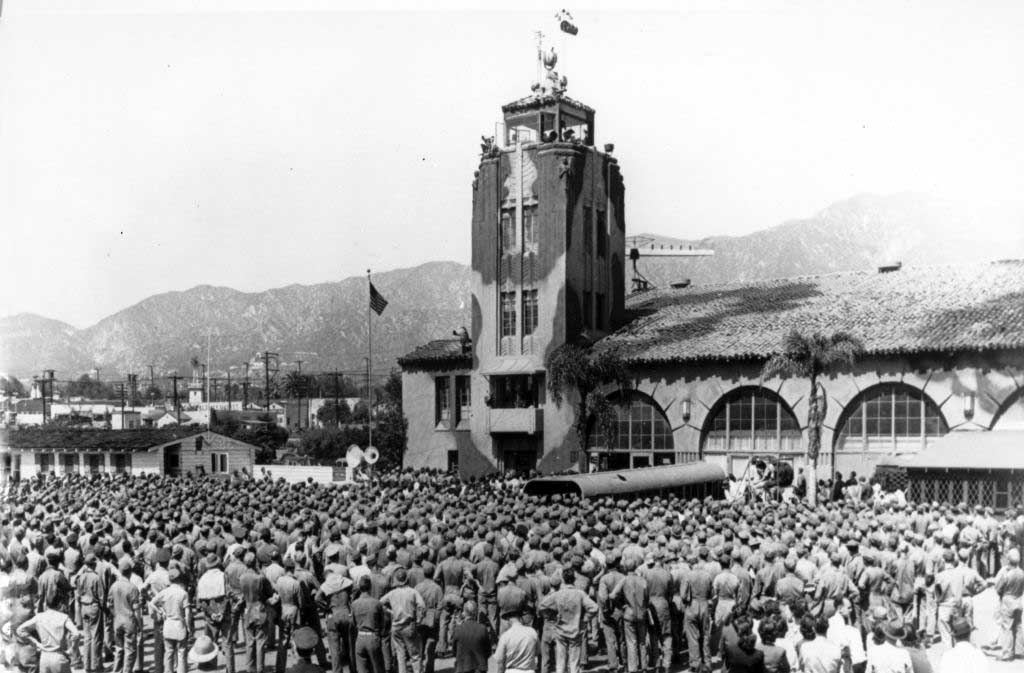
A 1942 photo of a mass gathering of servicemen in front of the camouflaged Grand Central control tower.

A WW2 era aerial view looking northwest at a row of aircraft in front of the camouflaged Grand Central control tower.
The 1942 USGS topo map depicted the open area of the Grand Central Airport,
but did not label it at all (most likely due to wartime security concerns).
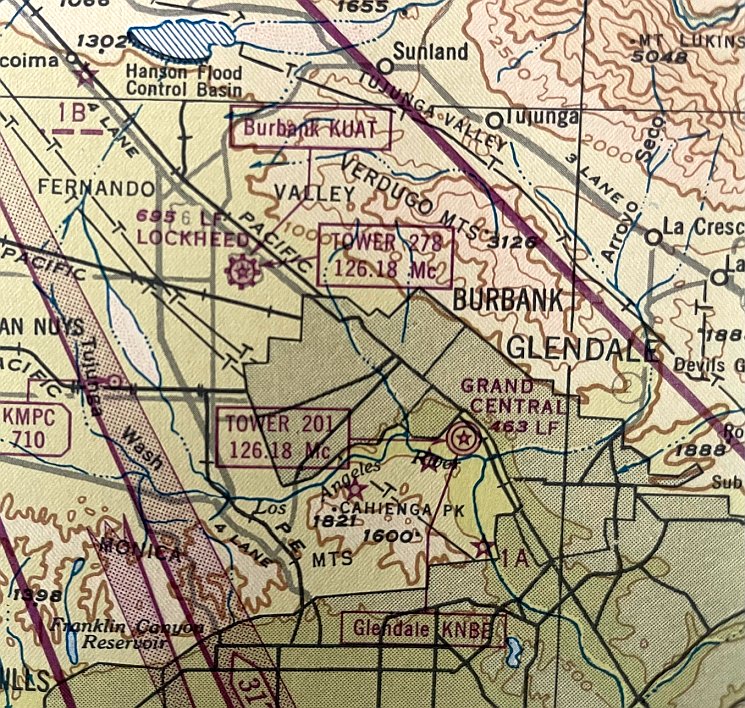
A 1943 LA Approach Chart (courtesy of Kevin Walsh) depicted Grand Central Airport as a military airfield.
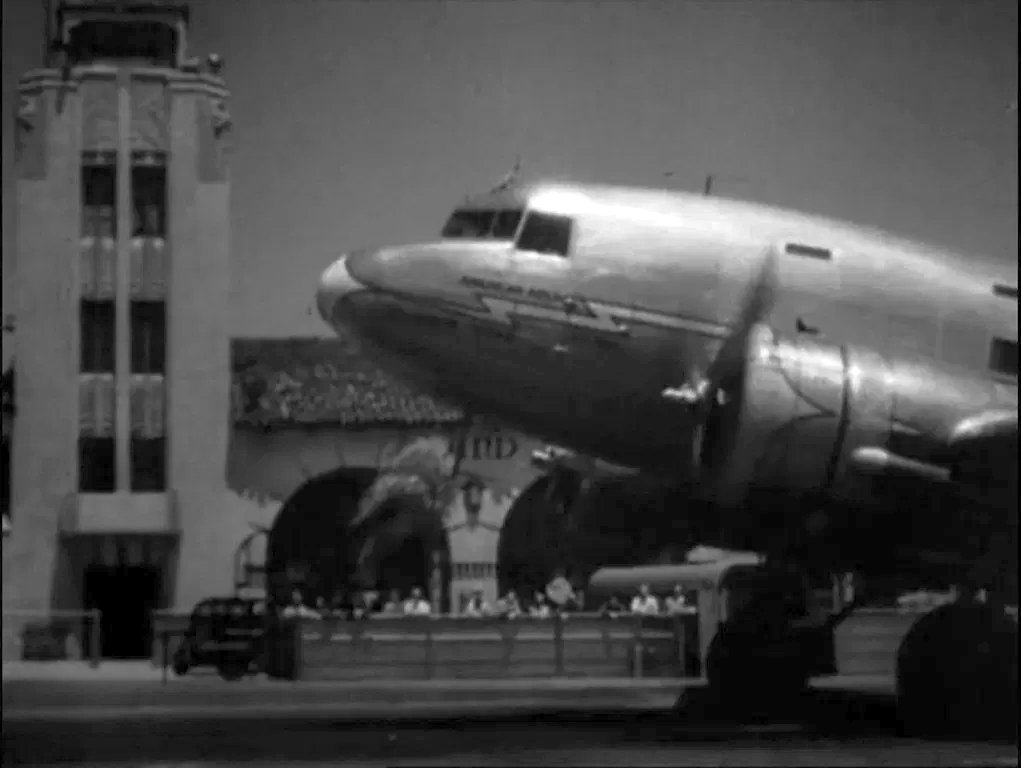
A still from the 1943 movie “Sherlock Holmes in Washington” filmed at Grand Central Air Terminal, showing a Douglas DC-3 in front of the iconic terminal.
In the movie Grand Central stood in for Transatlantic Airways’ London Terminal.
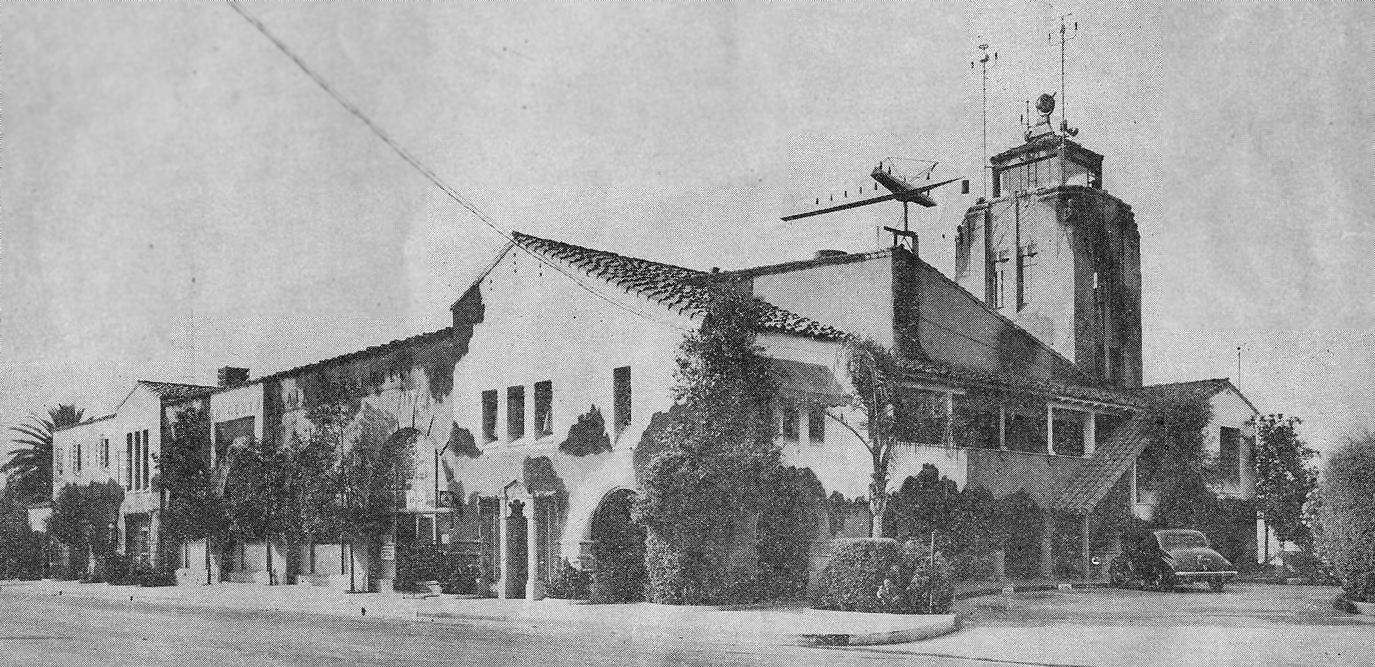
An undated photo of the camouflaged Grand Central control tower from the August 1944 BulAero, announcing “We purchase Grand Central: Famed Southern California airport is acquired by Cal-Aero Academy.”
Also note the illuminated wind indicator mounted on a corner of the terminal building.
The 1944 US Army/Navy Directory of Airfields (courtesy of Ken Mercer).
described Grand Central as having a 5,000' hard-surfaced runway,
and indicated that Army operations were conducted from the field.
Other contract flying schools operated at Grand Central during WW2,
including the Grand Central Flying School (which trained cadets for the RAF).
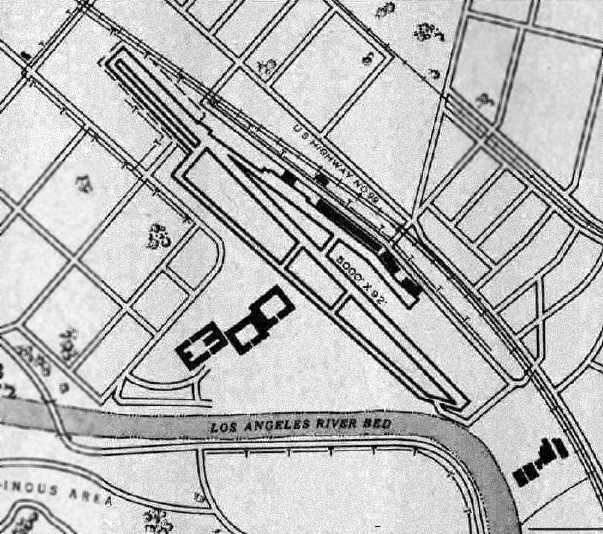
The 1945 AAF Airfield Directory (courtesy of Scott Murdock) depicted Grand Central Airport
as having a single 5,000' northwest/southeast concrete & asphalt runway,
with a parallel taxiway depicted on the southwest side.
The field was said to have a total of 5 hangars, with the largest being 200' x 130',
and the buildings of the Cal-Aero Technical Institute were depicted along the southwest side of the runway.
The field was said to be privately owned & operated.
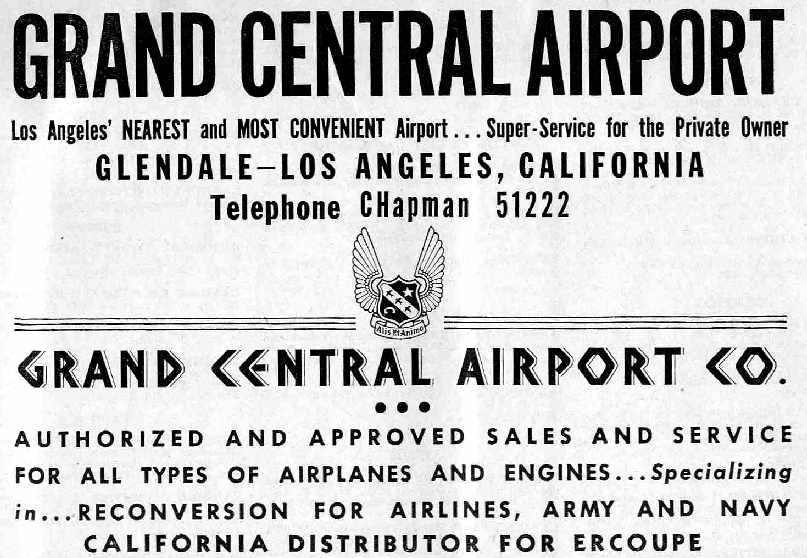
An advertisement for Grand Central Airport from the Haire Publishing Company's 1945 Airport Directory (courtesy of Chris Kennedy).
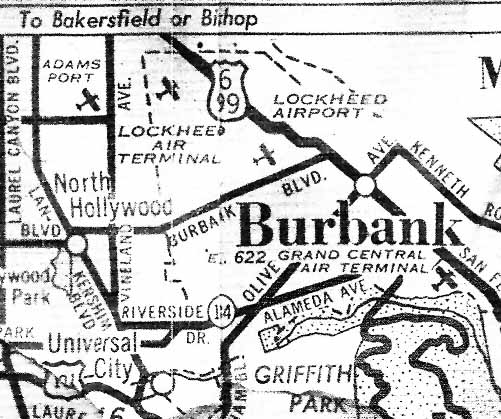
Grand Central Air Terminal, as depicted on a circa 1945 street map (courtesy of Ken Brody).

A 1945 Thomas Brothers map (courtesy of Kevin Walsh) depicted Grand Central Airport, but did not depict any runways or hangars.
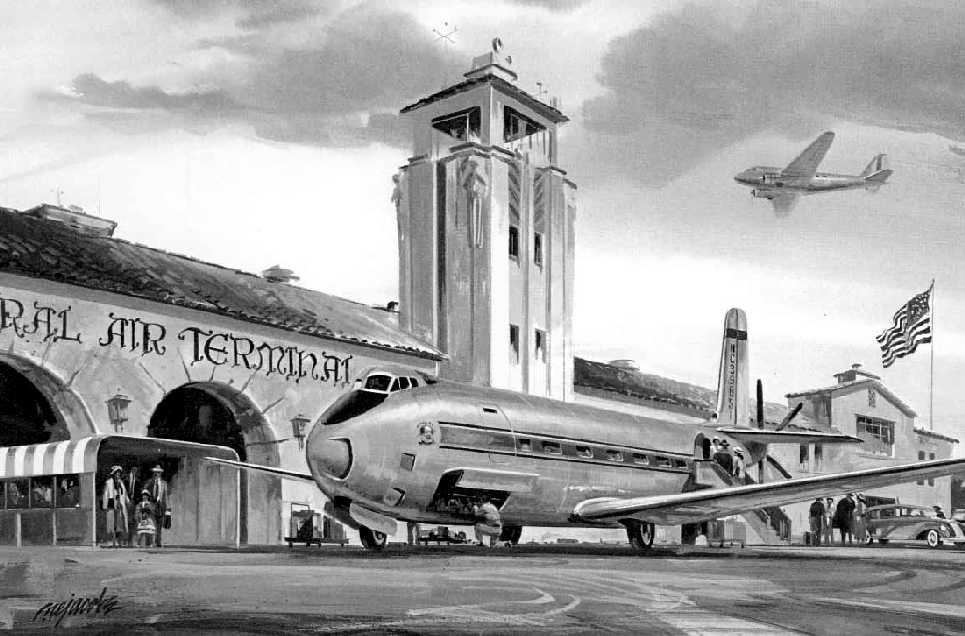
A 1946 artist's concept of the Douglas DC-8 Skybus in front of Grand Central Air Terminal.
The Skybus was an unbuilt concept for a short-range airliner based on the XB-42, with twin internal engines driving centerline contrarotating propellers.
It had no relationship to the jet aircraft built later as the DC-8.
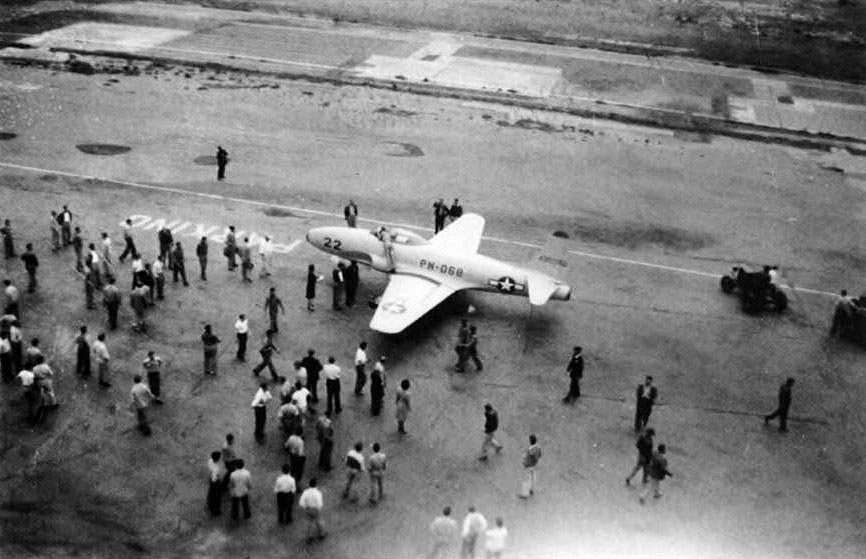
A 1946 photo of the first jet to visit Grand Central Air Terminal: one of the first Lockheed P-80 Shooting Stars, built only a few miles away.

An August 1946 photo of NC873H, a single-seat Boeing 100 (civilian version of the F4B-1 fighter), C/n 1144, owned by Paul Mantz, at Grand Central Air Terminal.

The 1947 LA Local Aeronautical Chart (courtesy of Tim Zukas)
depicted Grand Central Airport as having a 5,000' paved runway.
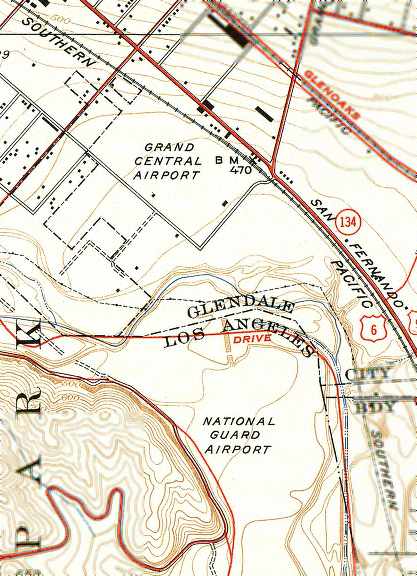
The 1948 USGS topo map depicted Grand Central Airport,
as well as the “National Guard Airport” to the south.
John Underwood recalled, “When we moved to Glendale I discovered Grand Central Airport,
where I got a job working for Maj. Moseley, which provided the means to learn to fly & eventually own several airplanes.
The upshot of all that was a book titled 'Madcaps, Millionaires & 'Mose'.
I've just finished a 2nd volume on the same subject for Arcadia Publishing, 'Grand Central Air Terminal'.”

A 1948 or later photo of a USAF C-47 Skytrain departing from Grand Central.
The original caption noted that the Grand Central Aircraft Company specialized in the customizing of C-47s & DC-3s for civilian & military customers.

A fabulous 1949 picture by Don Ayres of the Moseley's Aircraft Overhaul & Repair Station hangars at Grand Central,
with an amazing assemblage of P-51s, B-25s, and a C-47.
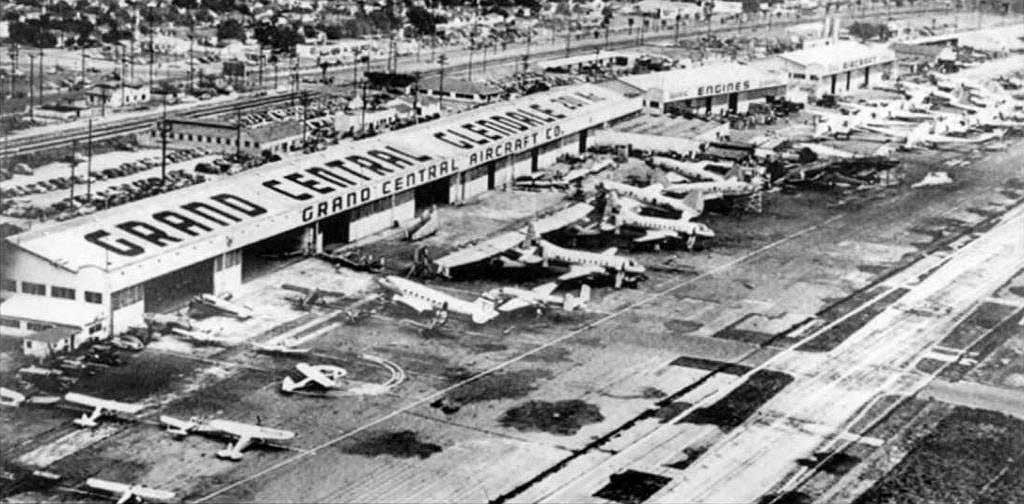
A circa 1949 aerial view looking east at the Grand Central Aircraft company hangar (courtesy of Pete Mason),
with a large number of surplus aircraft on the ramp.
Pete took a photo in 2007 of the “photo hanging on the wall of Bruce Anspaugh's hangar at Santa Paula Airport.
Bruce bought the hangar from Bill Bowers who worked as an instructor at Cal-Aero.
The photo used to hang on the walls of Cal-Fed Savings & Loan where Ken (K.D.) Johnson worked as a pilot.
When the building was going through re-model the pictures where being tossed out so K.D. saved them & gave them to Bowers.”
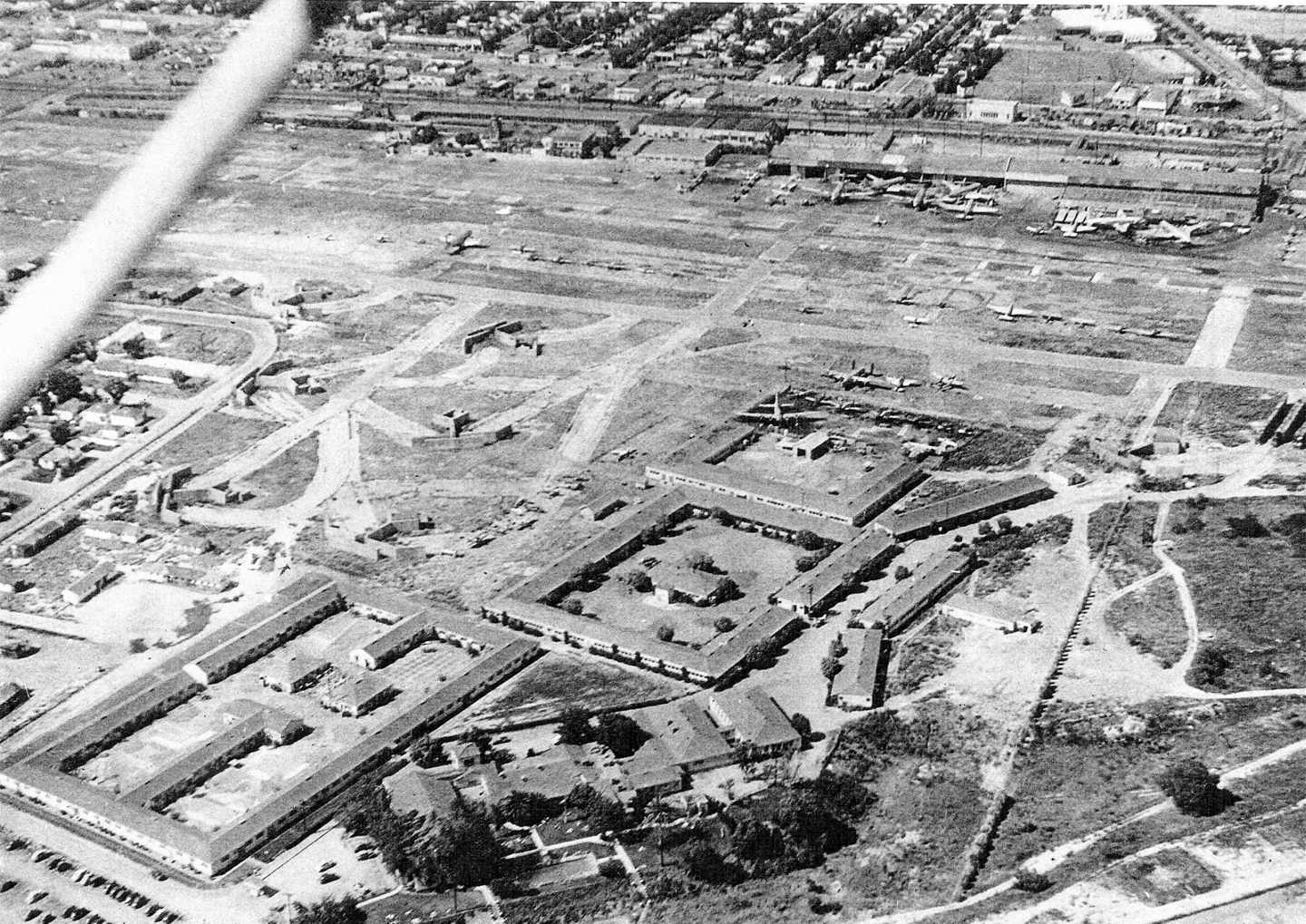
A circa late 1940s aerial view looking north at Grand Central Airport,
with the buildings of the Cal-Aero Technical Institute in the foreground, leftover WW2 aircraft parking revetments to their left,
and a large number of aircraft parked on the field.

Grand Central Airport, as depicted on a 1949 street map.
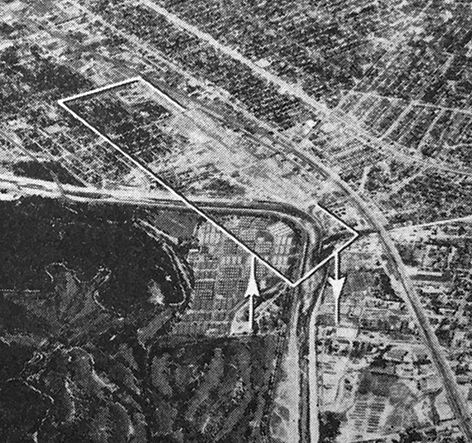
An undated aerial view looking north at Grand Central Air Terminal from the 1950 Air Photo Guide (courtesy of Kevin Walsh).
It described Grand Central Air Terminal as having a 3,750' paved Runway 12/30, and listed the manager as C.M. Clough.

The last aerial photo which has been located showing Grand Central Airport still intact was a 12/4/52 aerial view (from the UCSB Library).
Note that the runway had been considerably truncated at some point,
as the northwestern 1,000' portion had been cut off by the construction of Sonora Avenue.
It showed 2-dozen light aircraft parked around the buildings of the Cal-Aero Technical Institute on the southwest side of the field.
The main hangars on the northeast side of the field had “Grand Central Glendale” painted along their roof.
An assortment of aircraft was scattered around the field, including several DC-3s.

A remarkable undated photo (courtesy of Richard Eger) of a German Me-262 WW2 jet fighter (sans engines) at Grand Central.
Richard believes the Me-262 was used “in the late 1940's & early 1950's by Cal-Aero Technical Institute for mechanic training.”
Note that the hangar in the background is the exact same hangar
as pictured in the 1938 photo [several paragraphs above] of the Timm T-840 at Grand Central.
According to Richard, “The plane subsequently got its engines back, was purchased by Edward Maloney,
and migrated with Maloney to 4 different museums that he set up, the last being The Air Museum - Planes of Fame, at Chino Airport.
It was taken over by Paul Allen of Microsoft fame about November 2000,
with the intent to once again fly it, complete with original German Jumo 004 engines.”
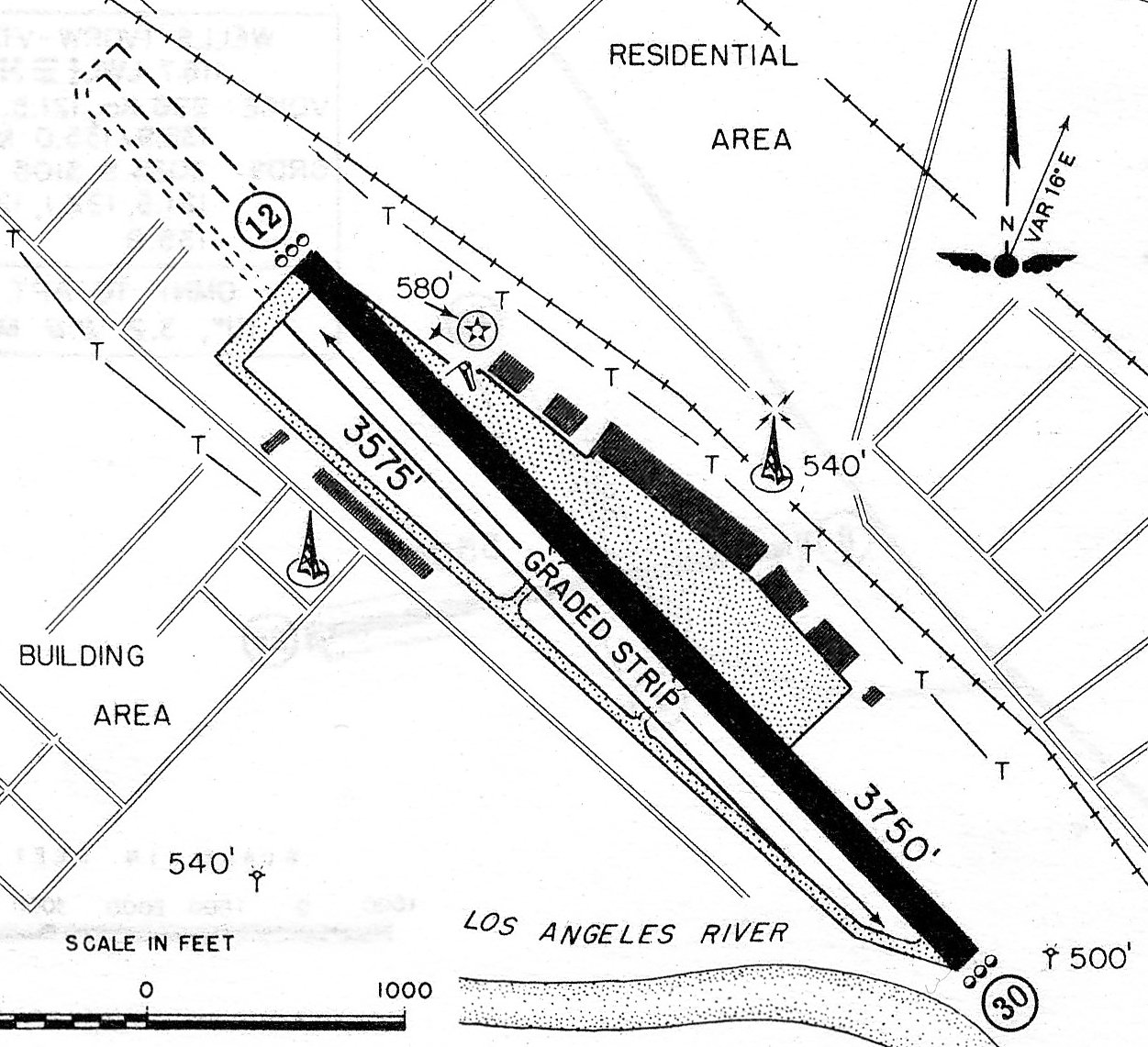
A 1953 airport diagram depicted Grand Central Airport as having a paved 3,750' Runway 12/30 (a considerable reduction in runway length compared to its 1947 depiction),
with a row of hangars on the northeast side.
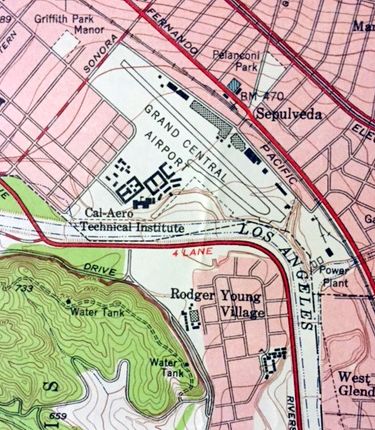
The last topo map depiction which has been located of Grand Central Airport was on the 1953 USGS topo map (courtesy of Kevin Walsh).
It depicted the runway & the row of hangars.
Grand Central was still depicted on the 1953 Flight Chart (courtesy of Scott O'Donnell),
and was described as having a 3,800' hard-surfaced runway.
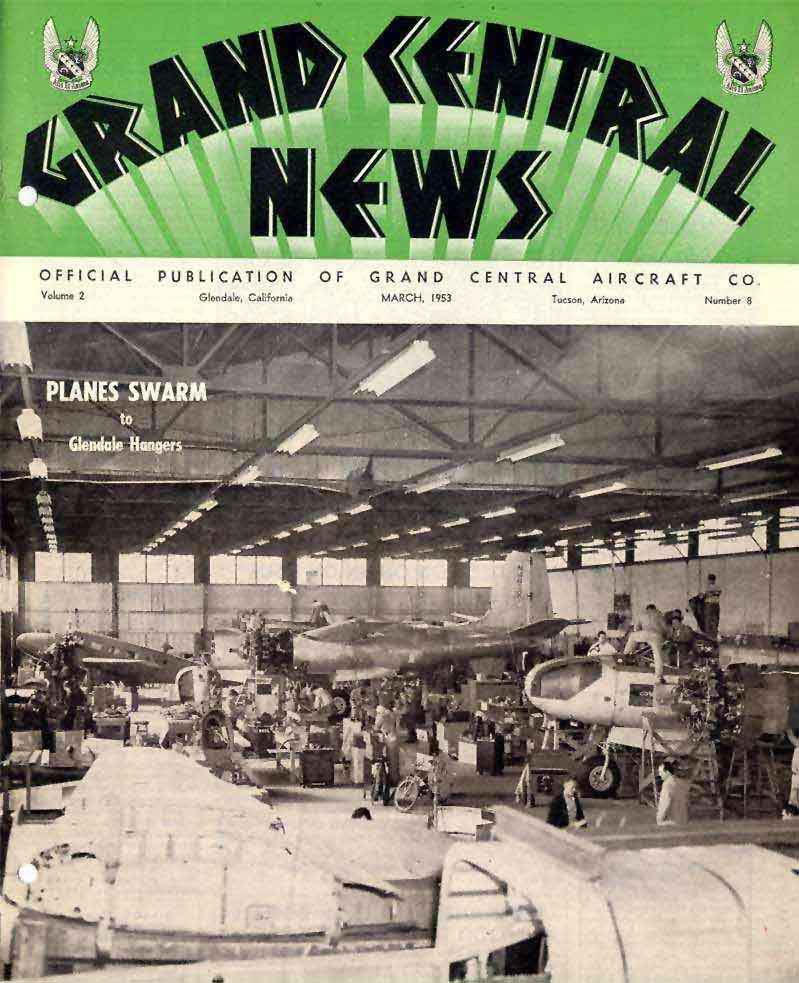
The March 1953 issue of the Grand Central News included an undated cover photo captioned “Planes Swarm to Glendale Hangars”
depicted Douglas B-26s & a Beech 18 undergoing heavy maintenance.
Grand Central was still depicted on the September 1954 USAF LA Sectional Chart (courtesy of Chris Kennedy).
It was depicted as having a 3,800' hard surface runway & a control tower.
A 1954 aerial view showed a much larger number of aircraft parked around the field than had been visible in the 1952 photo.
Bob Cannon recalled, "I remember flying my Aeronca into Glendale Grand Central in 1955."
Grand Central also played a role in the related field of rocketry,
when in 1955 Major Corliss Moseley & Charles Bartley (the inventor of rubber-based solid rocket fuel propellants)
established the Grand Central Rocket Company in the vicinity of Grand Central Air Terminal.
The company tested solid rocket propellants among the old revetments around the field.
It was there that the 3rd stages of early Vanguard rockets, including the first 2 to reach orbit, were built.
This effort became a major producer of rocket fuels, and was eventually sold to become the Lockheed Propulsion Company.

A circa 1950s photo of what appears to be a tricycle-gear conversion of an Aeronca at Grand Central Air Terminal.
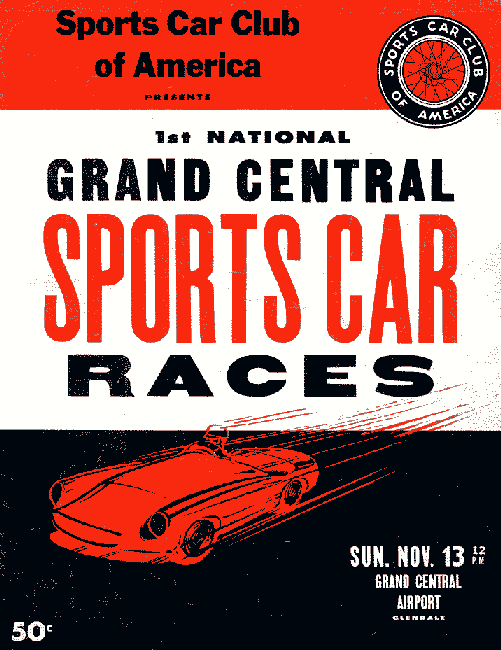
The runway of Grand Central Airport was used on 11/13/55
as the site of the Sports Car Club of America's “1st National Grand Central Sport Car Races”.
The cover of the race program listed the venue as the “Grand Central Airport”,
but it was described as the “Grand Central Industrial Center” in the body of the program.

The layout of the 11/13/55 sports car race held at Grand Central (courtesy of Frank Sheffield).

The 1956 LA Local Aeronautical Chart (courtesy of Tim Zukas) depicted Grand Central Airport as having a 3,800' paved runway.

A 1956 photo by Ed Coates of the unique Atlas H-10, N37463, in front of Grand Central's tower.
The Atlas H-10 was originally designed by Max Harlow, and at one point flew with twin-tandem Continental GO-300 engines driving contra-rotating propellers.
By the time of this photo it had been refitted with a conventional single Lycoming IO-720 engine.
According to Ed Coates, "The airport may have already been officially 'closed' & the airplanes I photographed were just sitting there.
I don't remember any actual aircraft movements on that day to be sure, but there were a lot of aircraft there, and somehow they got them all off. At least I presume they did!"

A 1/6/56 photo of Helio H-391B Courier N4104D C/n 022 making one of its dramatic STOL takeoffs from a deserted looking Grand Central Airport.
This Courier was built as a missionary plane, the first Helio sent overseas by Jungle Aviation & Radio Service.
The Spanish titles on the fuselage read “Summer Linguistics Institute, University of Oklahoma” & “Department of Education, Republic of Ecuador”.
Jack Frye had hoped to establish a new home for the Helio company at Grand Central, but was killed in an automobile accident.
According to Bill Barker (former Ford Aerospace employee),
the Ford Motor Company established the first headquarters of their Aeronutronic Division at the Grand Central Terminal Building in 1956.
An unusual aviation use of a portion of the Grand Central Air Terminal property late in its lifespan
was the heliport built by National Helicopters on the south end of the Grand Central property.
According to National Helicopters: “Facility we built in 1957 at 1000 Flower Street at the old Glendale airport.”

A circa 1957-59 photo (courtesy of Richard Yokley) of the last aviation use of the Glendale Grand Central Airport site:
a heliport at 1000 Flower Street, which was built at some point after 1964 on the southern edge of the Grand Central Airport property.
According to Richard Yokley, “The location & hangar was originally built by National Helicopters.”
The photo depicted 5 Bell 47 helicopters (with one in the markings of TV station KTLA) in front of a hangar with a windsock & a Shell sign.
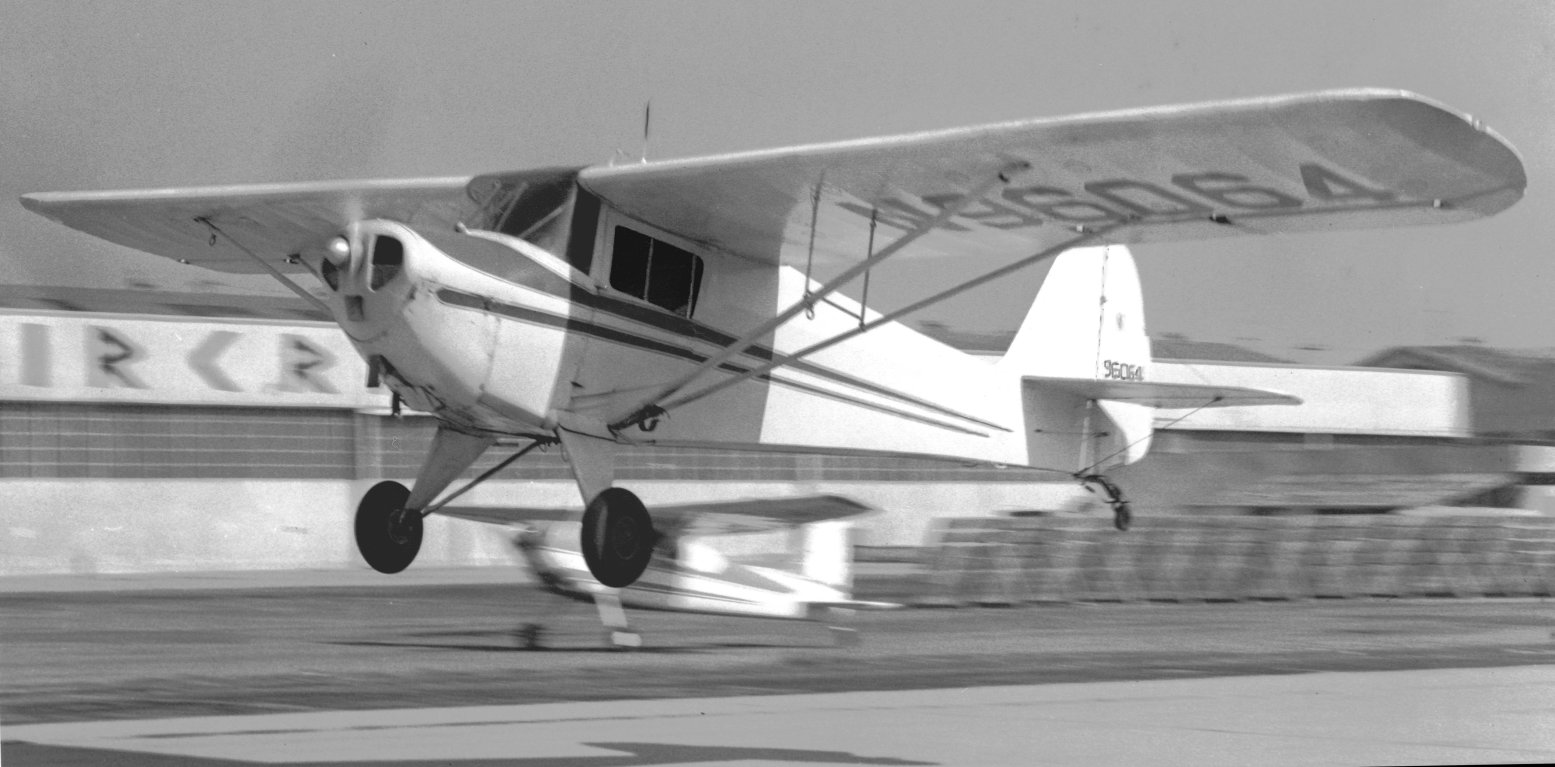
A February 1958 photo (courtesy of John Hurless) of a Taylorcraft BC-12D taking off or landing with the Grand Central Air Terminal hangars in the background.
John recalled, “That airport will always have a special meaning for me, because I was able to spend quite a few hours in the air from there, and for a short time was involved with the Civil Air Patrol.
I had my first session in a Link Trainer they had in a building on the northwest side of the airport.”

A 1958 photo (courtesy of John Hurless) of Jack Lewis, John Hurless, and Gayle Wood (under the wing) in front of an Aeronca Champ & the Grand Central Fixed Base Operator.
John recalled, “Gayle Wood & myself were members of the little flying club ran by Don Pruitt.
In all, we had 2 Aeronca Champs, a Cessna 170, and at one point a Cessna T-50 Bobcat.
The Bobcat had a metal fuselage, which was unusual for that plane.”

A 1958 photo by Gene Myers of his wife Jan Meyers & their 1946 Taylorcraft (BC-12-D, N43410) in front of the Grand Central terminal building.
Gene recalled, “I got my license in the Tylorcraft in 1958. We kept it at Grand Central until late 1958.”
Gene Myers recalled, “The runway had been lengthened to the north during the war & then shortened following the war.
Grand Central Aircraft was still in business & serviced civilian aircraft at that time.
The flight school was run by a Mr. Ryan (not related to Claud Ryan).
The airport had been camouflaged during the war
and there were areas of colored paint remaining on the runway when I flew out of there.
From altitude it could still give the impression of streets & houses, even in 1958.
There was an effort in 1958 to get the County to purchase the airport, but that failed.
I personally attended some meetings at the County during that effort.”
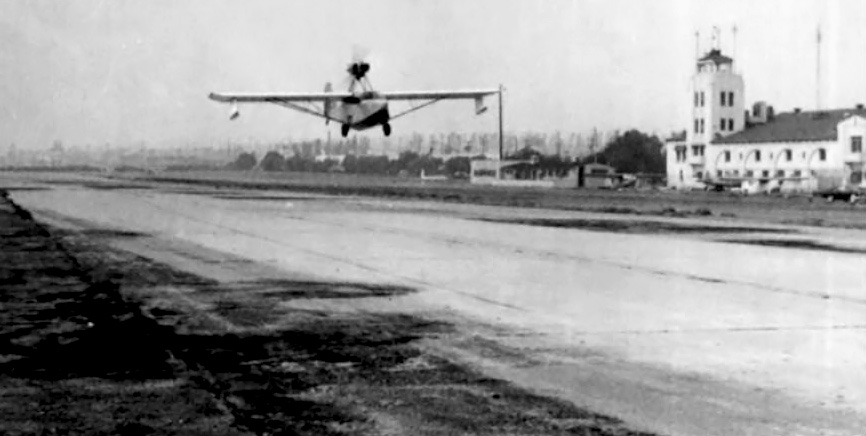
A 1958-59 photo of the prototype of the Jensen VJ-22 Chubasco departing from a deserted-looking Grand Central Air Terminal.
The VJ-22 was a homebuilt 2-place amphibian designed by Glendale inventor Volmer Jensen.
According to National Helicopters, their heliport on the south end of Grand Central Airport property
was taken over by the Los Angeles Police Department for their use as a police heliport.
According to National Helicopters, “The LAPD liked it so well they claimed the hangar & 10 acres of land under eminent domain.”
According to Dick Hart, owner of national Helicopter Service, they were forced out in 1959 when the LAPD took over the facility.
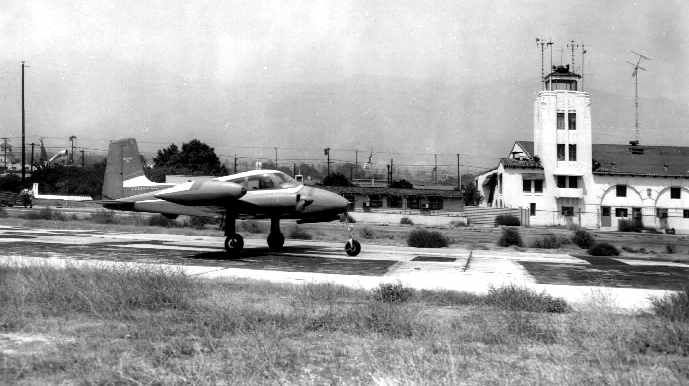
One of the last planes to leave the Grand Central Airport – a Cessna 310 – departs on 7/15/59.

The last aeronautical chart depiction which has been located of Grand Central Air Terminal was on the September 1959 LA Sectional Chart.
It depicted Grand Central as having a 3,800' paved runway.
According to Dan Rhinehart, the very last aircraft to fly out of Grand Central was a Twin Bonanza.
It unexpectedly blew an engine & was grounded at Grand Central.
It was in one of the big hangars at the time the airport closed,
and it wasn't ready to fly until about 2-3 weeks after the airport closed.
There were strict orders that there were to be no more flights in or out after the closure deadline,
and any remaining airplanes were to be disassembled & trucked out.
There were security guards on the property from early morning until nightfall.
So the Twin Bonanza pilot came in before sunrise, rolled the airplane out of the hangar,
started the engines, quickly taxied to the end of the runway,
and without a run-up took off to the north just before sunrise, and landed a few minutes later at Burbank.
Apparently nobody noticed what had happened!

A sad sight – a bulldozer removing the runway pavement at Grand Central Airport in 1959, with the control tower visible in the background.
According to Allen Brandstater, “Mose rarely visited Grand Central Airport after the field closed in 1959.
He did continue the operation of Grand Central Aircraft (which repaired & restored prop planes until about 1974) on the site.
He never made a profit at this - he just loved old planes & invested money to preserve them.
GCA probably lost 8 or 10 million dollars from the late 1950s until it was closed shortly before his death in 1973.
The operation of the site was very profitable, however, given the rentals of his commercial real estate values & his #2 man, Bill Clough.
Aircraft maintenance & repairs continued at Grand Central for some years, but the engines, avionics, props, etc., were brought in on flatbed trucks.
Most came from Lockheed (now Bob Hope) Airport in Burbank, some from Van Nuys, Whiteman, etc.
I also think they came as far as another Moseley facility in Tucson, AZ.
Once repairs were completed, they were shipped back to wherever they came from - i.e., operational airports.”
The March 1960 LA Sectional Chart depicted Grand Central Airport as an abandoned airfield.
The Ford Aeronutronic Division relocated from Grand Central to Newport Beach in 1960.
Grand Central Air Terminal was depicted as an abandoned airport on the March 1960 LA Sectional Chart (courtesy of Dick Welsh).
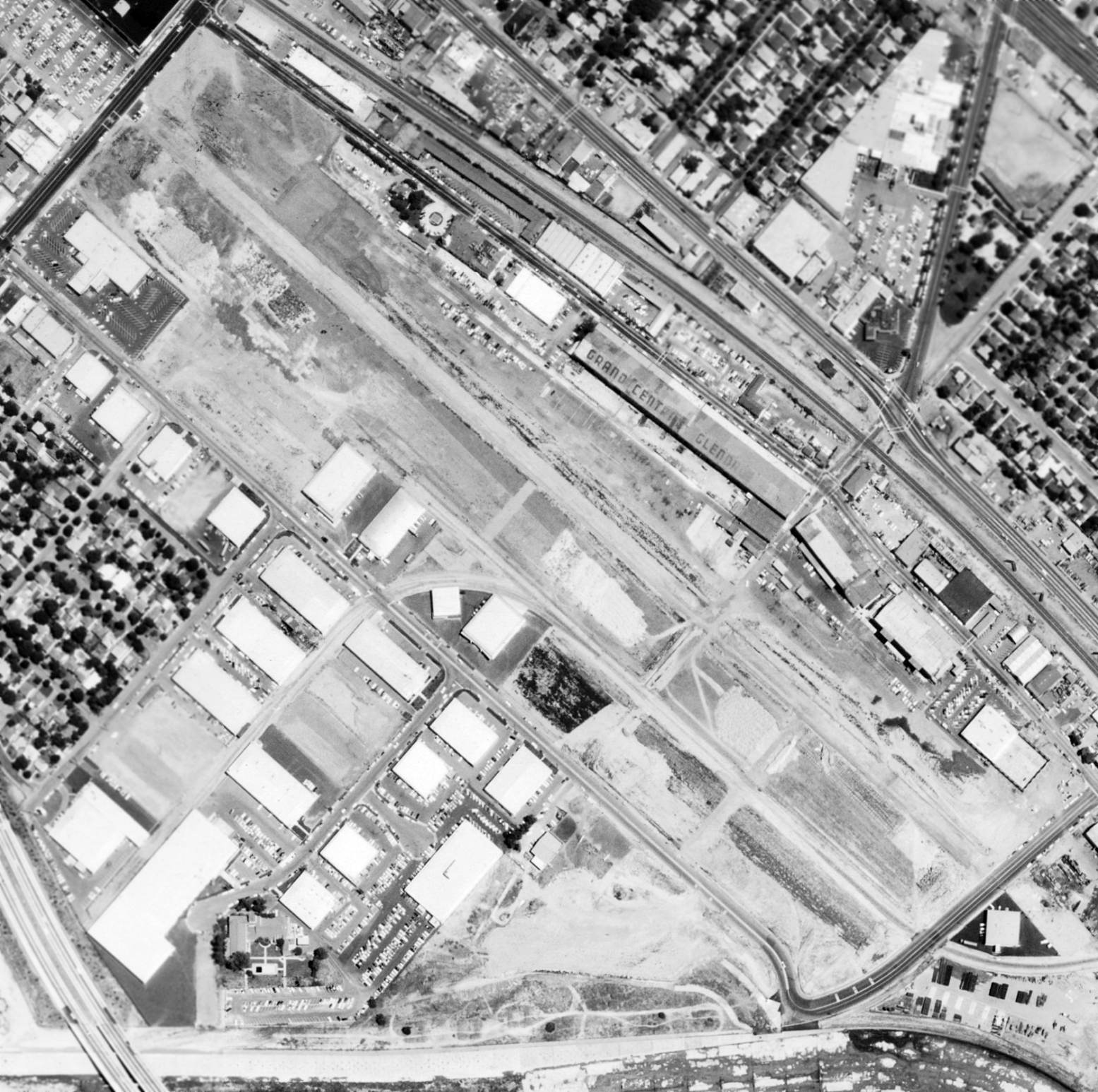
A 5/29/60 aerial view (from the UCSB Library) showing the sad sight of the Grand Central Air Terminal property after the runway pavement had been removed.
The lettering “Grand Central Glendale” was still visible on the long hangar roof.
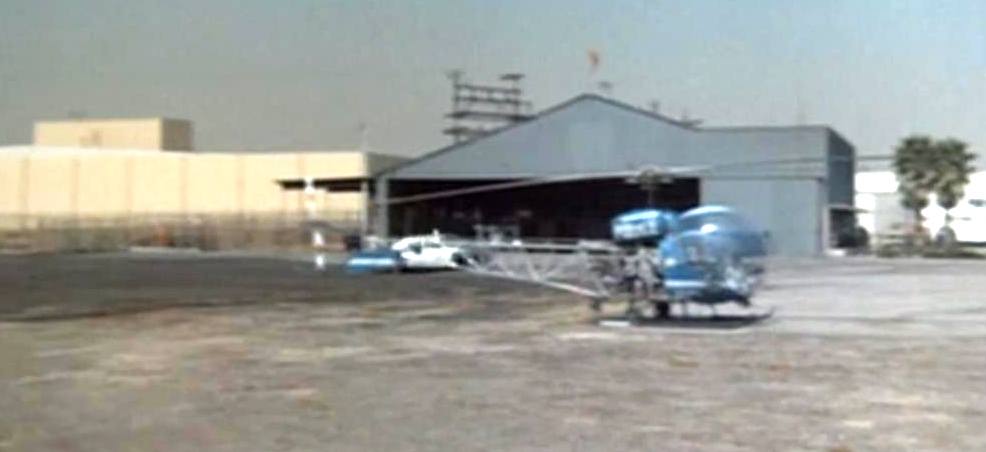
The last photo which has is available showing an aircraft at Grand Central Airport was a scene from a 1971 Adam 12 episode (courtesy of Richard Yokley)
showing a single Bell 47 in LAPD markings in front of the former National Helicopters hangar at the heliport on the south end of the Grand Central Air Terminal property.
Allen Brandstater recalled, “When I got out of the Army in late 1971, Mr. Moseley rented me (at a VERY reduced rate)
an office in the same old terminal building on Air Way.
It was on the 2nd floor, very close to the spacious office he occupied overlooking the airfield when he managed it from the early 1930s to the late 1950s.”
A 1972 aerial view showed that the distinctive buildings of the former Cal-Aero Technical Institute on the southwest side of the field
had been replaced with numerous commercial buildings, which also covered the former runway area.
The 3 main hangars on the northeast side of the field remained standing, along with the elegant terminal building.
Allen Brandstater recalled of Mose, “Shortly after his death in 1973, his widow (Audrienne) sold Grand Central to an investors' group.
The amount was $40 million. A few years later, this group sold to a Japanese firm for $75 million.
They held it a few years, but were unable to effectively capitalize on use of the land & buildings.”

A 11/25/77 USGS aerial view showed that all 3 of Grand Central Air Terminal's large hangars
(including the largest of the 3, the Maddux hangar, just southeast of the terminal building) still remained standing.
The last photo showing any aircraft at the Grand Central Airport property was a 1980 aerial view of the LAPD heliport on the south end of Grand Central Airport property.
It showed at least 5 helicopters on the numerous helicopter parking pads next to the hangar.
According to Dick Hart, owner of national Helicopter Service, The LAPD remained at 1000 Flower until 1983 when they moved to the newly-built downtown Piper Tech facility.

A circa 1980s interior view looking southwest from Grand Central Air Terminal's control tower cab.
Tom Kramer recalled, “Back in the 1980s I was looking for the site of this legendary airport.
When I saw the building which had what looked like a control tower on it, I knew I hit paydirt.
At the time, a law office was in the main terminal building
and I went in to confirm my suspicions that it was the old control tower & terminal.
They had a copy of a book which I purchased about Grand Central Air Terminal called “Madcaps, Millionaires and Mose”
which was a history of the airfield with dozens of photos.
At that time, the terminal building was in excellent shape & I found the 2 surviving hangars as well.”
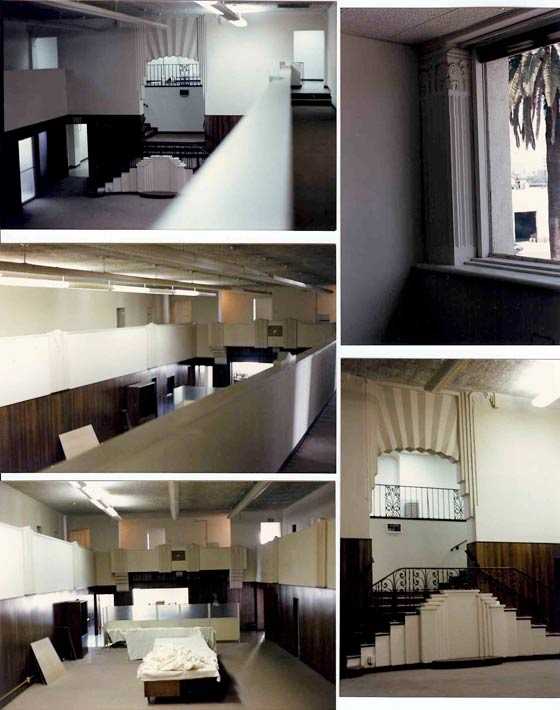
A collage of 1984 interior views of Grand Central Air Terminal by Cecile Alessi
(courtesy of Cecile Alessi, viathe web site of the Davis-Monthan Airfield).
Cecile remarked, “I took most of the pictures from the 2nd floor walkway... looking north & south along the inside.
Interior stairs are on the south end of the building."
Note the Art Deco (Moderne) accents & the clean lines of the mezzanine.
The ceiling tiles & fluorescent lights were not original.
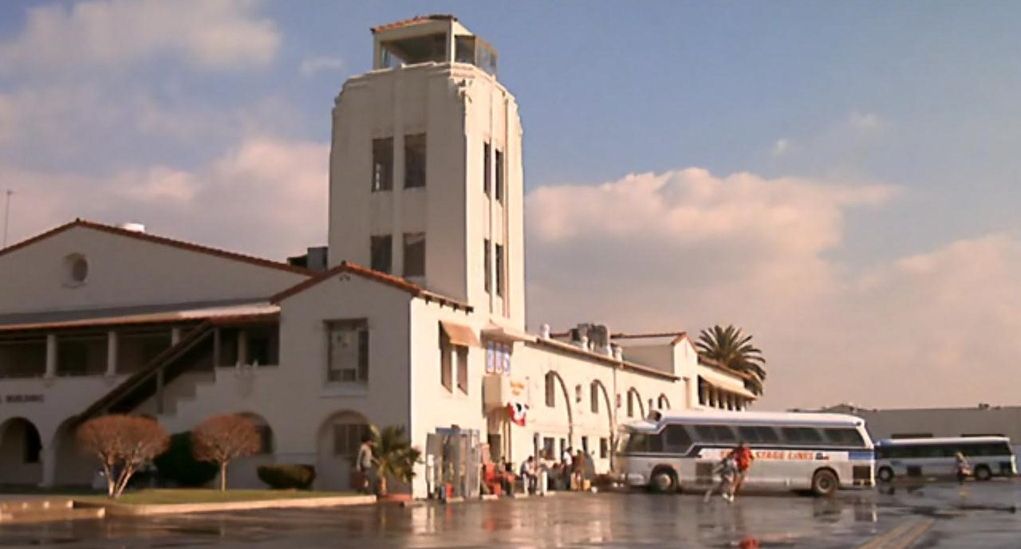
A still from the 1985 movie “Pee Wee's Big Adventure”, in which Grand Central Air Terminal was reused as a filming location standing in as a San Antonio bus station (courtesy of Greg Steinmayer).
A 1989 aerial view showed the LAPD heliport on the south end of Grand Central Airport property remained intact,
with numerous helicopter parking pads next to the hangar, but no helicopters were visible.
By this point the LAPD had presumably transferred their operations to their new Piper Technical Center heliport in downtown LA.
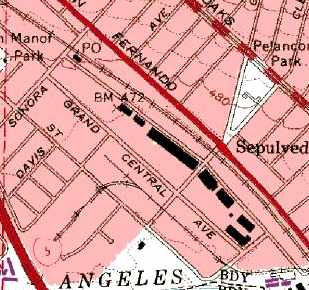
On the 1994 USGS topo map, the former runway had been reused as a street, labeled "Grand Central Avenue",
but the row of former hangars were still depicted.
A 1994 aerial view showed the LAPD heliport on the south end of Grand Central Airport property remained intact,
with numerous helicopter parking pads next to the hangar, but no helicopters were visible.
According to Allen Brandstater, “In 1994 or 1995, [the Japanese ownership group] sold it to the Disney Corporation.
The amount has not been disclosed, but I believe it to be around $200 million.”
The building in which the Hughes H-1 Racer was built, at 911 Air Way, burned to the ground in the late 1990s.

A 1998 photo by Dan Rhinehart of one of the remaining hangars at Grand Central.
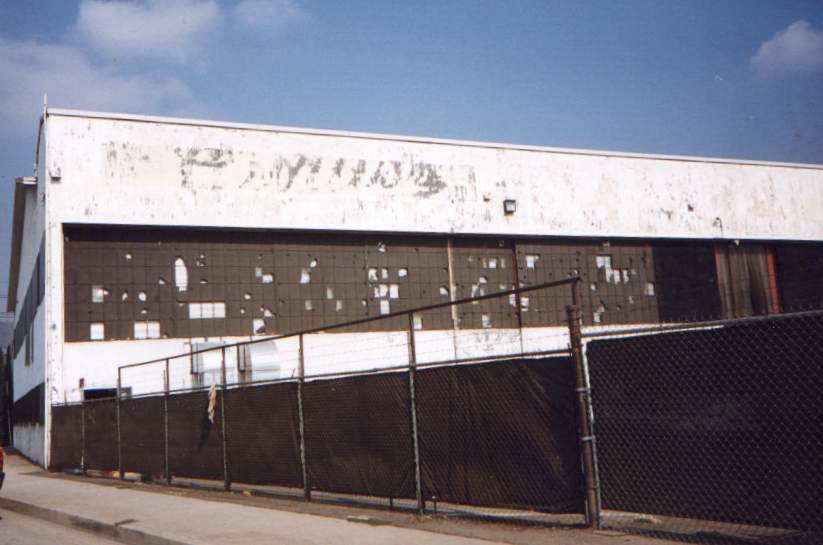
A 1998 photo by Dan Rhinehart of one of the remaining hangars,
on which the paint is peeling but the logo of the Curtiss Wright company can still be discerned.
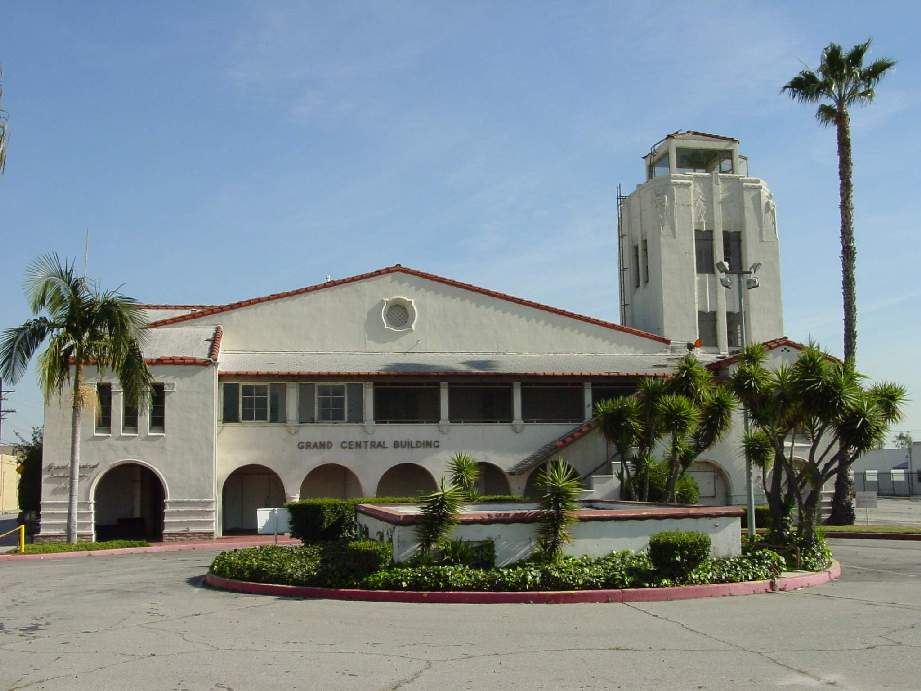
A February 2002 photo by Gabriel Shadid looking northwest at the front of the Grand Central Air Terminal.
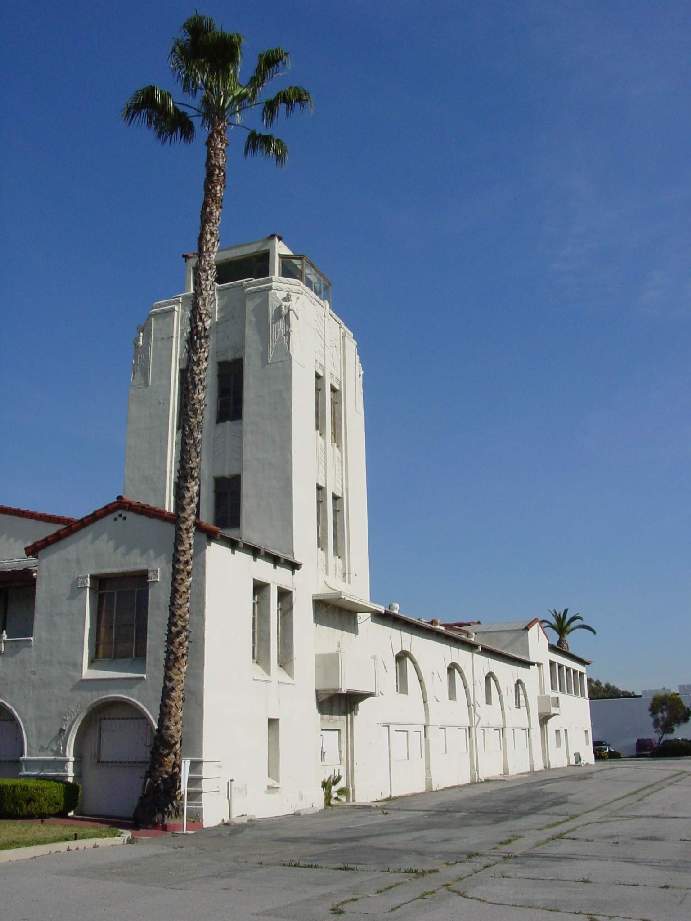
A February 2002 photo by Gabriel Shadid looking east at the former control tower of the Grand Central Air Terminal.
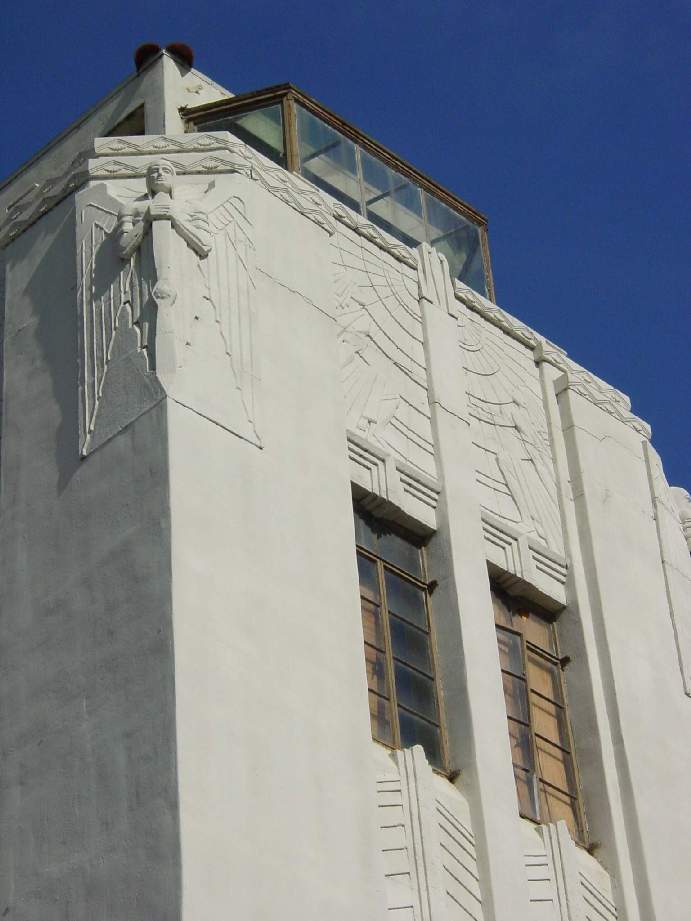
A February 2002 photo by Gabriel Shadid of the intricate detailing which surrounds the former control tower at Grand Central Air Terminal.
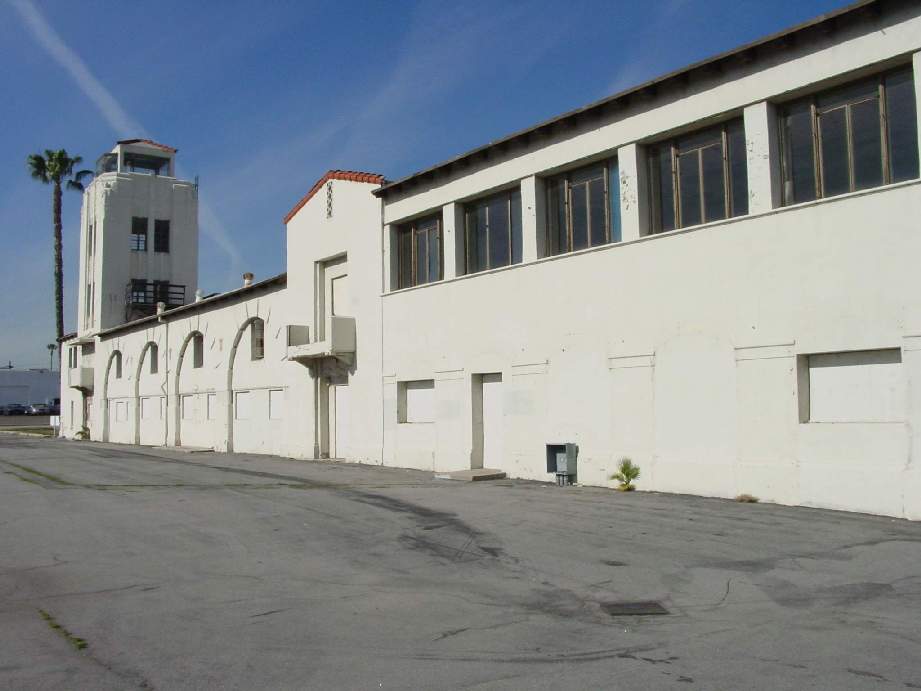
A February 2002 photo by Gabriel Shadid looking north at the former air-side of the Grand Central Air Terminal.
The largest of the 3 original hangars, the Maddux hangar, was destroyed at some point between 1994-2003, leaving 2 remaining hangars & the terminal building.
The terminal building, located at 1310 Air Way, is a National Historic Landmark.
The terminal building was owned at some point by the Walt Disney Company,
which planned to restore it as part of their Grand Central Creative Campus project (which apparently did not happen).
Danny Wilson reported in 2003, "I've been told that Air Way may have been where a taxiway once was.
I have it on good authority from a graybeard who lives nearby that that is the case.
Additionally, Grand Central Avenue was not listed in the Glendale city registry as a street
until after the airfield was decommissioned in 1955.
That street is EXTREMELY wide, wide enough to have several lanes in each direction
though there is no traffic in that industrial area.
My best guess would be that this was once where the runway stood, though I have no confirmation.
There simply is no other reason why a road would need to be that wide unless it was once used for that purpose.
Additionally, there are very old (and non-functioning) red lights on top of some of the nearby buildings in the area.
That gives visitors a clue that there was once an airport in the area."
A 2003 aerial view showed the LAPD heliport on the south end of Grand Central Airport property
had been covered by new buildings (Dreamworks) at some point between 1994-2003.

A March 2004 USGS aerial photo showed the Grand Central Air Terminal site had become an extensively developed commercial area,
and it was hard to discern any remaining trace of the former runways.
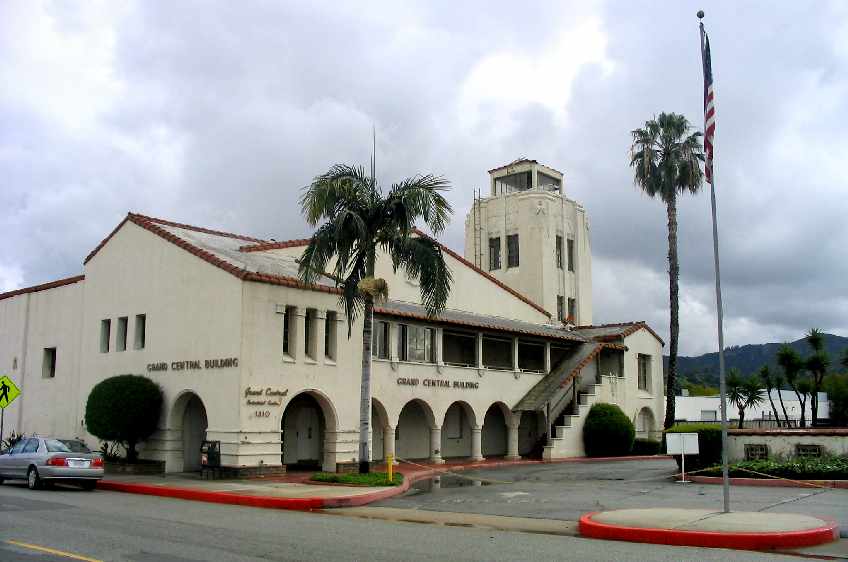
A February 2005 photo by Paul Freeman looking south at the Grand Central Air Terminal building showed it to remain intact, but it appeared to be abandoned & somewhat deteriorated.
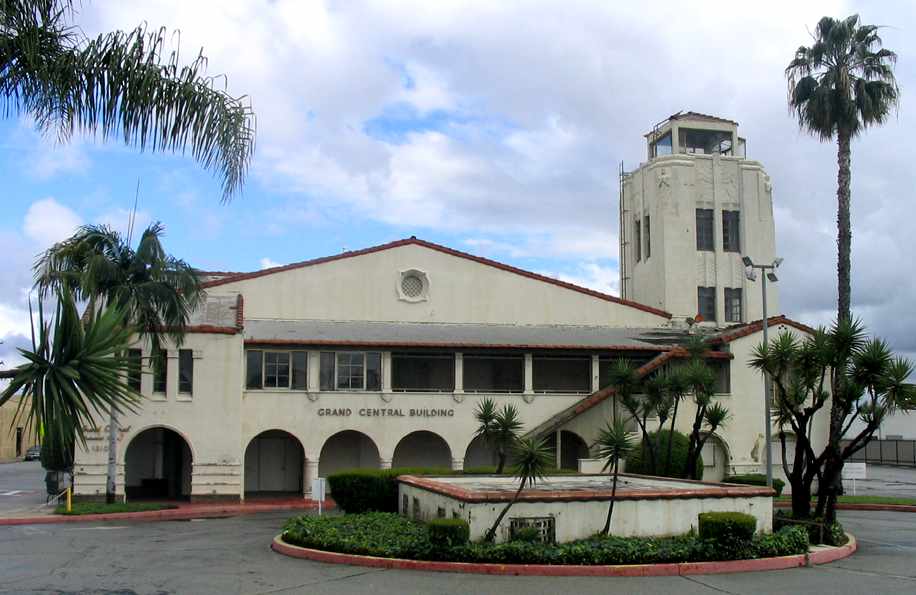
A February 2005 photo by Paul Freeman looking southeast at the front of the Grand Central Air Terminal building.

A February 2005 photo by Paul Freeman looking north at the air-side of the former Grand Central Air Terminal.
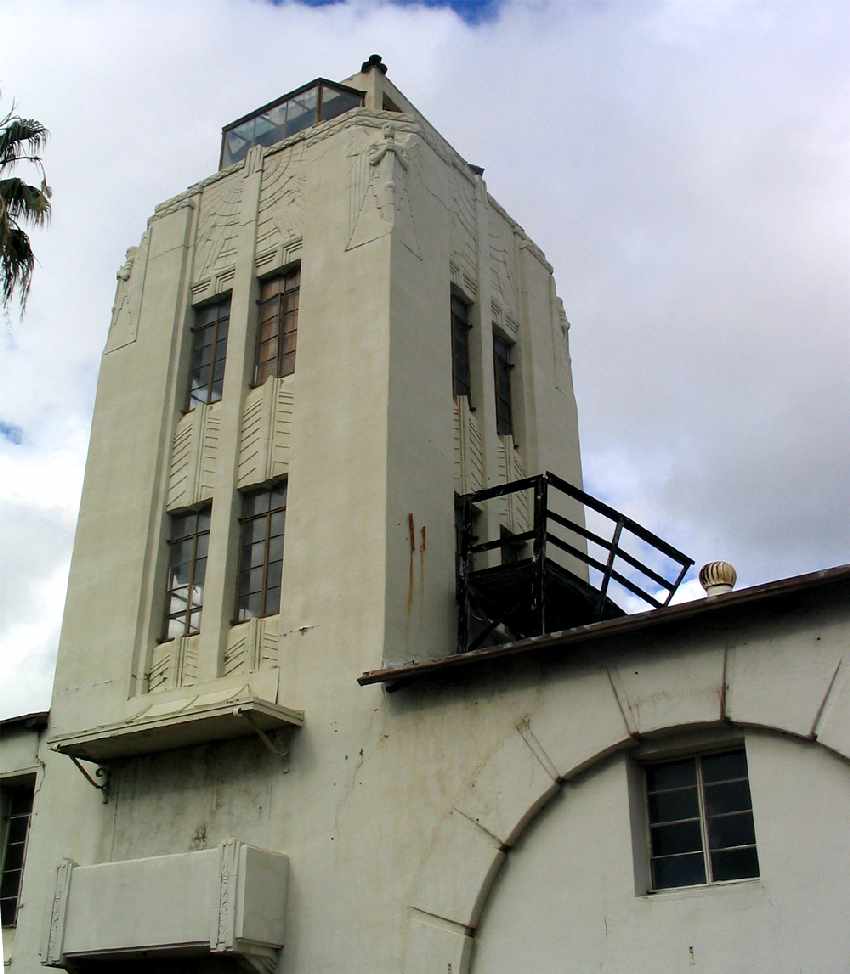
A February 2005 photo by Paul Freeman looking north at Grand Central Air Terminal's former control tower.

A February 2005 view by Paul Freeman looking northwest into the interior of the Grand Central Air Terminal building, now gutted.
Quite a shame to see the deterioration of the interior, compared to the 1984 interior view.
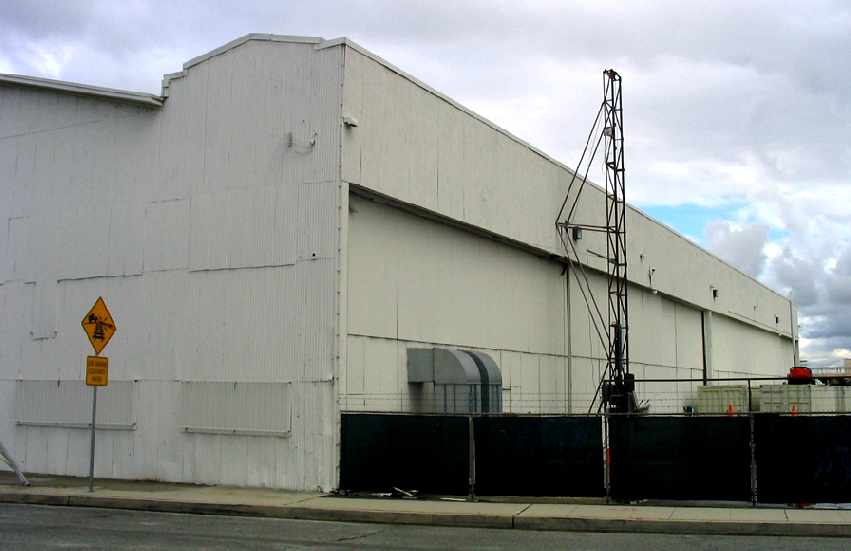
A February 2005 view by Paul Freeman looking south at the front
of the northern-most of the 2 former Grand Central Air Terminal hangars which remain standing.
Both of the former hangars appeared to be reused for commercial purposes.
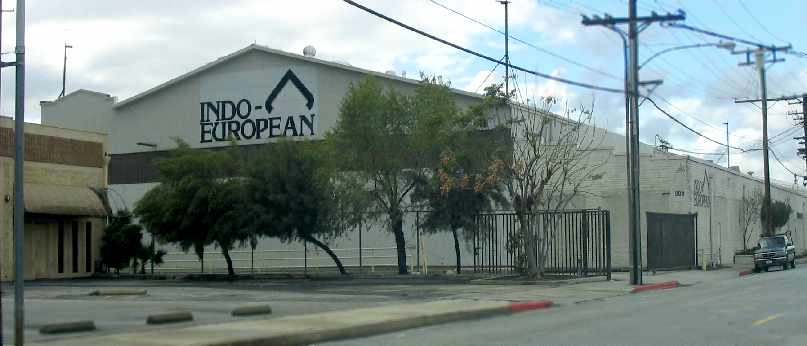
A February 2005 view by Paul Freeman looking northwest at the back
of the southern-most of the 2 former Grand Central Air Terminal hangars which remain standing.
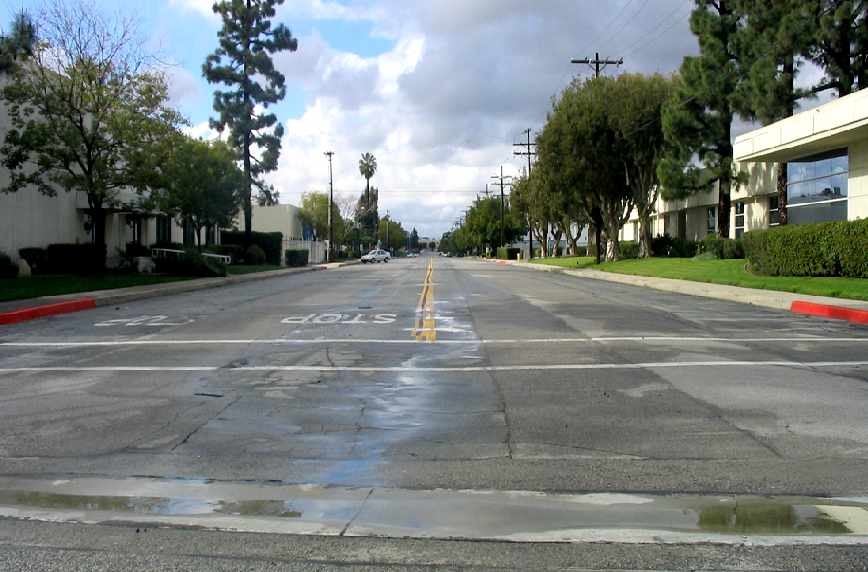
A February 2005 view by Paul Freeman looking along what is now Grand Central Avenue,
the former location of Grand Central's runway.
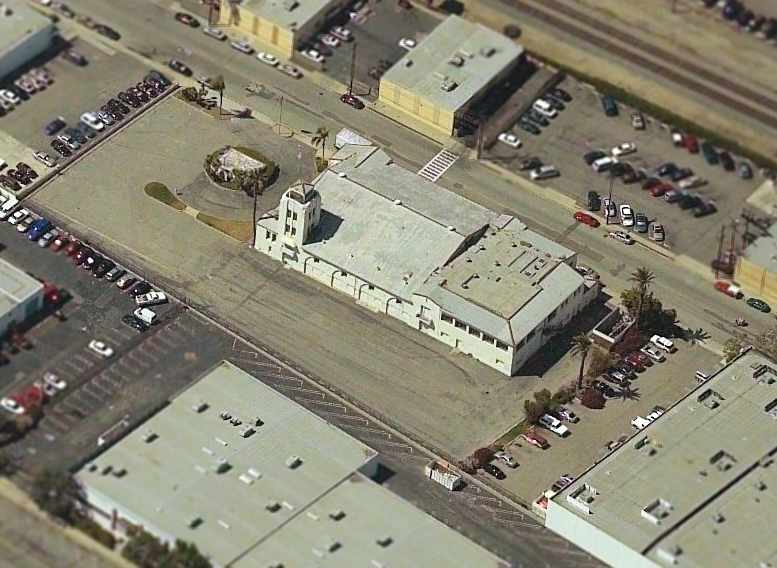
A circa 2005 aerial photo looking north at the former Grand Central terminal building.
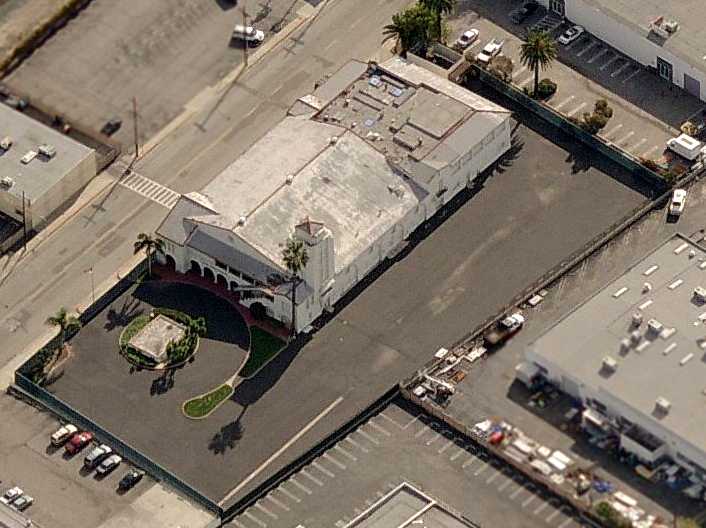
A somewhat later (circa 2006) aerial view looking east at Grand Central shows that the windows along the west side of the terminal building have been covered over.
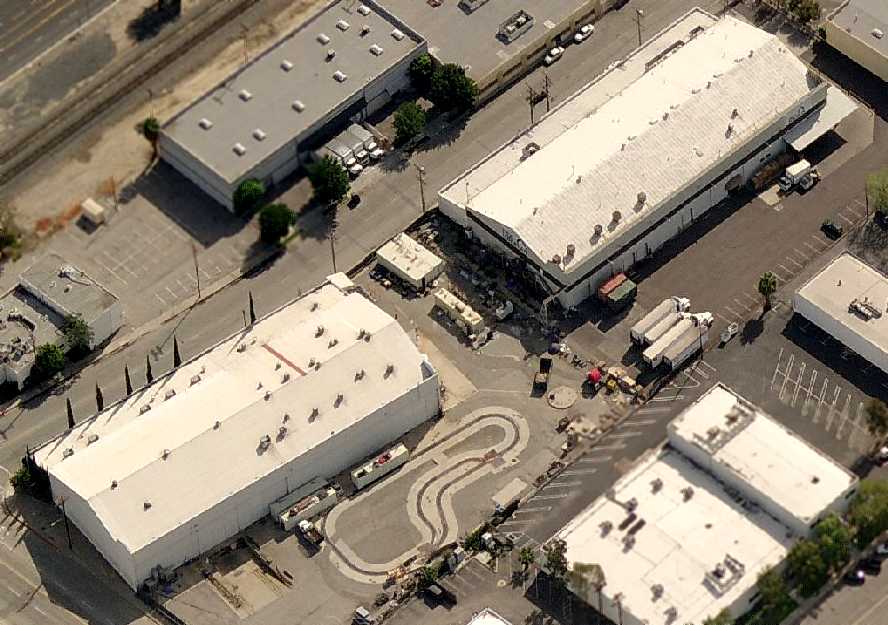
A circa 2006 aerial view looking east at the 2 former Grand Central hangars which remain standing.

Ironically the location of the former National Helicopters / LAPD heliport on the south side of the Grand Central Air Terminal property
once again has a heliport on exactly the same spot: the “Dreamworks Helistop Glendale” (5CA0).
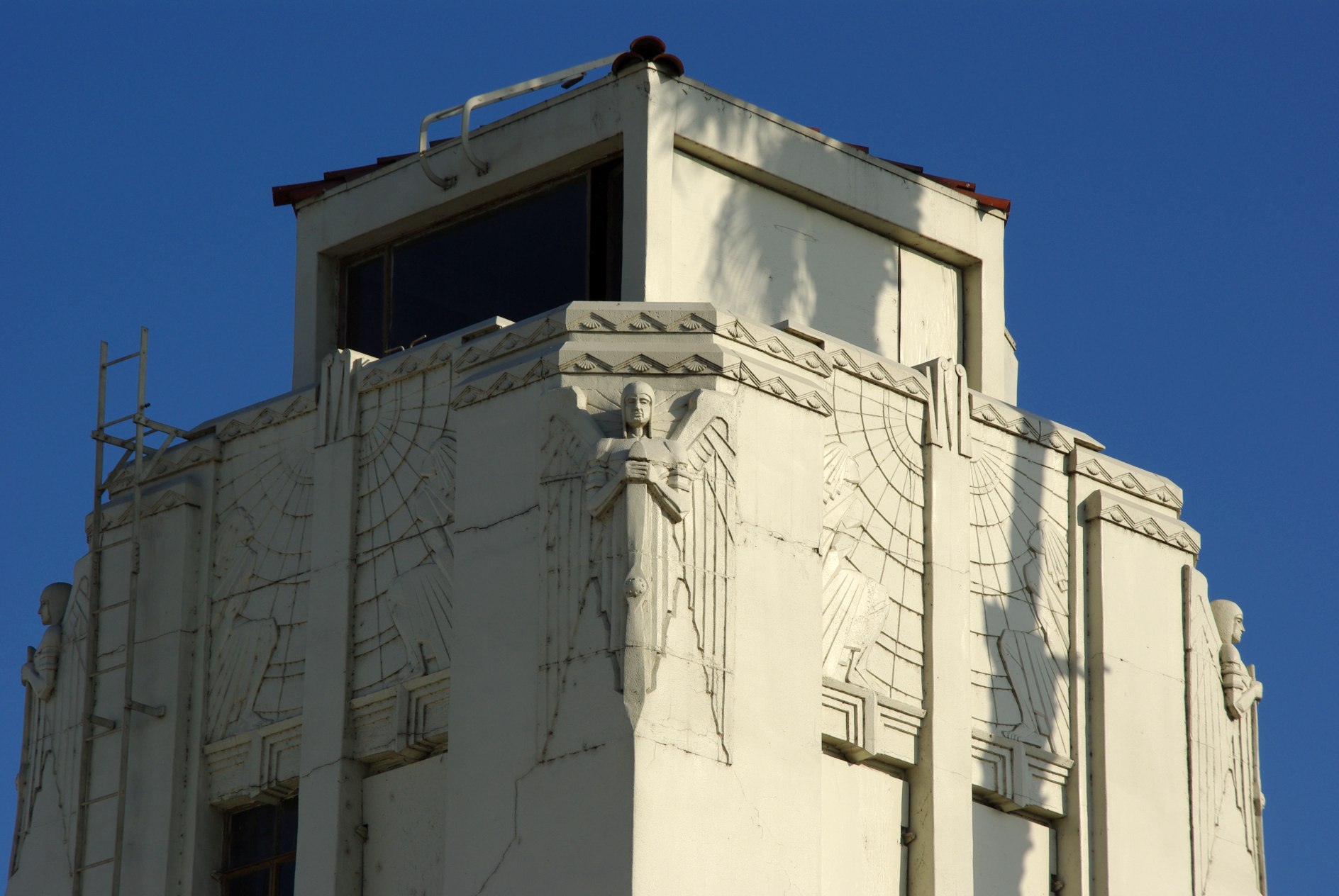
A 2014 photo by James Belknap of the beautiful Grand Central Air Terminal tower, with some of the cab windows boarded-up just before its restoration.
James reported, “The on-duty security guards let me roam around with my camera & try to get some of the structure on film.
This was during the time when it was pretty much unknown if Disney, who owned the property, was going to follow through on their promised restoration or not.
The deterioration of the terminal building was very evident & very sad.”
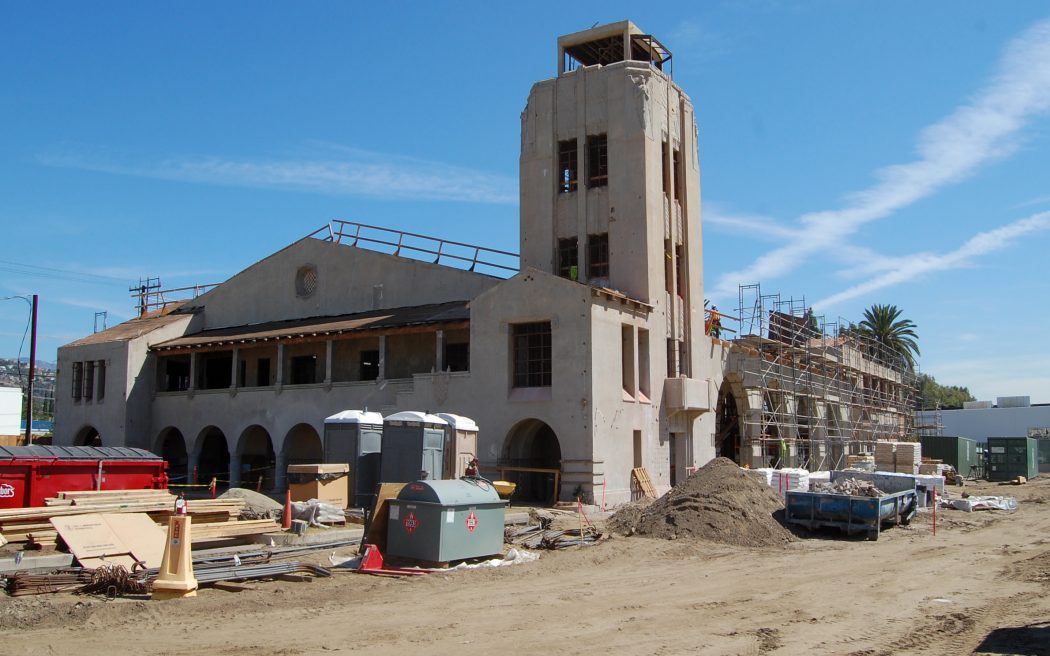
A 10/3/14 photo by John Hazlet of the Grand Central Air Terminal building, under renovation.
John reported, “Disney Corporation has undertaken a major refurbishment of the old terminal / control tower building.”
Between 2014-16, an industrial building adjcent to the southwest side of the Grand Central Air Terminal was demolished & replaced with a grass plaza.
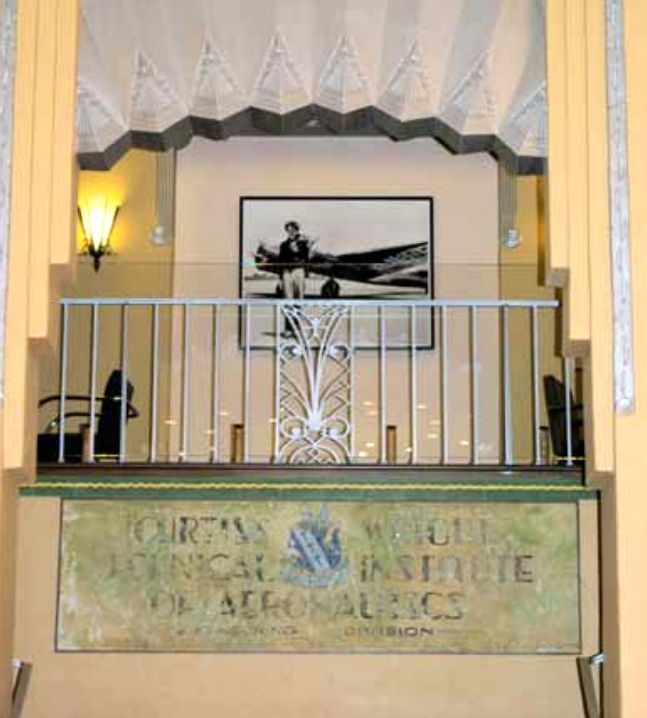
A circa 2015 photo by Hayden Hamilton of the top of the Grand Central Air Terminal Grand Hall,
showing the Curtiss Wright Technical Institute of Aeronautics sign uncovered in the staircase during restoration.
Also, note the custom made replica railing insert - just one of the many details the Disney company took the effort to recreate.
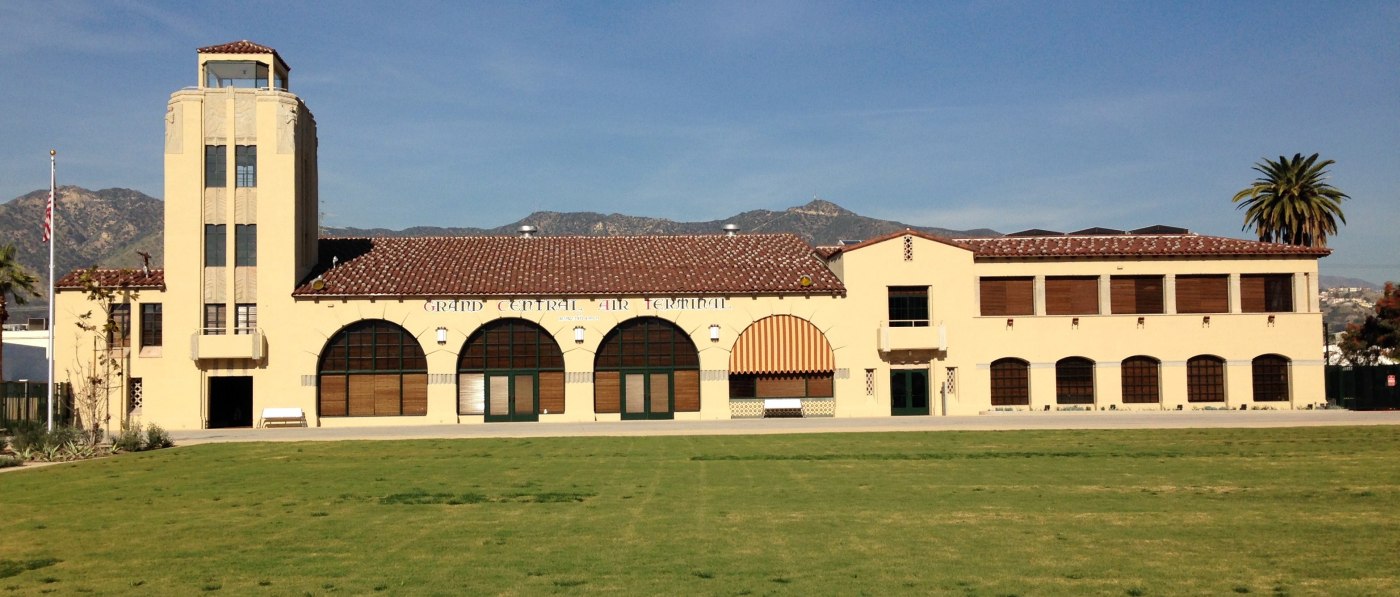
A 2/12/16 photo by G.B. Koontz looking northeast at the magnificently restored Grand Central Air Terminal building.
G.B Koontz reported, “The American Aviation Historical Society conference was held in the newly restored Grand Central Air Terminal on 12/13/16.
The Disney company did an amazing job of restoring the interior & exterior faithfully to the 1930 TAT era structure & decor.
Our group was the first ever to enter the building except for Disney employees. We had access to the lower level floor only.
The tower is not restored & remains closed. Parts of the first floor & all of the second floor is devoted to Disney offices.
The venue is stunning to say the least. Every detail of ceramic tile, roofing, lighting, windows, paint, etc., were perfect.
The building is not yet open to the general public & Disney will announce when they intend to offer it for events in the future.”
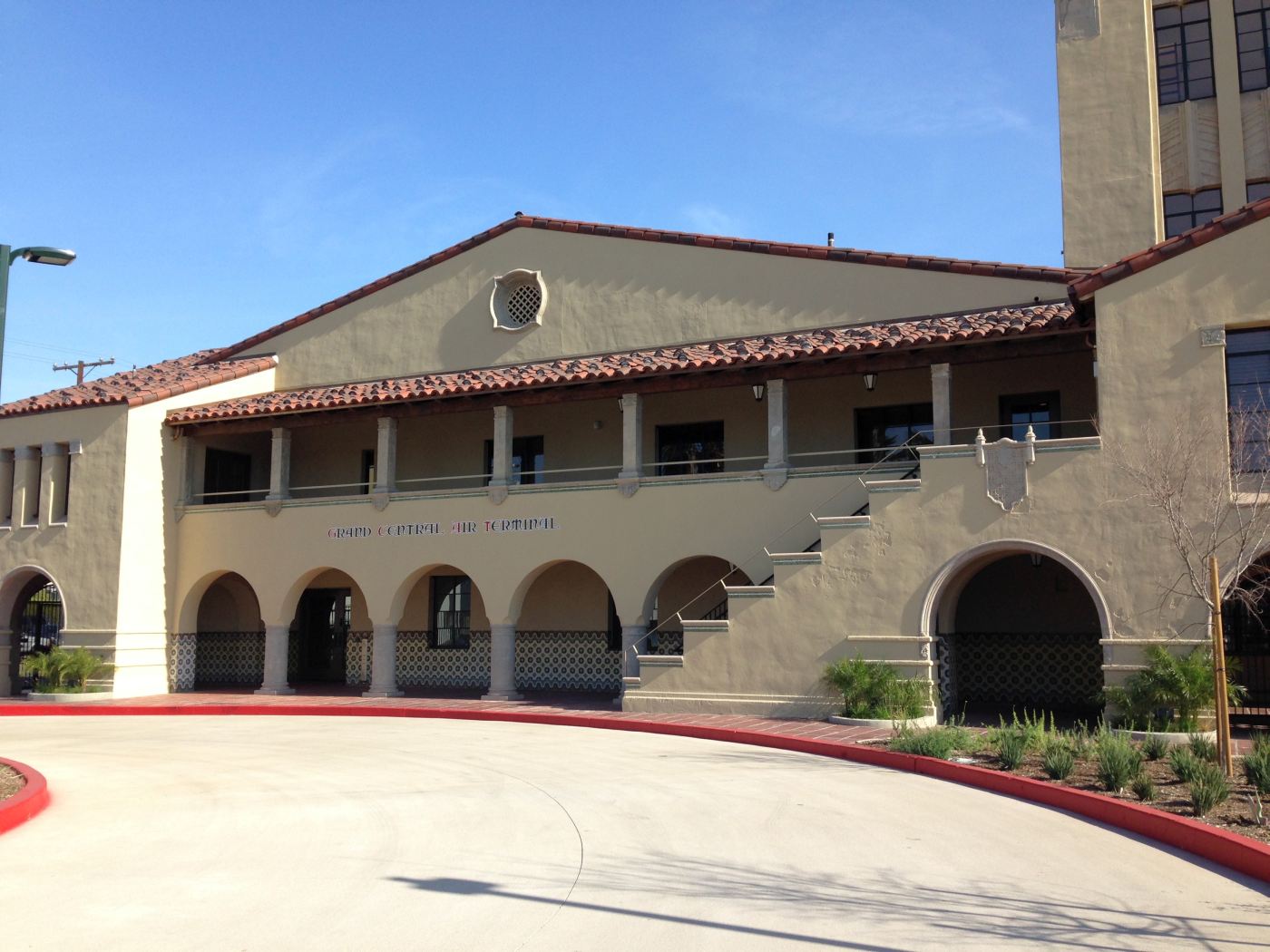
A 2/12/16 photo by G.B. Koontz looking southeast at the magnificently restored Grand Central Air Terminal building.
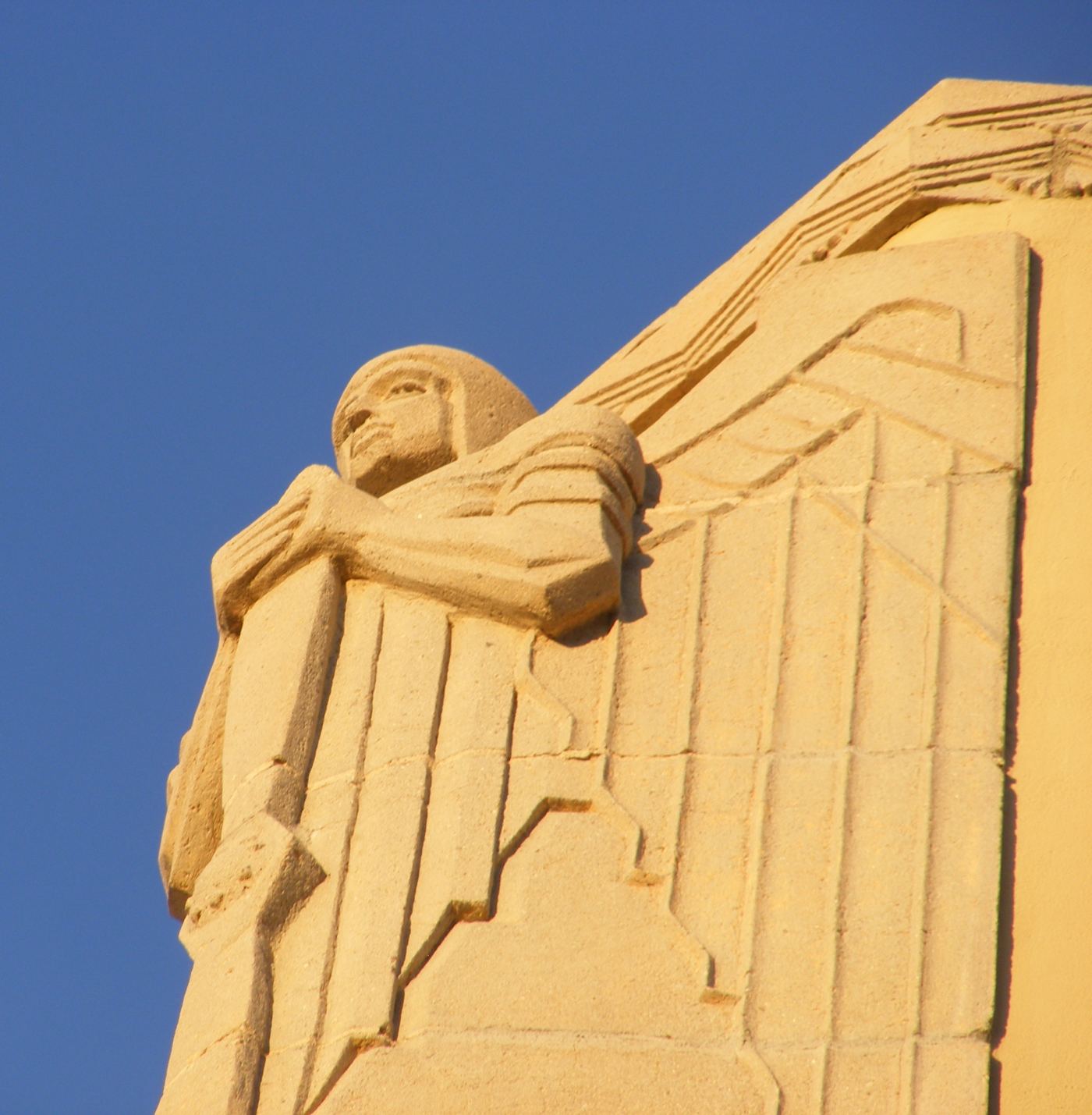
A 2/12/16 photo by G.B. Koontz of the artwork on the corner of the Grand Central Air Terminal tower.
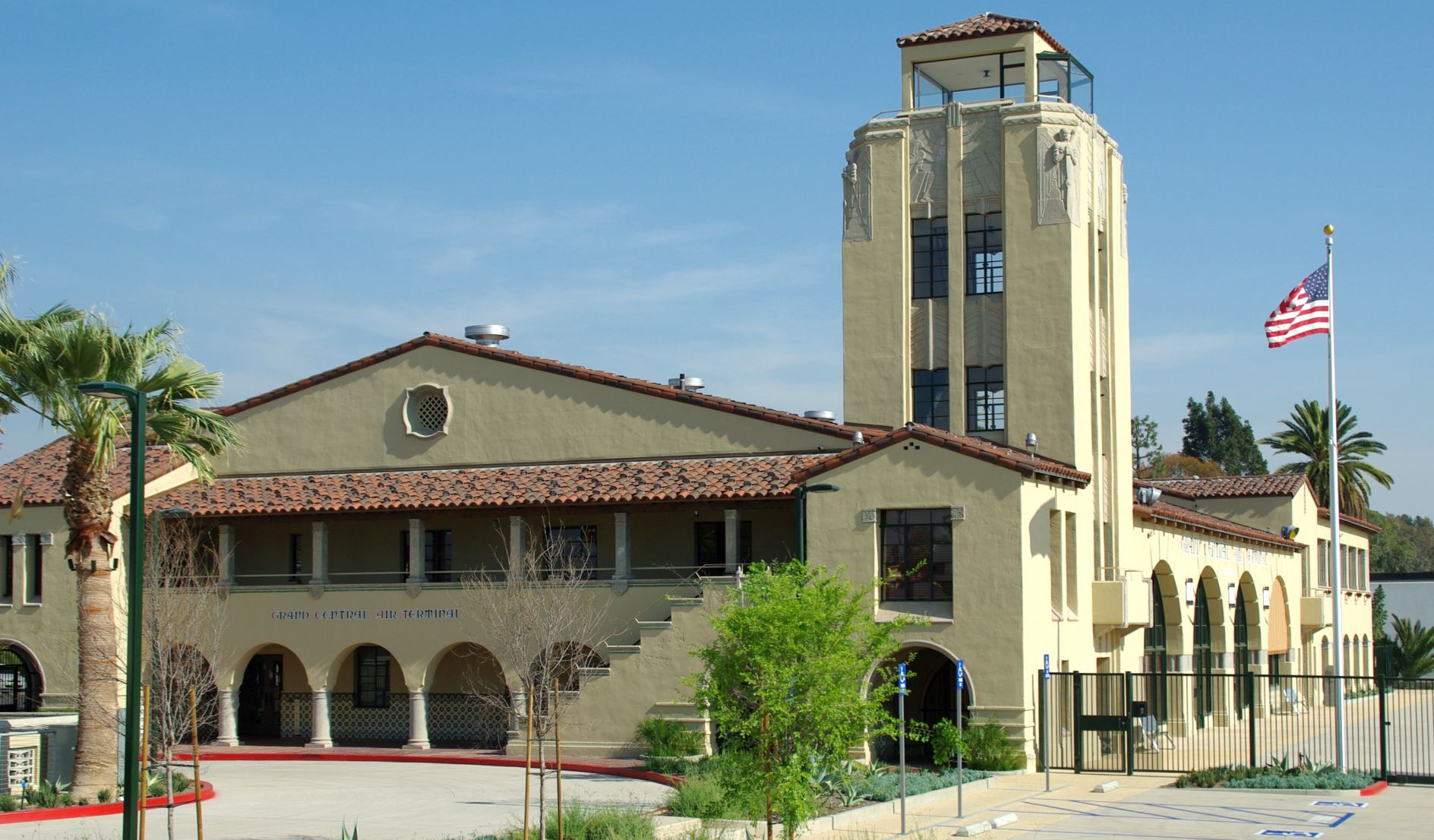
A circa 2017 photo by James Belknap of the nicely-restored Grand Central Air Terminal.
James reported, “Disney did, in fact, complete that very expensive restoration. But as a result they've been using the terminal building for their own purposes & it's now closed off to the public.
I'd hoped they would turn it into a museum or similar function, but that was not to be.”
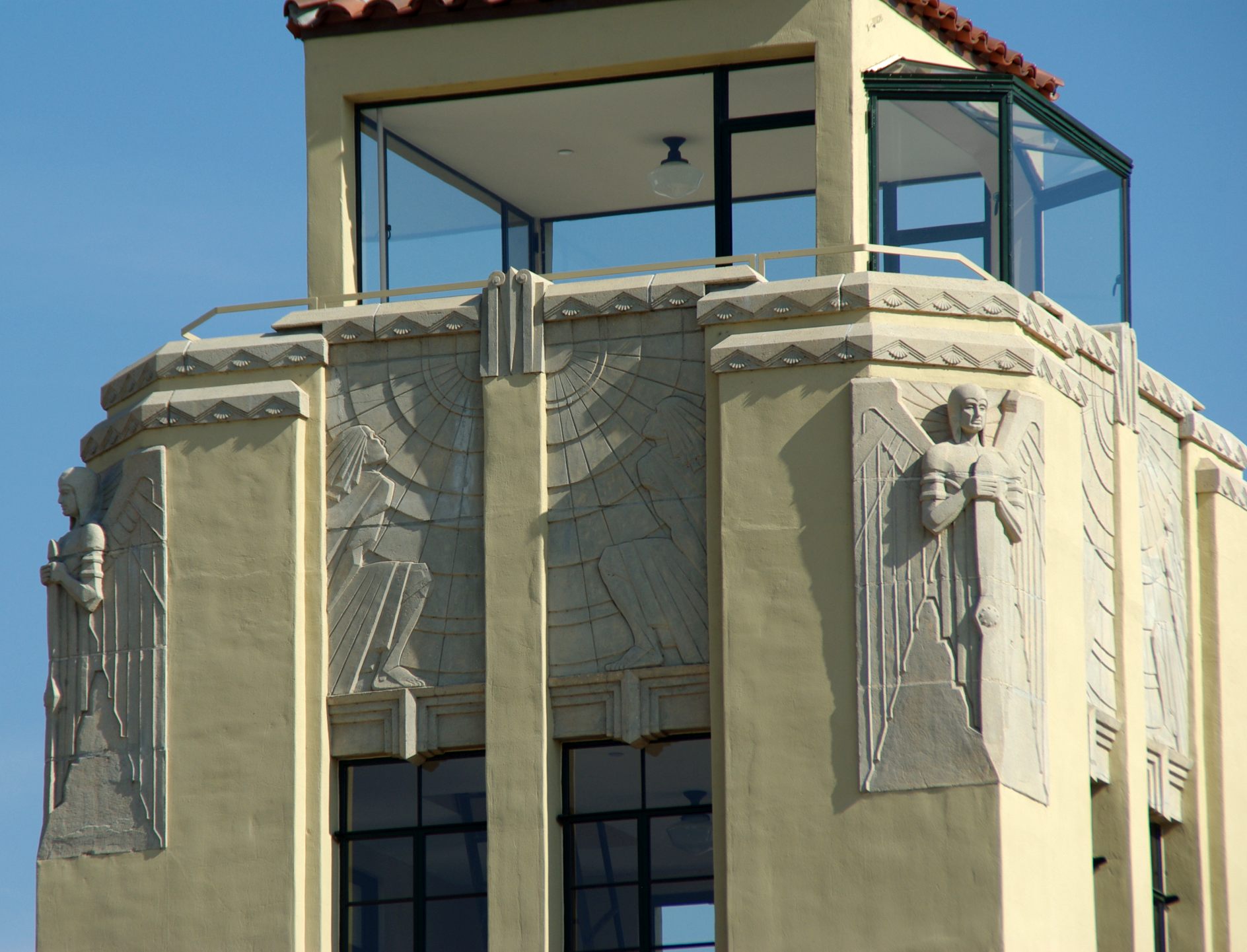
A circa 2017 photo by James Belknap of the nicely-restored Grand Central Air Terminal tower.
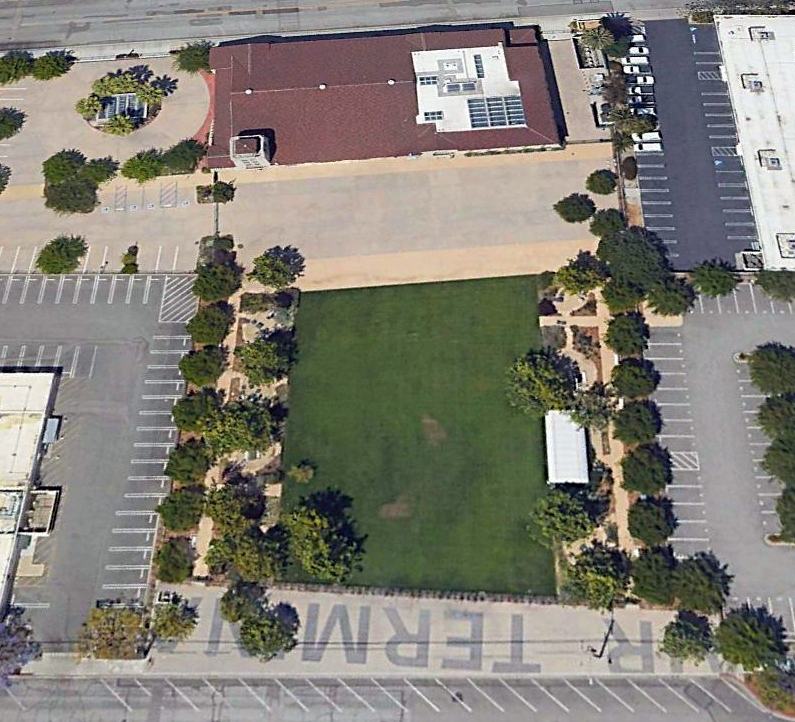
A 2021 aerial view looking northeast at the Grand Central Air Terminal building (at top).
When the grass plaza was constructed southwest of the terminal building in 2014-16, lettering spelling “AIR TERMINA” was painted along the new sidewalk at the bottom, but inexplicably omitted the last letter “L”.
As an aside, the Peterson Aviation terminal at Van Nuys Airport was constructed in the likeness of the Grand Central Air Terminal, according to Jim McNamara.
See also:
http://www.ci.glendale.ca.us/about/historic/grand_central.html
http://employees.oxy.edu/jerry/grandair.htm
____________________________________________________
Griffith Park Aerodrome, Griffith Park, CA
34.15, -118.283 (North of Downtown Los Angeles, CA)
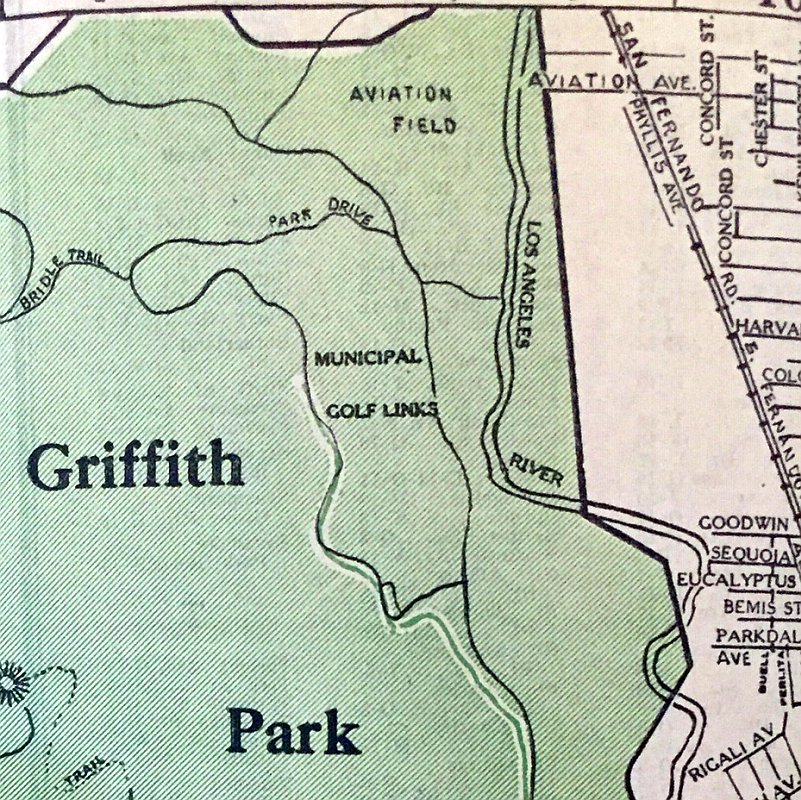
Griffith Park, “Aviation Field”, as depicted on a 1924 street map (courtesy of Kevin Walsh).
Griffith Park Aerodrome was located south of the LA River from Grand Central Air Terminal.
According to K.O. Eckland, in 1912 Van Griffith donated 100 acres of land alongside what is now Griffith Park Drive
with the request it be used to "do something to further aviation."
Once hangars were built, aviation pioneers like Glenn Martin & Silas Cristoffersen
seized the opportunity to operate from such an ideal location.
Martin's first fight school opened its doors that year & the name was unofficially changed.
The Griffith Park property was eventually handed over to State
for use by the National Guard Air Service's 40th Air Corps Division (115th Observation Squadron),
who established a base & laid 2 runways: 3,600' northwest/southeast & 2,975' oil & gravel north/south strips.
The 115th Observation Squadron was initially equipped with the Curtiss JN-4H Jenny.
The 115th was commanded by Maj. C.C. Moseley,
who was also one of the founders of Western Air Lines & the Cal-Aero Technical Institute flying schools.
The earliest depiction which has been located of Griffith Park Aerodrome was on a 1924 street map (courtesy of Kevin Walsh),
which depicted an “Aviation Field” without any other details.
Griffith Park Field, as depicted on a circa 1925 illustration of LA-area airfields from Ross Diehl's Air National Guard yearbook (courtesy of Dan MacPherson).

The earliest photo which has been located of Griffith Park Airport was an April 1925 photo looking west at 4 men in front of the Griffith Park hangars, with several JN4 Jenny biplanes visible inside the right hangar.
The photo's caption said “Proposed location of suggested mooring-mast”, presumably for airship operations.

A 1925 photo of the 115th Observation Squadron's first muster in front of the Griffith Park hangars (courtesy of Rex Ricks), with many of the men still in civilian clothes.

The earliest aerial view which has been located of Griffith Park Airport was a 7/12/27 aerial photo looking southeast,
showing Grand Central Air Terminal in the foreground, and Griffith Park Airport across the river.
Griffith Park consisted of a grass field with a hangar along the west side.

A 1927 aerial view looking northeast at the National Guard hangars at Griffith Park Airport, with 3 biplanes to the right.
Just across the river in the immediate background is the Slate dirigible hangar at Grand Central Air Terminal.
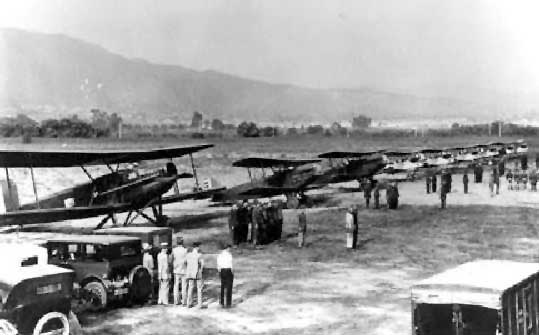
The aircraft include (from left) a Douglas C-1, 2 Douglas O-2Cs and 6 Consolidated DT-1s.
Will Adams recalled, “I grew up on Glendale & was 10 years old in 1927.
My stomping ground was the National Guard airport.
Times were different then & it was safe for a 10-year-old to wander all over the place.
I spent a lot of time at the National Guard Airport watching them fly in & out.
A 10-year-old kid hanging around didn't seem to bother them, and I had almost free run of the airport.
I clearly remember a movie scene they were shooting one time.
I think it was for Howard Hughes' Hell's Angels.”

A 1927 street map (courtesy of Kevin Walsh) depicted the Griffith Park airfield as “Los Angeles Air Port”,
with a rectangular property outline.

The location & layout of Griffith Park Airport from a 1927 Commerce Department Airway Bulletin (courtesy of David Brooks).
It described Griffith Park as a 157 acre rectangular sod field measuring 3,800' northwest/southeast,
with 2 steel hangars on the west side.
The owner was listed as the City Park Board, “leased to the State of CA for use of State Militia”.

The 1928 USGS topo map depicted Griffith Park “National Guard Airport” as an open area without any specific runways.
It also depicted the nearby “Grand Central Airport” to the north.

A circa 1928 photo of an unidentified biplane in front the of the CA National Guard hangars at Griffith Park (courtesy of Dave Doherty).

The earliest aeronautical chart depiction which has been located of Griffith Park Airport was on the 1929 LA – Las Vegas Air Navigation Map.

“G.P. Airpt”, as depicted on 1929 LA County map (courtesy of Mark Shoemaker).
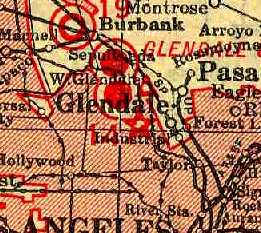
Griffith Park Aerodrome, as depicted on the 1929 "Rand McNally Standard Map of CA With Air Trails" (courtesy of Chris Kennedy).

Griffith Park Aerodrome was depicted simply as a property outline labeled as “Aviation Field” on a 1930 street map (courtesy of Kevin Walsh).

An undated aerial view looking east at the “Los Angeles California National Guard” Airfield
from the 1930 Richfield Airport Directory (courtesy of Jonathan Westerling).
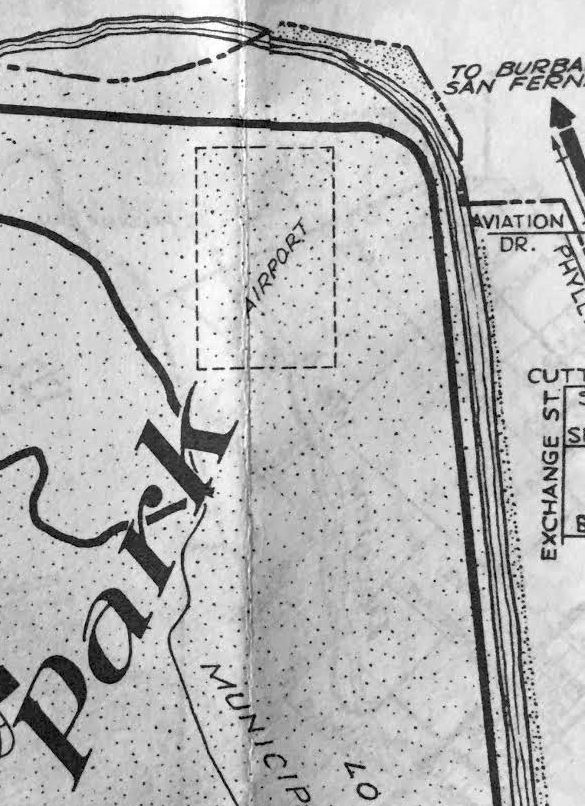
Griffith Park Aerodrome was depicted simply as a rectangular property outline labeled as “Airport” on a 1931 Automobile Club of Southern CA map (courtesy of Kevin Walsh).
Also note “Aviation Drive” to the east.

A 1932 photo of 2 unidentified biplanes in front the of the CA National Guard hangars at Griffith Park (courtesy of Ross Diehl, via Dan MacPherson).

The earliest Sectional Chart depiction which has been located of Griffith Park Aerodrome was on the June 1932 LA Sectional Chart.

A 1/13/34 aerial view (from the UCSB Library) showed Griffith Park Aerodrome to have a single north/south grass runway, with a hangar along the west side.
There were no aircraft visible on the field.
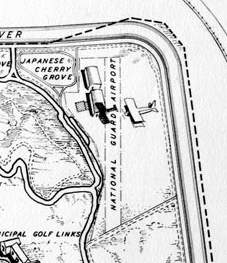
A 1935 map depicted the “National Guard Airport” as having a single unpaved north/south runway, with 2 hangars on the northwest side.

The 1935 H.M. Gousha / Shell Oil LA map (courtesy of Michael Binder) depicted the “California National Guard Airport” as an irregularly-shaped property outline.

A 1936 aerial photo, looking south, showing the proximity of Griffith Park Aerodrome (upper right) to the Grand Central Air Terminal (foreground, across the LA River)
Photo is courtesy of Ross Diehl (whose father flew out of Griffith Park Aerodrome), via Dan MacPherson.
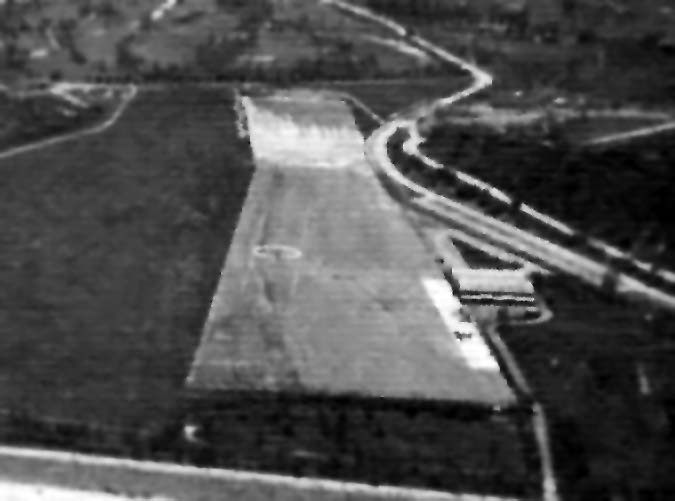
A closeup of Griffith Park Aerodrome from the above 1936 photo (courtesy of Ross Diehl, via Dan MacPherson).
A 1936 Commerce Department listing of airports & landing fields described Griffith Park
as being a military airfield with a single north/south oiled runway (1,965' x 192'),
and a single hangar with "40th Division Air Corps" on the roof.
As can be seen in the above 1936 aerial photo, the runway at Griffith Park had an unusual shape,
with the north end being about twice as wide as the south end.
The Airport Directory Company's 1937 Airports Directory (courtesy of Bob Rambo)
described Griffith Park as having a single 1,965' oiled runway.
The hangar had "40th Division Air Corps" painted on the roof.

A 3/10/38 aerial view (from the USCB Photo Library) showed Griffith Park Aerodrome to have a single north/south grass runway,
with a hangar & a dozen unidentified single-engine aircraft along the west side.

A circa 1930s panoramic shot looking southwest at the Griffith Park hangars.

Griffith Park National Guard Airport & the nearby Grand Central Air Terminal, as depicted on a 1938 Rand-McNally Texaco map (courtesy of Kevin Walsh).
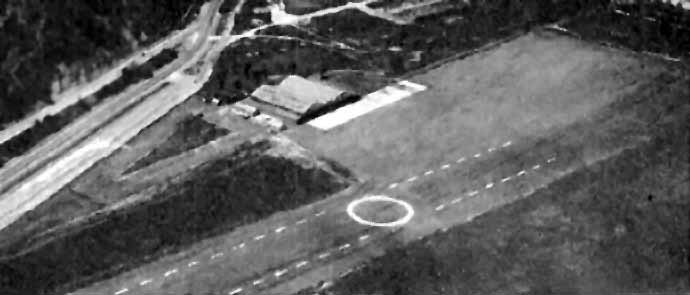
An aerial view looking northwest at Griffith Park Aerodrome
from The Airport Directory Company's 1938 Airports Directory (courtesy of Jonathan Westerling).
The directory described the field as having a single 3,000' north/south paved runway,
with a hangar marked with “40th Division Air Corps” marked on the roof.
No aircraft were visible on the field.
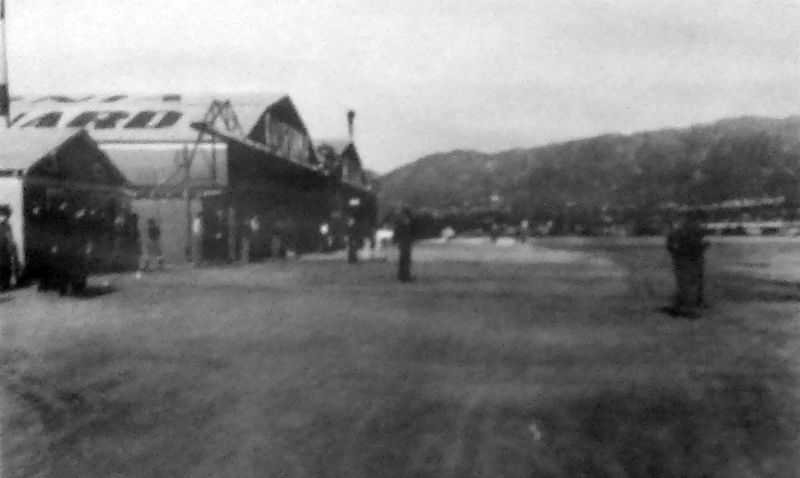
An undated photo of the “Completed hangars” at Griffith Park, from a 1/1/39 Works Projects Administration report (courtesy of Andrew Laverdiere).
The report described “Project 5517, CA National Guard Airport, Los Angeles” as having cost $35,980, using an average of 40 men/month, and lasting for 8 months.
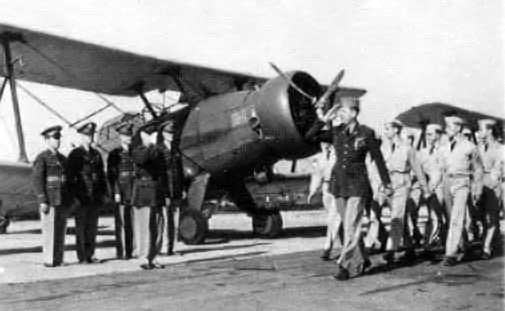
The last photo which has been located showing Griffith Park Aerodrome in operation
Training missions were flown from Griffith Park until 1939,
at which time the city Planning Commission charged that a military airport violated conditions of the original land deed.

Griffith Park National Guard Airfield, as depicted along with several other nearby airfields on the 1939 LA County Airports Map.

Griffith Park National Guard Airport & the nearby Grand Central Air Terminal, as depicted on the 1939 LA County Airports Map.
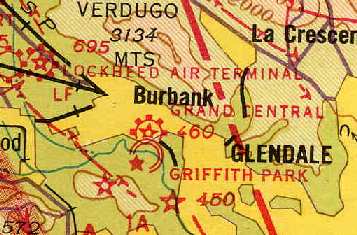
Griffith Park was still depicted as a military airfield on the 1941 LA Sectional Chart (courtesy of Chris Kennedy).
The 1942 USGS topo map depicted the open area of Griffith Park Aerodrome,
but did not label it at all (most likely due to wartime security concerns).
By 1942, the National Guard squadron had relocated from Griffith Park to the new Van Nuys AAF,
and the Griffith Park Aerodrome was evidently closed.
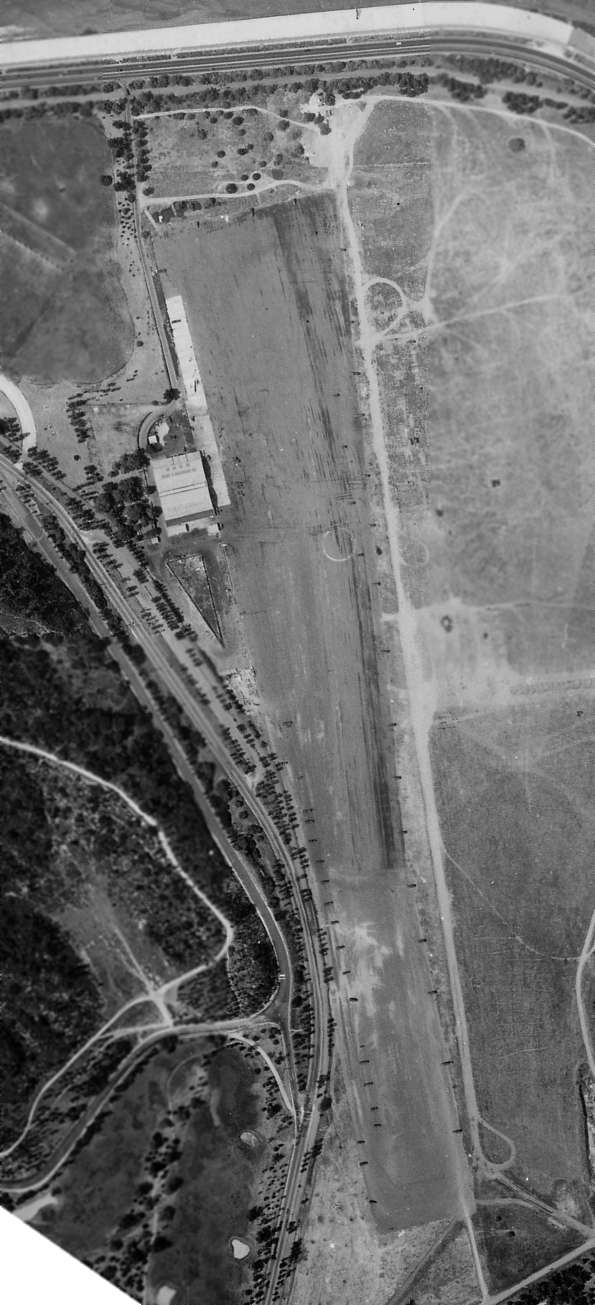
The last photo which has been located showing the Griffith Park Aerodrome remaining intact was a 6/6/42 U.S. Navy aerial view (courtesy of Brian Rehwinkel).
The hangar & runway remained intact, but the field appeared abandoned.
The Griffith Park Aerodrome was not depicted at all on the 1944 LA Sectional Chart (courtesy of John Voss).

A 1945 Thomas Brothers map (courtesy of Kevin Walsh) depicted the “California National Guard Aviation Field”
as having 4 rectangular buildings along the west side, and an unusually-shaped building along the east side.

The 1948 USGS topo map still depicted the “National Guard Airport”,
even though it had evidently been closed for several years by that point.

A 1949 street map depicted the site of Griffith Park as occupied by “Rodger Young Village”,
which was a temporary Quonset hut village for returning GI's & their families.
An undated aerial view from the 1950 Air Photo Guide (courtesy of Kevin Walsh)
showed dozens of Quonset huts of Rodger Young Village covering the airfield area of Griffith Park.
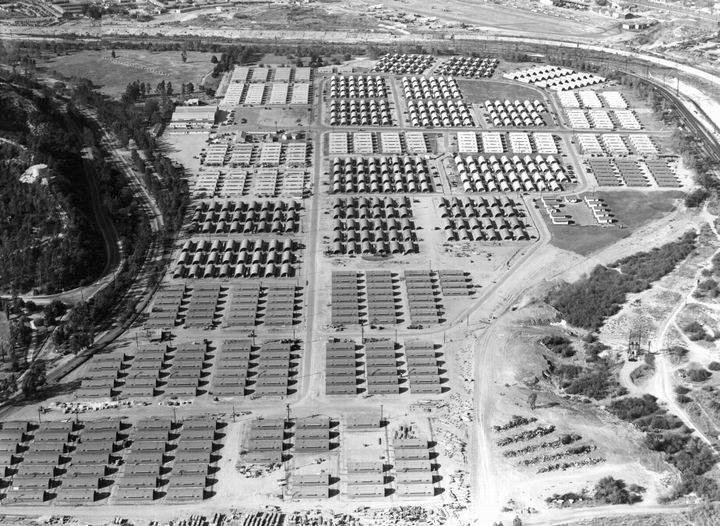
A 1952 aerial view (courtesy of Kevin Walsh) depicted the hundreds of Quonset huts of Rodger Young Village covering the airfield area of Griffith Park,
but the former hangar remained standing along the west side of the property.
Also note the runway of Grand Central Air Terminal barely visible in the background.

The 1953 USGS topo map (courtesy of Kevin Walsh) labeled the site of Griffith Park Aerodrome as Rodger Young Village.
A 1954 aerial view showed that all of the Quonset huts of Rodger Young Village had been removed at some point between 1952-54,
but the former hangar remained standing, all alone.
A 1972 aerial view showed that the former hangar had been removed at some point between 1954-72,
with all traces of the former airfield having been replaced by a parking lot for the Griffith Park Zoo.
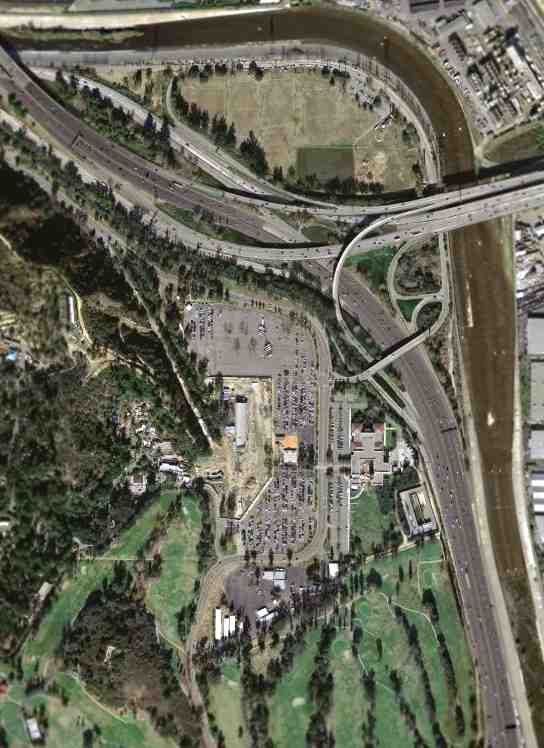
A March 2004 USGS aerial photo showed the Griffith Park Aerodrome site has been covered by the Griffith Park Zoo, with no trace remaining of the former airfield.
Drew Laverrdiere reported in 2015, “Griffith Park Aerodrome... one of the park rangers told me about a remaining structure still at the park on a hill called Beacon Hill
where there is still the foundation of a former beacon tower that was built for the airfield.”
The site of Griffith Park Aerodrome is located at the present day intersection of Interstate 5 & Route 134.
Thanks to Dan MacPherson for pointing out Griffith Park Aerodrome.
____________________________________________________
34.18, -118.278 (North of Downtown Los Angeles, CA)
A 1921 photo by Delmar Watson of a fly-in at Brand Field, with several DH-4Bs from March Field, Neta Snook's white Curtiss Jenny, and several Pacific Standards
(from "Madcaps, Millionaires and Mose" by John Underwood, via Dan MacPherson).
Millionaire Leslie Brand built a mansion, named El Miradero, in 1904.
At an unknown date between 1904-1921, Brand established a grassy, well-manicured airfield in front of the mansion.
The airfield consisted of a 1,200' rolled dirt runway, with a white hangar at one end & a putting green on the other.
The hangar matched the architectural style of the mansion - with turrets atop each of the 4 corners.
The earliest depiction which has been located of Brand Field was a 1921 aerial view,
which depicted a hangar along the north side of a grass field, with 6 biplanes in attendence.
An undated photo by Margaret Beacon of millionaire L.C. Brand mowing the grass in front of his hangar
(from "Madcaps, Millionaires and Mose" by John Underwood, via Dan MacPherson).
Brand Field was listed in a 1923 LA Chamber of Commerce table of LA-area airports (courtesy of K.O. Eckland).
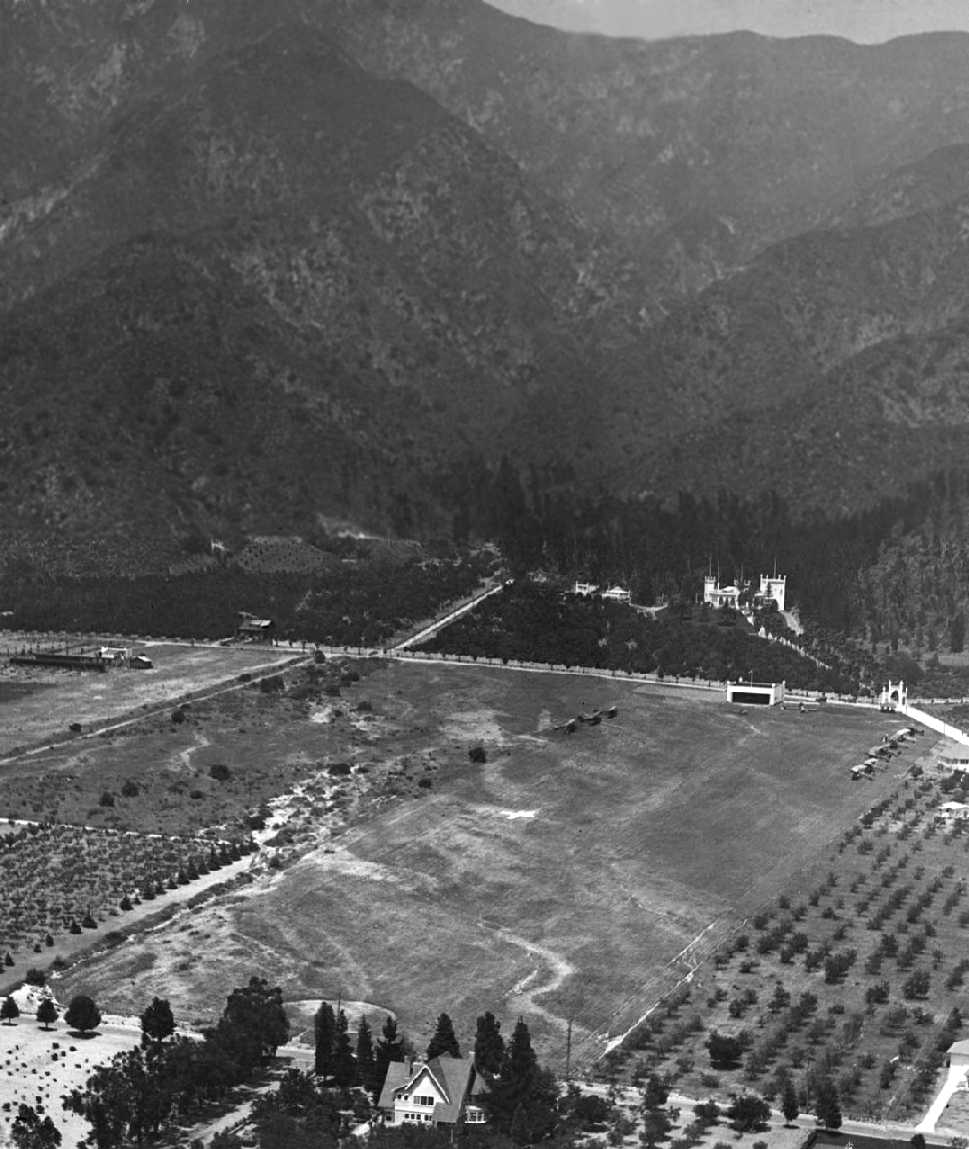
A 1923 aerial view looking north at Brand Field, showing the hangar & 10 aircraft on the field, and the mansion across the street.
Note the steep terrain – obviously takeoffs to the north wouldn't be advisable.
Only 3 aircraft are known to have been actually based at Brand Field,
but Leslie Brand apparently bought many war surplus Jennies,
some to tinker with & fly as a sport, although most languished in storage buildings.
After Leslie Brand died in the house in 1925, his property was bequeathed to the city.
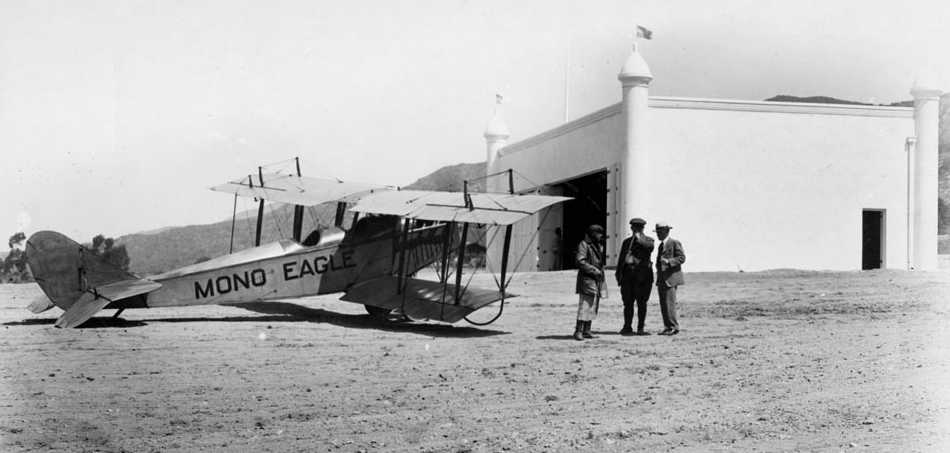
A circa 1927 photo of a Curtiss JN4 Jenny marked “Mono Eagle” & 3 men standing in front of Brand Field's distinctive hangar.
Brand Field was no longer depicted on a 1931 street map (courtesy of Gary Alexander),
but “Brand Park” was depicted, so the airfield may have ceased operation by that point.
Brand Field was also not depicted on the June 1932 LA Sectional Chart,
a 1941 street map (according to Chris Kennedy), or the 1942 USGS topo map.
A 1952 aerial photo showed that the area formerly occupied by Brand Field
had been redeveloped with dense housing, with no trace remaining of the hangar.
By 1956 the mansion had been converted into the Brand Library.

A circa 1980s photo of a Bell 212 firefighting helicopter departing from the Brand grounds, with the Brand Castle visible at bottom-right.
A recent photo of the Brand Castle.
A 2002 photo by Danny Wilson of a former airport beacon light tower which remains standing at the site of Brand Field.
Danny Wilson reported in 2003, "As for Brand Airport, until recently I had no idea there was ever an airport there.
But over the years I did notice an unusual structure sitting up in the hills.
It is a corrugated-steel cylinder with some sort of rotating housing on top.
There are circular canisters atop the cylinder which looked to have once house lights.
I did some research & found that this used to be one of a pair of rotating beacons that guided pilots to the airfield.
There was another beacon northwest of this one that has been lost to the elements and/or vandals.
This one still exists & is in fairly decent condition, given the circumstances.
[The above photo of the tower] was taken in 2002, and the structure was still standing as of 2003."

A 2016 aerial photo shows the Brand Mansion still stands (at the top-right corner of photo),
but the area of the former airfield has been covered by dense housing.
The site of Brand Field is located southwest of the intersection of Grandview Avenue & West Mountain Street.
____________________________________________________
Vail Field / Western Air Express Airport / Vail Airport, Montebello, CA
34.004, -118.134 (Southeast of Downtown Los Angeles, CA)

The caption for this photograph from the Los Angeles Examiner reads:
Western Air Lines in 1926 began operations from Vail Field.
Vail Field was historically important as one of the first airmail contractors, Western Air Express, had its origins there.
Western Air Express was incorporated during 1926 by Los Angeles entrepreneurs
for the purpose of bidding on airmail contracts to be awarded under the 1925 Kelly Air Mail Act
which provided for the transfer of airmail routes from the Post Office's Aerial Mail Service to private carriers.
WAE initially purchased 6 Santa Monica-built Douglas M-2 mail planes.
They also purchased land to build the airport from some well-known cattle ranchers, the Vail brothers.
The property was by Ferguson Drive on the north, Telegraph Road on the south,
Yates Avenue on the east, and Tusbway Avenue on the west.
The enormous field had 2 unpaved runways, one of which ran directly along Yates Avenue.
The length of the runways is unknown, but the total length of the property along Yates Avenue was approximately 6,000'.
A converted movie studio became the main hangar.
According to Dan MacPherson, in addition to the original hangar, Vail eventually had a large 4 building hangar complex.
Years later, these hangars were moved to Alameda Street, and occupied by the Belyea Trucking company.
They may still exist, could not be located.
The first CAM-4 contract airmail service to Las Vegas & Salt Lake City by WAE began in 1926,
with the first flight being piloted by Maury Graham.

A 1927 aerial view of the crowd viewing Charles Lindbergh's landing of The Spirit of St. Louis at the Vail Field
while on a nationwide tour following his transatlantic flight,
from an LA Chamber of Commerce brochure “Los Angeles County Spreads Her Wings, History of National Air Races, 1928” (courtesy of Tom Heitzman).
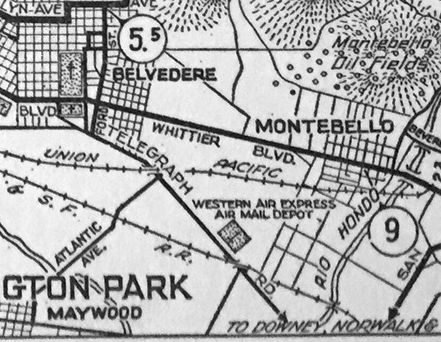
Western Air Express Air Mail Depot Airport, as depicted on a 1927 ACSC map (courtesy of Kevin Walsh).
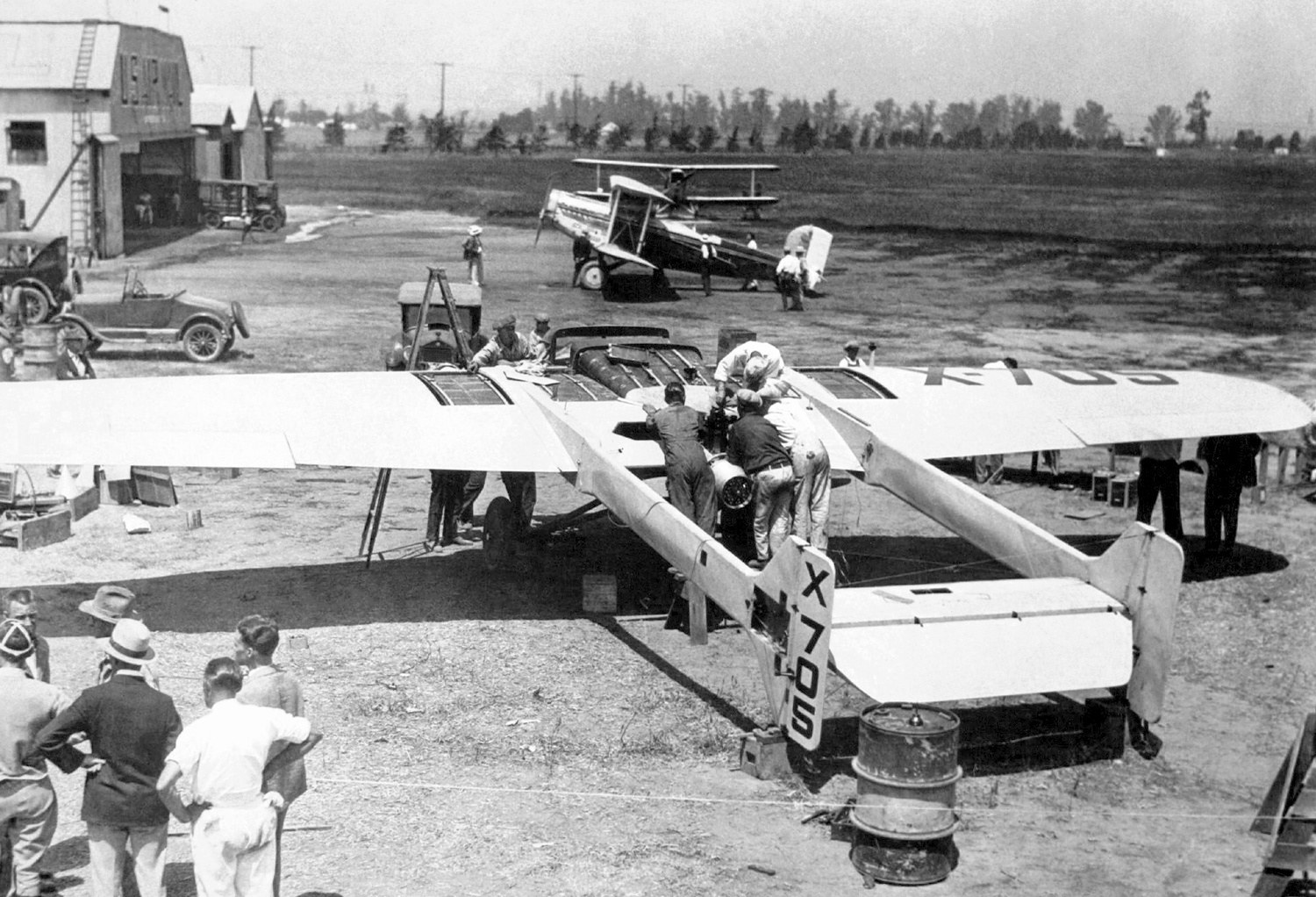
A July 1927 photo of the Bryant M-1 Angel of Los Angeles NX705, built at Vail Field in 1927.
It was a push-pull configuration with 2 Bristol Lucifer engines, and was built to compete in the Dole Air Race, but it crashed on August 12, 4 days before the race start.
A Western Air Express Douglas M-2 mailplane & a hangar are in the background.
The Lone Eagle CM-1 was built at Vail Field in 1928 by the Ryan Mechanics Monoplane Company.

An undated photo of a trimotor (model undetermined) in front of the Western Air Express hangars at Vail Field,
from an LA Chamber of Commerce brochure “Los Angeles County Spreads Her Wings, History of National Air Races, 1928” (courtesy of Tom Heitzman).

Western Air Express Airport, as depicted among an amazing total of 55 LA-area airports on a map from an LA Chamber of Commerce brochure
“Los Angeles County Spreads Her Wings, History of National Air Races, 1928” (courtesy of Tom Heitzman).
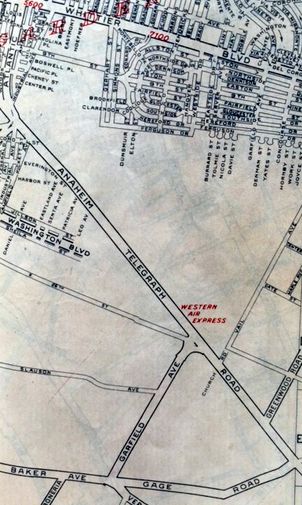
Western Air Express Airport, as depicted on a 1929 Gillespie's Guide & Atlas of LA (courtesy of Kevin Walsh).
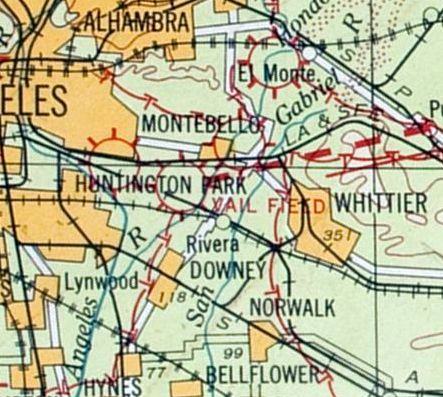
The earliest aeronautical chart depiction which has been located of Vail Field was on the 1929 LA – Las Vegas Air Navigation Map.

A 1929 photo of 2 biplanes at Vail Field, showing a large open expanse of land.
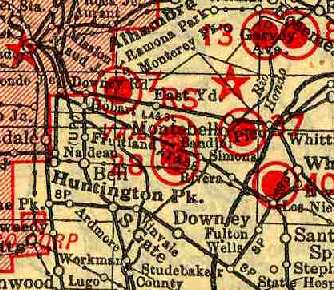
Vail Field (along with a dense grouping of other vintage airfields),
as depicted on the 1929 "Rand McNally Standard Map of CA With Air Trails" (courtesy of Chris Kennedy).
The directory described "Air Mail Airport (Vail Field)" as being operated by Western Air Express, and measuring 4,767' x 3,176'.
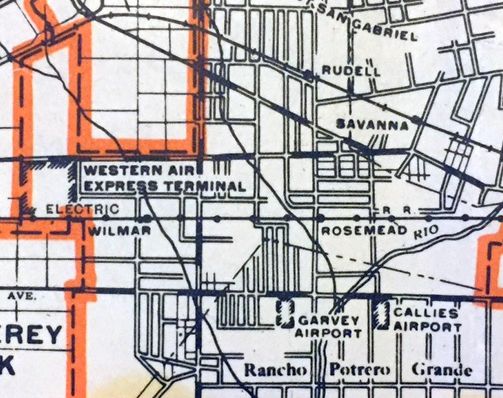
“Western Air Express Terminal”, as depicted on a 1930 LA County Rand McNally street map (courtesy of Kevin Walsh).

A circa 1930 photo (courtesy of Ken Meade) of his father's (C.S. Meade) 1918 Buick towing a glider at Vail Field.
Ken Meade recalled of Vail Field, “My Father learned to fly automobile-towed gliders there in 1929 or 1930 that belonged to a club sponsored by Union Oil Company.
They had 2 gliders there.”

A circa 1930 photo (courtesy of Ken Meade) of a Detroit Gull glider trainer at Vail Field.
Ken observed, “My Father, C.S. Meade, is on the far left. Dad held Gliders Pilots License #234 after he soloed in the aircraft.
All paid for by Union Oil for the employees in the Glider Club flying off of Vail Field. roit Gull Trainer.
The date, shortly after the Lindbergh flight & the subsequent attention to aviation,
may have been the motive for Union Oil to support a Glider Club!
Considering how it got in the air burning lots of good Union Gasoline!”
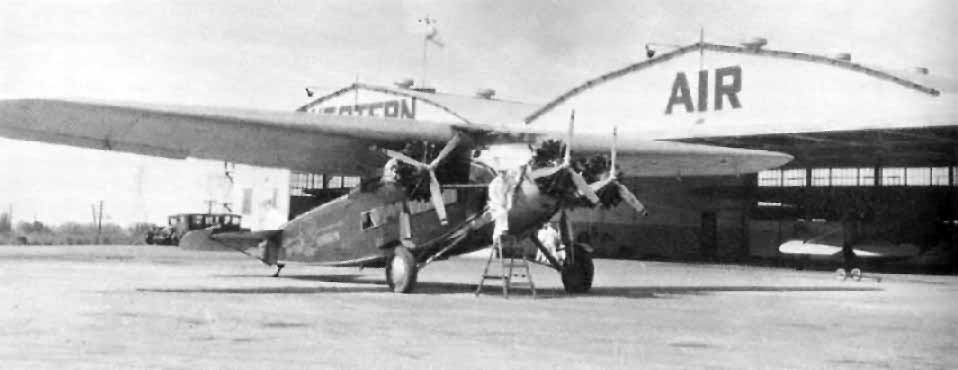
An undated photo of a Fokker F-10 in front of the Western Air Express hangars at Vail Field (courtesy of Dan MacPherson).
The original Vail Field ceased being an airport when Western Air Express moved to Alhambra Airport in 1930.

A 1931 street map (courtesy of Gary Alexander) still depicted Vail Field,
even though it had evidently ceased as an operating airport the year before.
Will Adams recalled, “In 1939, I signed up for & got my private pilot's license at Helen Hudson's flying school at Vail Field in Montebello.”

A circa 1939-40 Mobil map (courtesy of Dan MacPherson) showing Vail Airport,
as well as 3 other nearby fields: Telegraph Atlantic Airport to the northwest, Los Angeles Eastside Airport to the South,
and Whittier Airport to the east (penciled in).
According to Dan, the map is not entirely correct: The property shown as "Vail Airport" is actually the scope of the original Vail Field.
Vail Airport was eventually built within a northern subset of the original Vail Field property. Montebello airport had not been built yet.
Vail Field sat idle until 1940.
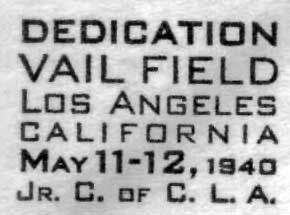
A postmark commemorated the 5/11/40 Dedication of Vail Field.
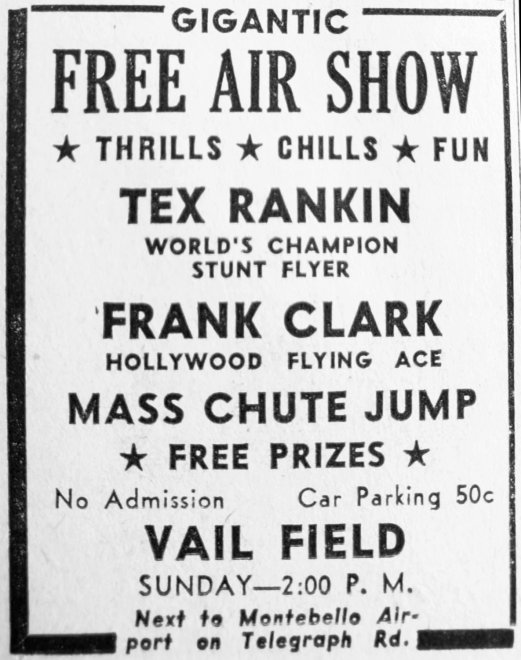
A 1940 advertisement for an airshow at Vail Airport (courtesy of Kevin Walsh).
The history of this field gets confusing at this point, as Vail Airport (as opposed to the original Vail Field) was built in 1940.
Vail Airport occupied a subset of the original Vail Field property, roughly the northern half.
It was located adjacent to a Chevron oil tank farm (which remains there today).
The airfield consisted of a single 3,200' oiled runway, a taxiway, a large ramp, and at least 2 hangars.
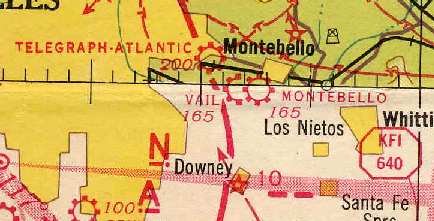
Vail Airport (along with nearby Telegraph-Atlantic & Montebello Airports),
as depicted on the 1941 LA Sectional Chart (courtesy of Chris Kennedy).

A 7/20/43 aerial view looking north at Vail Field from the 1945 AAF Airfield Directory (courtesy of Scott Murdock)
depicted the field as having a single runway, with a taxiway leading to a ramp & hangar on the west side.
"Vail" was described by the 1944 US Army/Navy Directory of Airfields (courtesy of Ken Mercer) as having a 3,000' surface runway.
The remarks said, "Civil operation subject to 4th Fighter Command Requirements."

A circa 1940s aerial view (courtesy of Dan MacPherson) of Vail Airport (top of picture),
along with Montebello Airport (bottom of picture, across Yates Avenue to the south).
The 1945 AAF Airfield Directory (courtesy of Scott Murdock) described Vail Field
as a 417 acre irregularly-shaped field within which was a single 2,650' oiled NNE/SSW runway.
The field was said to have 2 hangars: 104' x 96' metal, and 50' square metal & wood.
The airport was described as being privately owned & operated.
Gary Priebe recalled, “From 1946-56, I lived near Vail Field in a small pie-shaped single-family development
bordered by Washington Boulevard & Anaheim/Telegraph Road, known as Rosewood Park & now the City of Commerce.
As kids we ran the fields chasing pheasant with our bows & arrows (with little luck)
and floating rafts on the large, deep gullies around Vail Field - Jim, Larry & myself.”
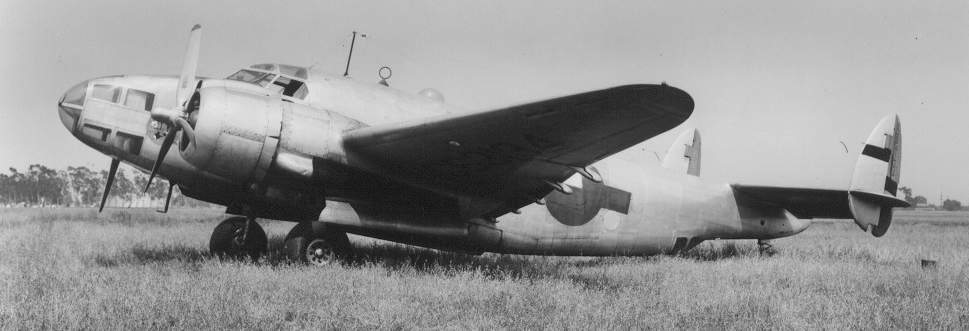
A Lockheed RB-34 Ventura patrol bomber, NC 63134, AF 41-38071, parked at Vail in 1946.
In the background is the Chevron tank farm (surrounded by eucalyptus trees), which is still present at the site.
Photo is courtesy of William Larkins (aviation historian & photographer for over 50 years), via Dan MacPherson.

A photo captioned "A Fairchild AT-21 surplussed at Vail Field 5/17/46” (courtesy of Marc Kenton).

The 1947 LA Local Aeronautical Chart depicted Vail as having a 2,700' unpaved runway.

This photo appeared with the caption "W.H. Coffin Air Service, Vail Field Airport, Los Angeles, CA",
in the 1947 book "Airport Operation & Management", by Charles Zweng, courtesy of Steve Cruse.
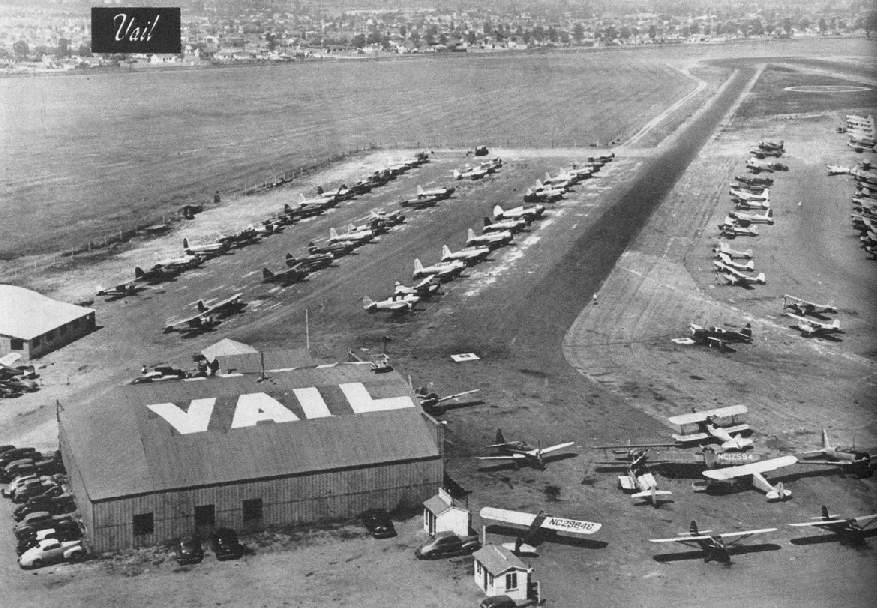
A 1947 photo of Vail by Don Downie, courtesy of Dan MacPherson.
The original caption reads, "Twenty-one A&E mechanics service the 220 planes based on this busiest airport is LA County.
Seven miles east of the city, the port has a single 3,200' oiled runway no tower - and an air traffic problem.
Tie-down is $15 monthly. Nearest transportation is 1/2 mile."
John Shelton reported in 2004 that he believes the hangar pictured in the above 1947 photo
still exists in 2004, after having been relocated to Whiteman Airport.
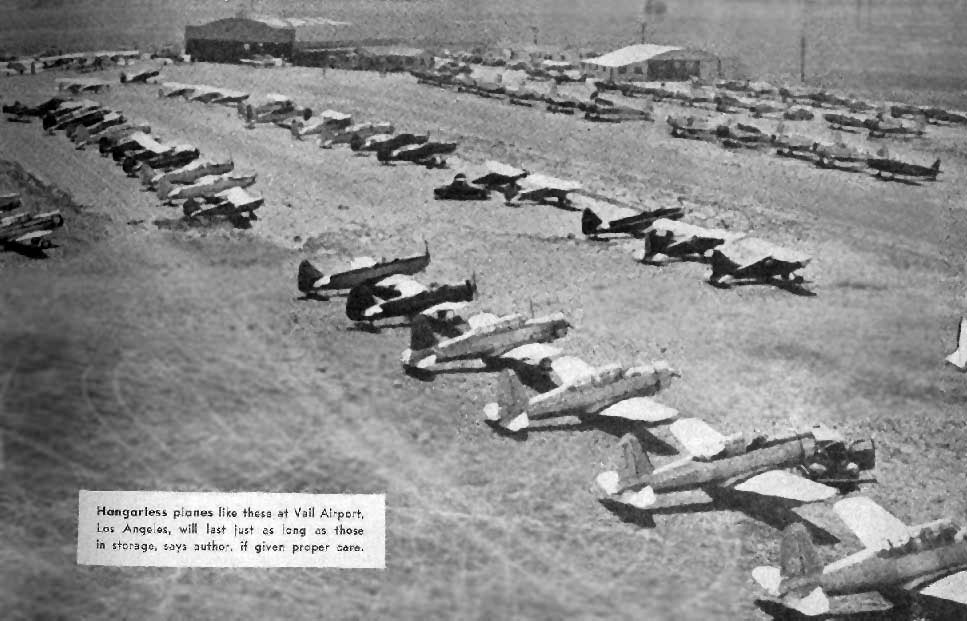
Another 1947 photo of Vail by Don Downie (courtesy of Dan MacPherson).
Note the large number of surplus former military aircraft - a collection which would be worth millions of dollars today!

A 1947 street map (courtesy of Kevin Walsh) depicted Vail Field along with the nearby Montebello Airport.
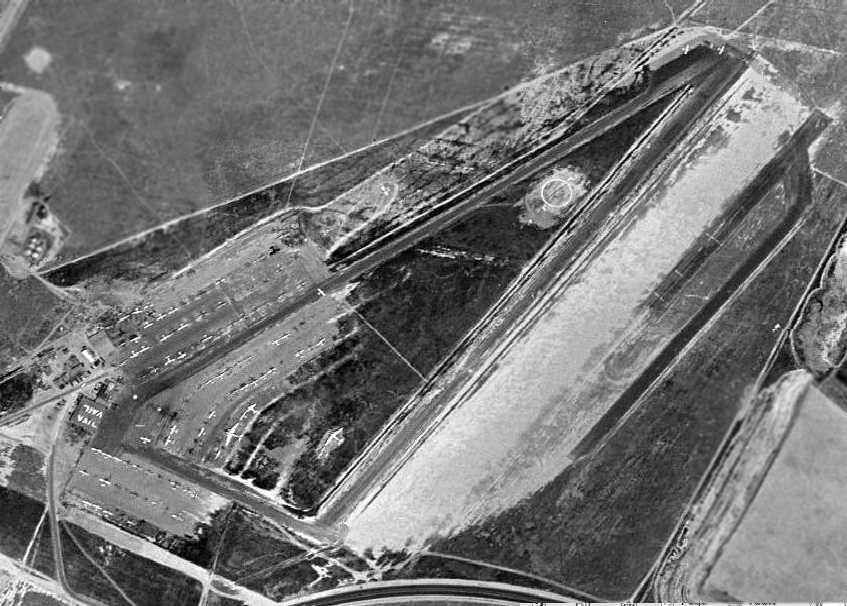
A 1948 aerial view depicted Vail Field as having 2 paved runways,
along with what appears to be an abandoned paved runway on the east side, along with its own parallel taxiway.

A closeup from the 1948 aerial photo,
showing an amazing number & variety of aircraft based at Vail Field, including 2 DC-3s.
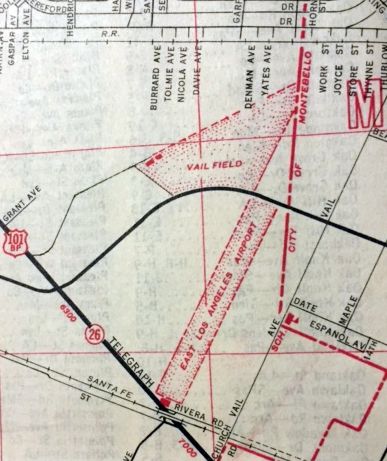
Vail Field (& nearby East Los Angeles Airport), as depicted on a 1950 street map (courtesy of Kevin Walsh).

An advertisement for Vail Field's Sky Store from the 1950 Air Photo Guide (courtesy of Jonathan Westerling).
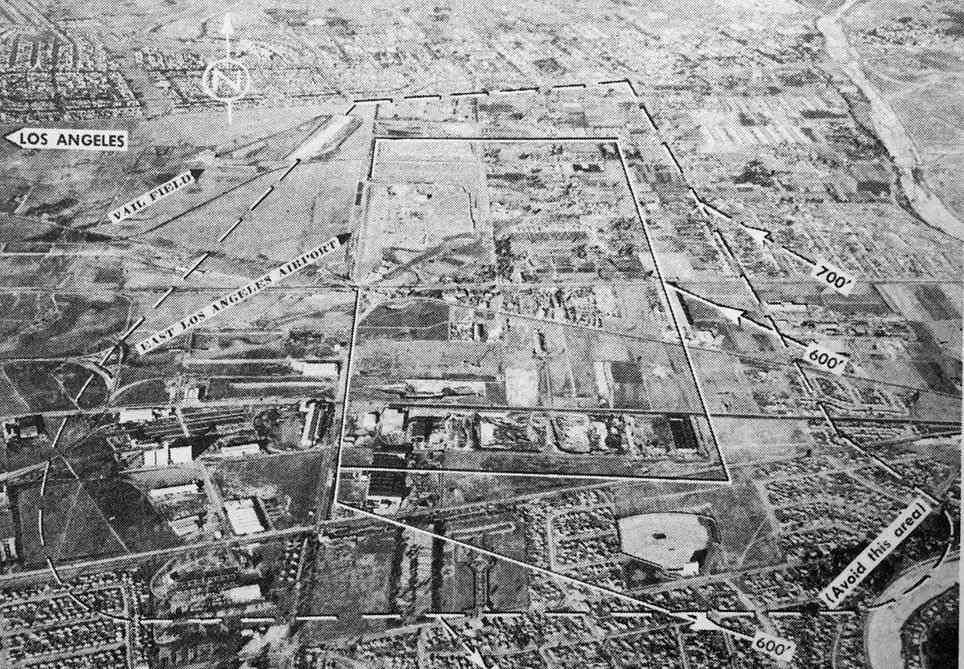
The last photo which has been located of Vail Field was an undated aerial view looking north from the 1950 Air Photo Guide (courtesy of Kevin Walsh).
The guide described Vail Field as having a 2,600' paved north/south runway, and listed the manager as W.H. Coffin.
In 1950, pilots from the 11th Coast Guard Auxiliary District were described as operating out of Vail Field,
flying search & rescue patrols over the mountains & deserts of southern California.
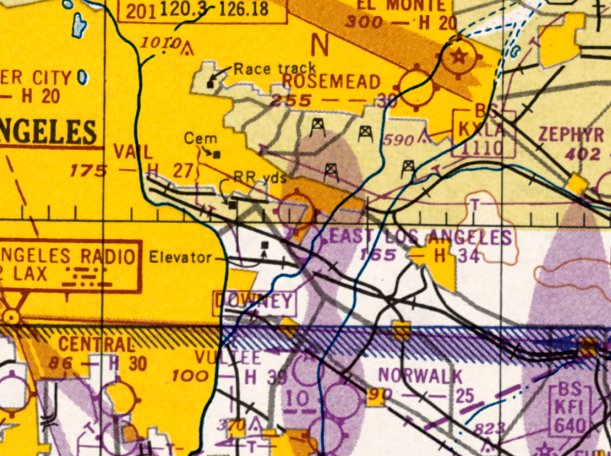
The last aeronautical chart depiction which has been located of Vail Field was on the September 1950 LA Sectional Chart,
which depicted it as having a 2,700' unpaved runway.
Bob Cannon recalled of the 1950s, "I rode my bike to Vail one day, all the way from Alhambra.
I stood on my toes to talk to a lady at a trailer-like office to see about getting flying lessons.
I'll never forget the name of the FBO: Coffin Flying Service!"
Gary Priebe recalled, “In the summer of 1952 while playing on the outer Vail Field, we noticed a 2-engined (radial) plane
over near the hangars so decided to go over & take a closer look.
It was not a sleek-type of plane but the fuselage was more of a square-cornered type, maybe like a Cessna AT-17 or Beech 18;
it was grey or olive drab in color & not plush at all inside so maybe military or a derivative?
There weren't many planes around & as we watched the mechanic working on the plane he was very friendly & spoke to us about his work.
He stated that he would soon be testing the plane & asked if we would like to go for a ride!
He stated that if we could get a signed permission slip from each parent, he would take us up.
Well, needless to say we ran back to Rosewood Park ASAP & did get these slips - this looked like our lucky day!”
Gary continued, “As we returned the mechanic was testing the engines & after a period he made some additional checks
after which time he said 'We are ready to go up' so we loaded up.
As we entered the plane, he asked who was the oldest & it was Jim (12) so he got to sit in the copilot's seat & Larry & I sat in 2 seats behind.
He ran the engines a while & then taxied out & we quickly took off - flying high over Montebello & East L.A.
I just couldn't believe we were flying & will never forget the experience of my 1st flight.
We landed after an all-too-short flight, got off & went back to our rafting.”
Gary continued, “Vail Field closed down in the mid-1950s & soon was graded.”
Vail Field was closed by 1953, as a 1953 aerial photo showed that Garfield Avenue had been extended through the property,
with the runway & hangars having been cleared & replaced by new streets.
Vail Field was no longer depicted at all on the September 1954 USAF LA Sectional Chart (courtesy of Chris Kennedy).
According to Dan MacPherson, Vail Field was "long gone by 1955."
A 1956 street map depicted streets having covered the site of Vail Field.
Gary Priebe recalled, “About 1957, a large & very long building was erected on the Vail site, fronting on Yates Street.
This was to be the Western Electric Company, the supply arm for the Bell T&T company.
This was a huge operation & employed thousands manufacturing & performing services on all of the Bell System’s Southern CA phones,
oak phone booths & instrumentation used in the testing of Bell’s circuits, a department in which I worked one summer in 1959 before college.”
The former Western Air Express hangars from Vail Field were later reused
by the Belyea Trucking Company on Alameda Boulevard, as seen in a 1964 photo (courtesy of Dan MacPherson).
Gary Priebe recalled that the large Western Electric Company building constructed over the site of Vail Field was eventually replaced by smaller industrial buildings.
A 1974 aerial photo showed that the site of Vail Field had been covered with buildings.
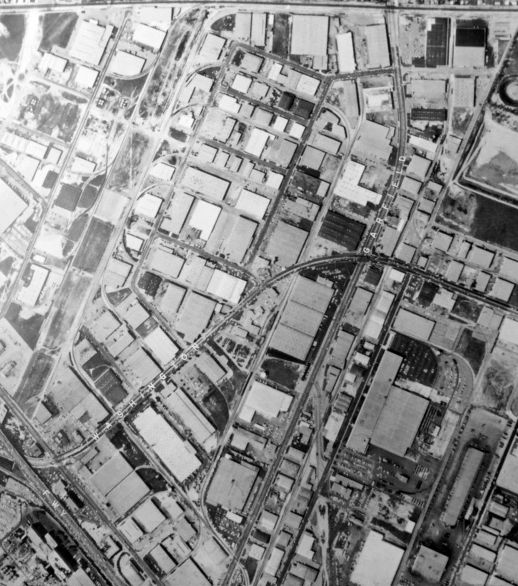
A circa 1983 aerial photo (courtesy of Kevin Walsh) showed no trace of Vail Field.
Dan MacPherson reported in 2003, "The address for Belyea Trucking was 21732 South Santa Fe.
I did not find any hangars on that site.
I cruised Alameda looking for them. Lots of possibilities but I could not locate them."
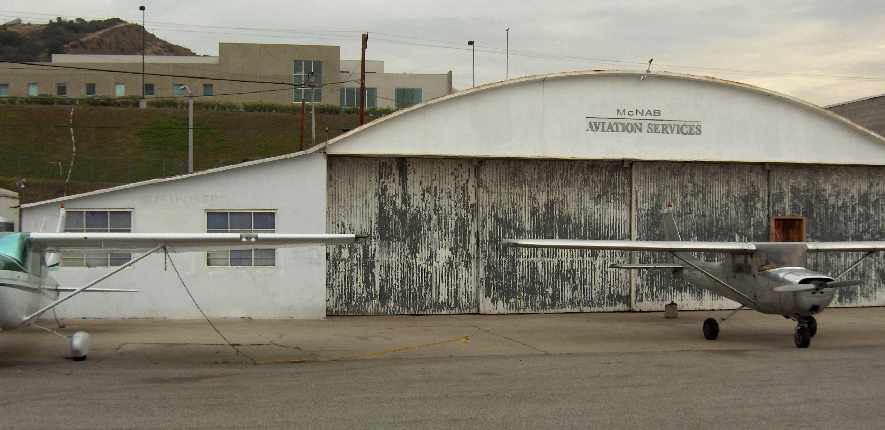
A 2007 photo by Dan MacPherson of one of 2 hangars at Whiteman Airport
which were relocated from Vail Airport to Whiteman (the same hangars are visible in the 1947 photo).
Marc Herman owns this hangar, but “the sad part is that he has several months to demolish the historic hangar.
Mark commented that he should have had the hangar declared a historic monument.
Hank Coffin did business in this hangar while at Whiteman, as did Probert-Devine aviation.
Marc thinks the 'Spirit of St. Louis' was kept in it at one time at Vail.”

A 2016 aerial photo shows no trace of Vail Field remains at the site of the airport.
Several other airfields were located in close proximity to Vail.
Montebello was located directly across Yates Avenue, Eastside Airport was to the south, and Telegraph Airport was to the west.
See also:
http://www.commercemarketplace.com/home/CollectAir/Prints.html
http://www.ucar.edu/communications/staffnotes/0010/here.html
____________________________________________________
Montebello Airport / East Los Angeles Airport, Montebello, CA
33.99, -118.134 (Southeast of Downtown Los Angeles, CA)

Montebello Airport (along with nearby Telegraph-Atlantic & Vail Airports),
as depicted on the 1941 LA Sectional Chart (courtesy of Chris Kennedy).
Montebello Airport sat directly across Yates Avenue from Vail Airport.
The property was by Yates Avenue on the west, and Vail Avenue on the east, Washington Boulevard on the north, and Telegraph Road on the south.
Montebello Airport was opened by Don Reese in 1940.

A circa 1940s aerial view (courtesy of Dan MacPherson) of Montebello Airport (bottom of picture),
along with Vail Airport (top of picture, across Yates Avenue to the north).
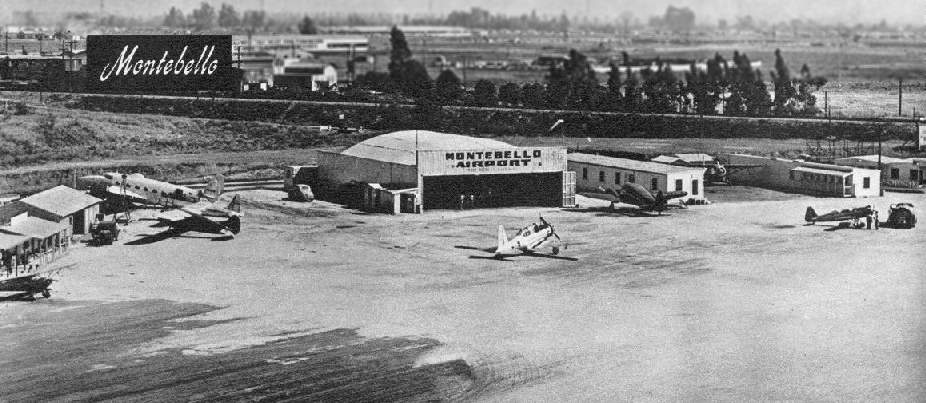
A 1947 photo of Montebello by Don Downie, courtesy of Dan MacPherson.
Note the Lockheed Ventura on the left.
By 1947, the airport had changed hands, and was owned by ventriloquist Edgar Bergen.
In a 1947 Flying Magazine article on LA airports,
Montebello was described as having a 3,400' oiled runway, with tie-down space for 80 aircraft.
As can be seen in the above 1947 photo,
Montebello had at least one hangar, as well as several smaller buildings.

The 1947 LA Local Aeronautical Chart depicted East Los Angeles Airport as having a 3,400' unpaved runway.

A 1947 street map (courtesy of Kevin Walsh) depicted Montebello Airport along with the nearby Vail Field.
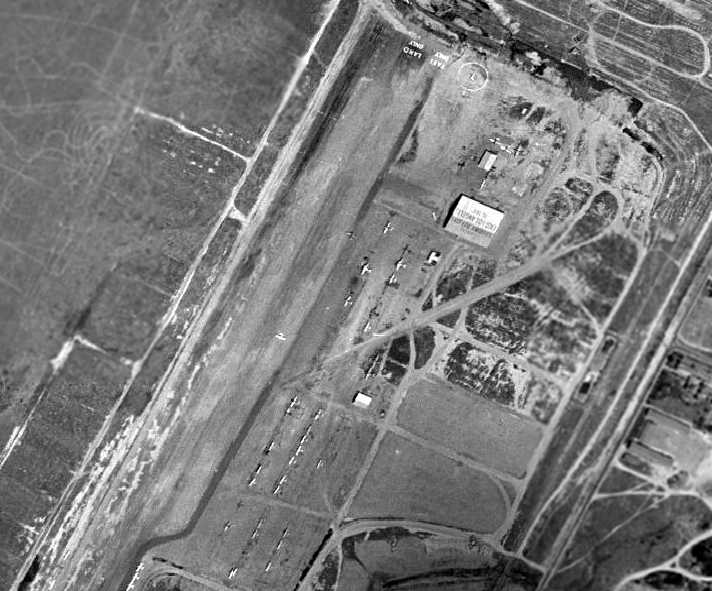
By the time of a 1948 aerial photo, Montebello Airport had been renamed East Los Angeles Airport,
as a 1948 aerial view showed the hangar painted with “East Los Angeles”.
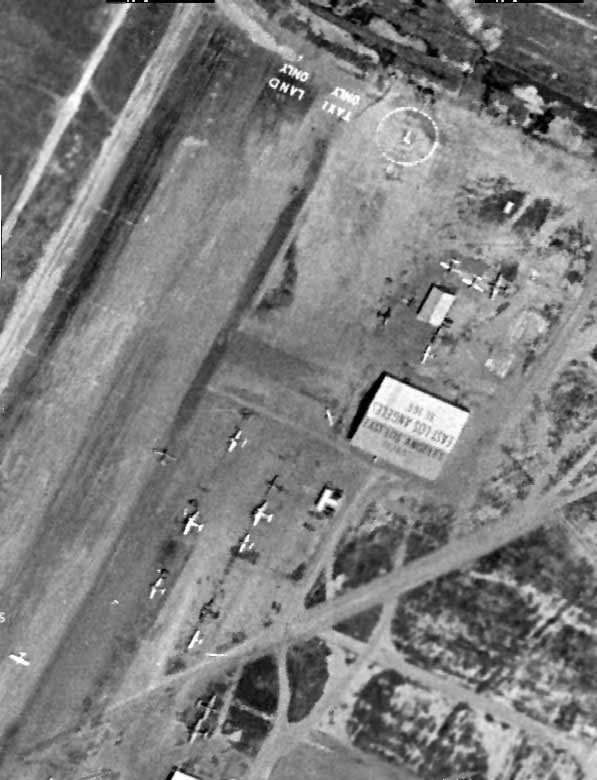
A closeup from the 1948 aerial view showed the hangar, the painted legends saying “Land Only” & “Taxi Only”,
and a large number of aircraft.

East Los Angeles Airport (& nearby Vail Field), as depicted on a 1950 street map (courtesy of Kevin Walsh).

The last photo which has been located of East Los Angeles Airport was an undated aerial view looking north from the 1950 Air Photo Guide (courtesy of Kevin Walsh).
The guide described East Los Angeles Airport as having a 3,400' blacktop north/south runway, and listed the manager as Clarence Bergren.

The last aeronautical chart depiction which has been located of East Los Angeles Airport was on the September 1950 LA Sectional Chart,
which depicted it as having a 3,400' paved runway.
Montebello / East Los Angeles Airport was reportedly still open in 1952.
However, it was apparently closed at some point between 1952-53,
as a 1953 aerial photo shows a row of new buildings along the west side of the site,
which was devoid of any aircraft.
Montebello was no longer depicted at all on the September 1954 USAF LA Sectional Chart (courtesy of Chris Kennedy).
According to Dan MacPherson, "Vail & Montebello airports were both long gone by 1955.
Montebello, I believe was the first to go."
A 1974 aerial photo showed that the site of Montebello Airport had been covered with buildings.

A circa 1983 aerial photo (courtesy of Kevin Walsh) showed no trace of Montebello Airport.

A 2016 aerial photo shows no trace of Montebello Airport remains at the site of the airport.
Dan MacPherson observed, "You can still stand on Vail Avenue
and look at the huge flat pad that was cut into the hilly terrain to build the airport."
Otherwise, not a trace of the airfield appears to remain at the site today - the site is very heavily developed.
Thanks to Dan MacPherson for pointing out this field.
____________________________________________________
Compton Central Airport, Compton, CA
33.91, -118.25 (North of Compton Airport, CA)
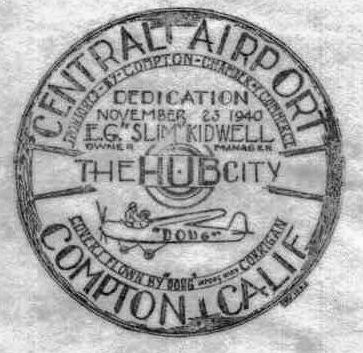
A postmark commemorated the 11/23/40 Dedication of Central Airport.
Compton Central Airport is yet another of the vanished former airports which once were spread all throughout the Los Angeles metropolitan area.
It was located only one mile north of Compton Airport.
There must be a certain amount of confusion about this airport, given the similarly-named "Grand Central" Airport in nearby Glendale.
The date of construction of Central Airport is unknown.
According to K.O. Eckland, in 1939 Central Airport consisted of a 2,000' x 1,800' landing area.
Central Airport was not yet depicted on a 1940 Shell street map (courtesy of Gary Alexander) or the August 1940 San Diego Sectional Chart.
A postmark commemorated the 11/23/40 Dedication of Central Airport.
According to John Underwood, “Central Airport in Compton: it was built & owned by E.G. (Slim) Kidwell, a real oldtimer, in 1940 in collaboration with Doug 'Wrong Way' Corrigan.
Doug was not an easy guy to get along with & the partnership didn’t last.”
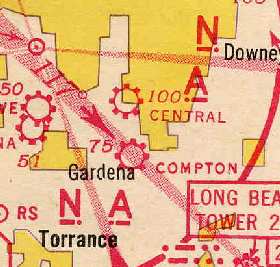
The earliest depiction of Central Airport which has been located was on the 1941 LA Sectional Aeronautical Chart (courtesy of Chris Kennedy).
According to Marissa Abruzzini, “Sometime between 1943-45, a plane was set on fire in a hangar at Compton Airport.
The news dubbed whoever was responsible the 5 'Laughing Vandals'. It was big news at the time.”
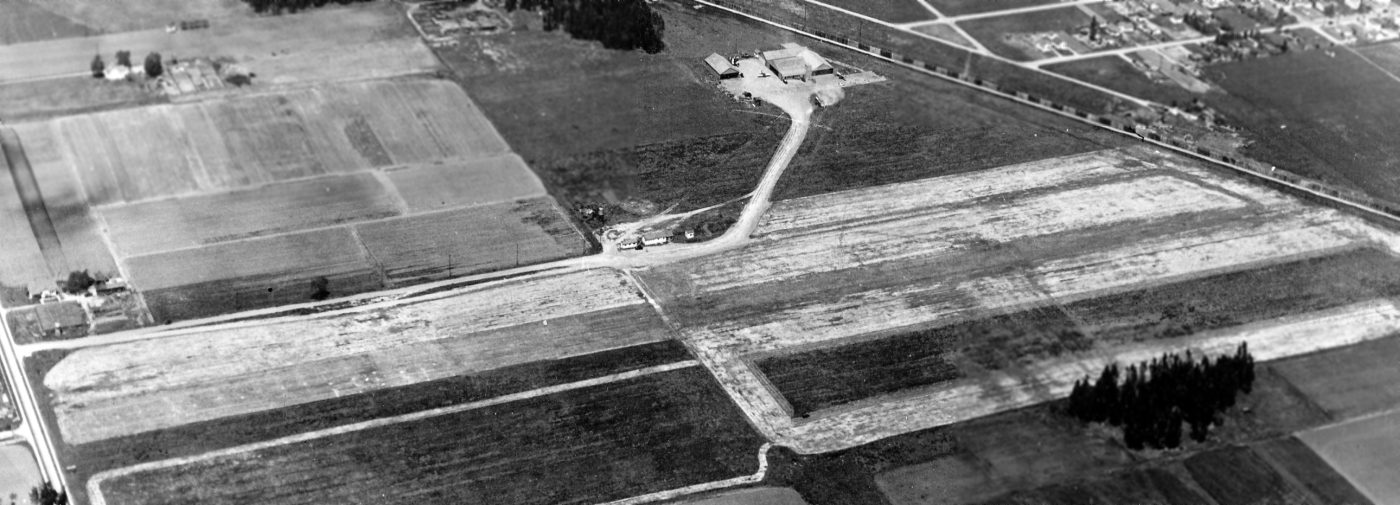
The earliest photo which has been located of Compton Central Airport was a 4/13/44 U.S. Navy aerial view looking northeast (from the National Archives, courtesy of Brian Rehwinkel).
Brian Rehwinkel observed, “This area was still being used for farming.
This airport had a somewhat unusual arrangement in that the hangars were north of the runway & a fairly long taxiway was used to access the runways.”

A closeup from the 4/13/44 U.S. Navy aerial view looking northeast at Compton Central Airport (from the National Archives, courtesy of Brian Rehwinkel).
Brian Rehwinkel observed, “There were only a couple of planes [2 or 3] evident in the photo, but I am sure the wartime restrictions of commercial aviation was the reason for this.”
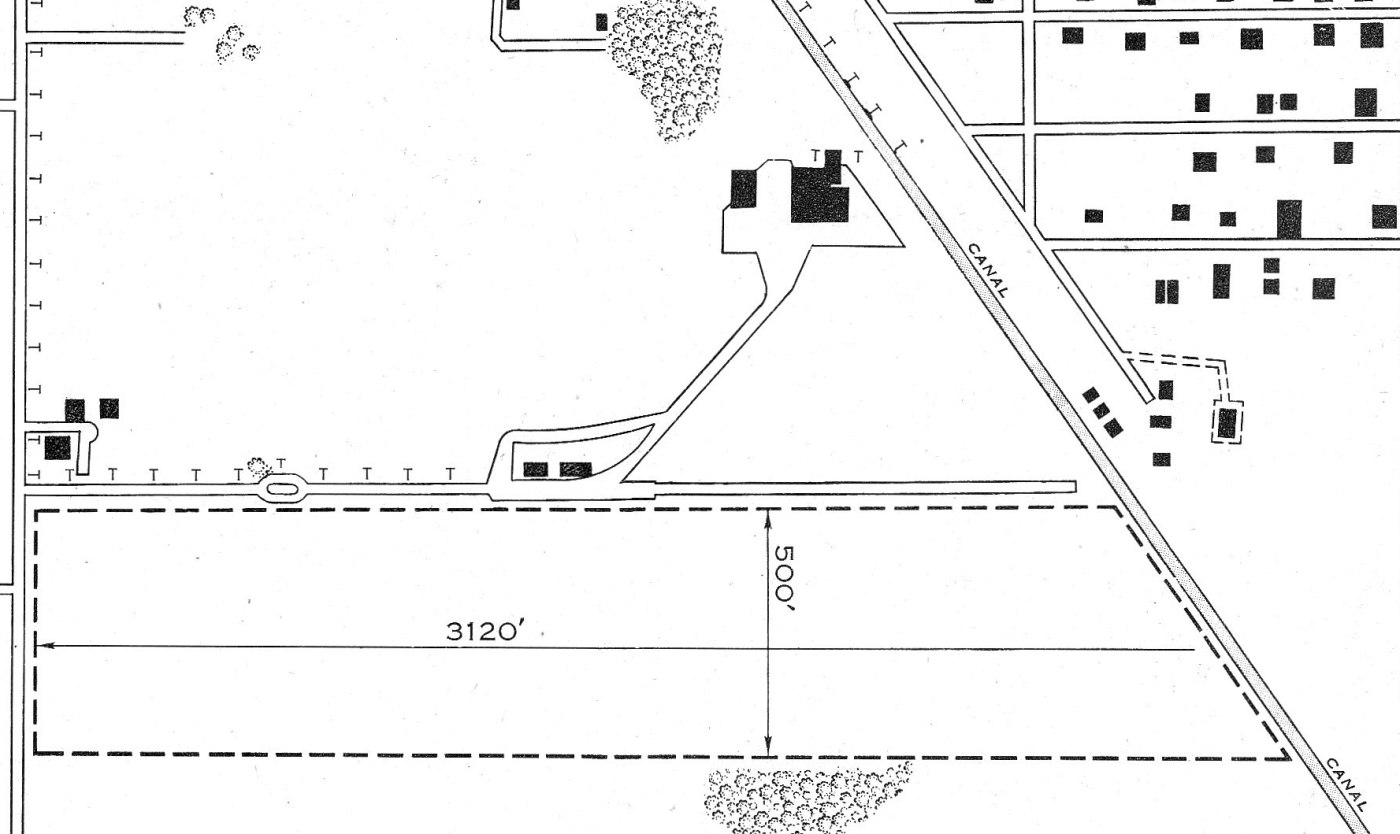
The layout of Compton Central Airport as depicted in the January 1945 USAAF Airport Directory (courtesy of Brian Rehwinkel).
According to Brian Rehwinkel, “The information in the airport directory says the runway was 3,120’ x 500’ & was sod.
Owned & operated by private interests. It also describes 4 hangars at the airport, on the north/northeast side of the field.”
According to John Underwood, Central Airport owner “E.G. (Slim) Kidwell was a test pilot of note
and distributed the Culver Dart in the immediate postwar period & later Bellanca Cruisairs & Cruisemasters.”
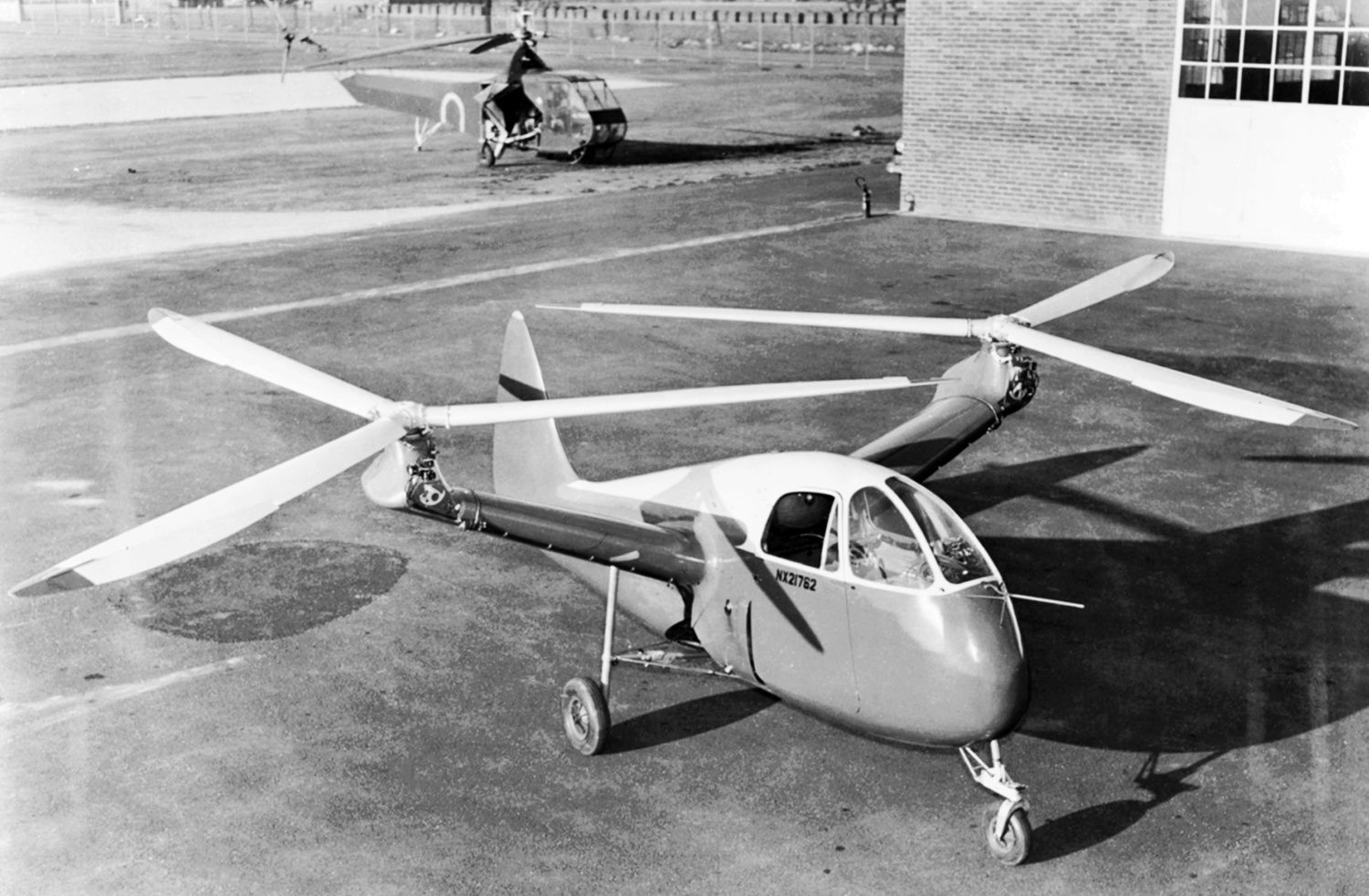
Some test flights of the H-2 took place at Compton Central Airport in 1946.
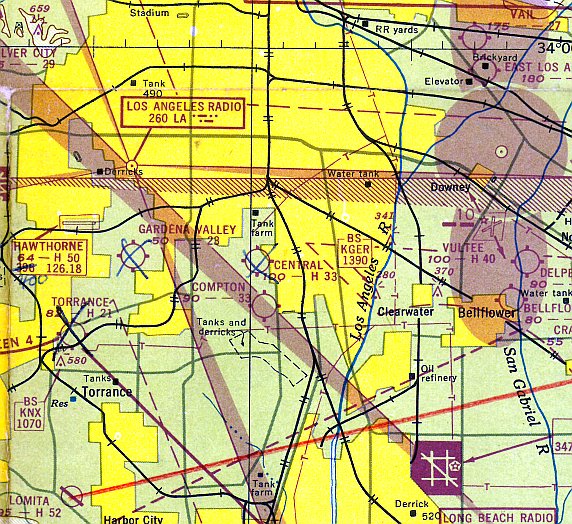
The 1947 LA Local Aeronautical Sectional Chart depicted Central Airport as having a 3,300' paved runway.
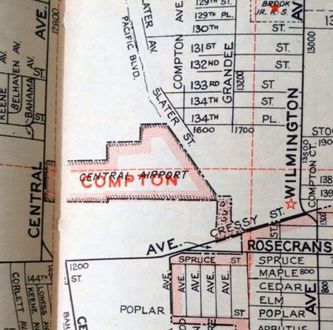
A 1947 street map (courtesy of Kevin Walsh) depicted Central Airport as an irregularly-shaped property outline.
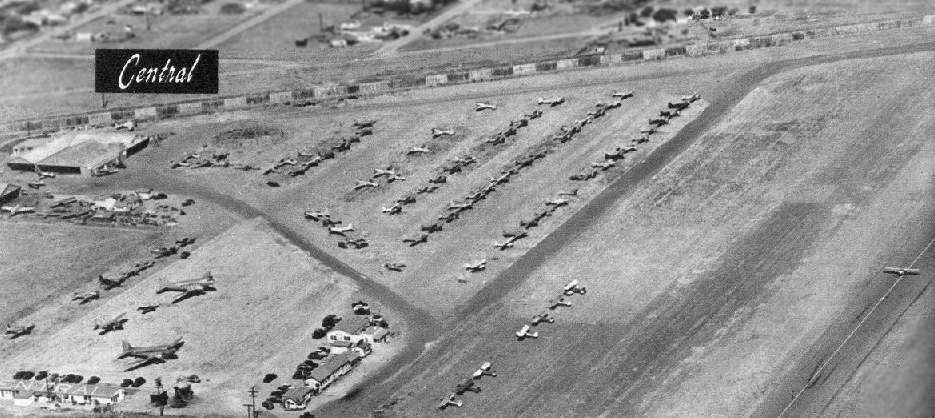
A 1947 aerial view looking northeast at Central Airport by Don Downie (courtesy of Dan MacPherson).
The Compton creek (wash) lines the airport perimeter in the background of the photo, with eucalyptus trees lining the wash. Note the 2 DC-3s at lower left.

A 1947 aerial view looking northwest at Central Airport (courtesy of Norm Cowl). Note the aircraft on the grass runway, parallel to the paved runway.
A large number & variety of the aircaft were parked on the northeast side, including 2 DC-3 airliners.
According to a 1947 Flying Magazine article on LA Airports, Central Airport had a 3,250' oiled runway & 4 hangars, with 160 resident aircraft.

A circa 1947-48 aerial view of Central Airport (courtesy of Harry Gordon),
showing what appeared to be a paved runway with a parallel paved taxiway & a parallel unpaved runway.
Several rows of parked light planes were visible at the far end.

A 1948 advertisement for Central Airport (courtesy of Kevin Walsh).
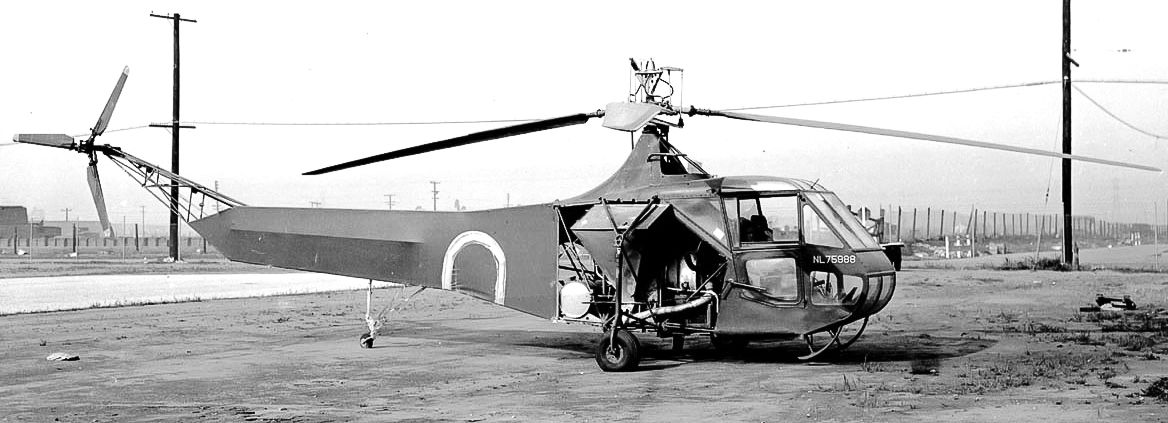
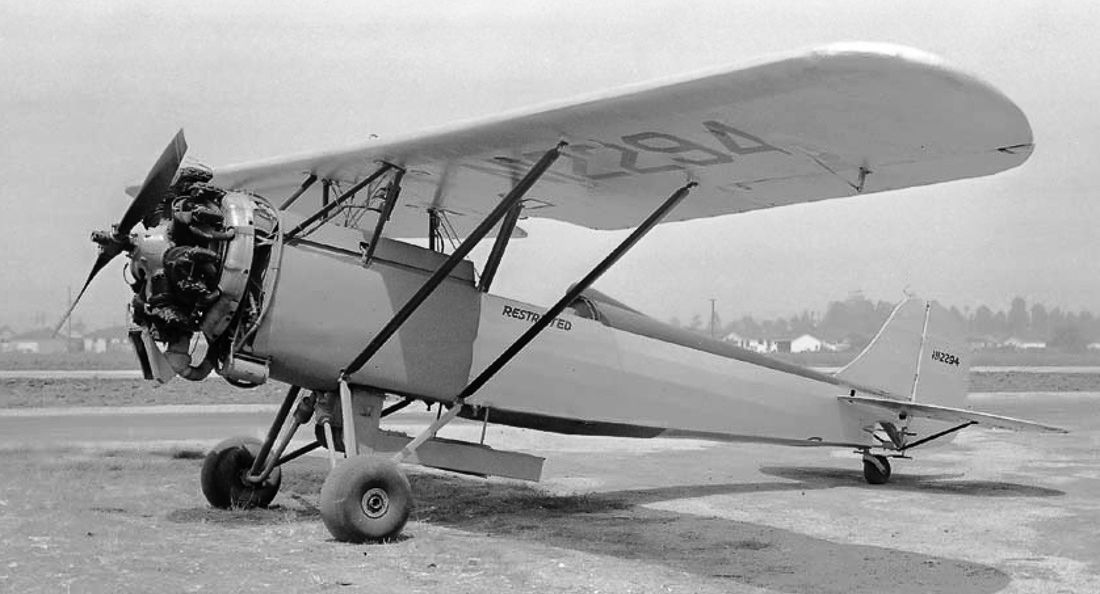
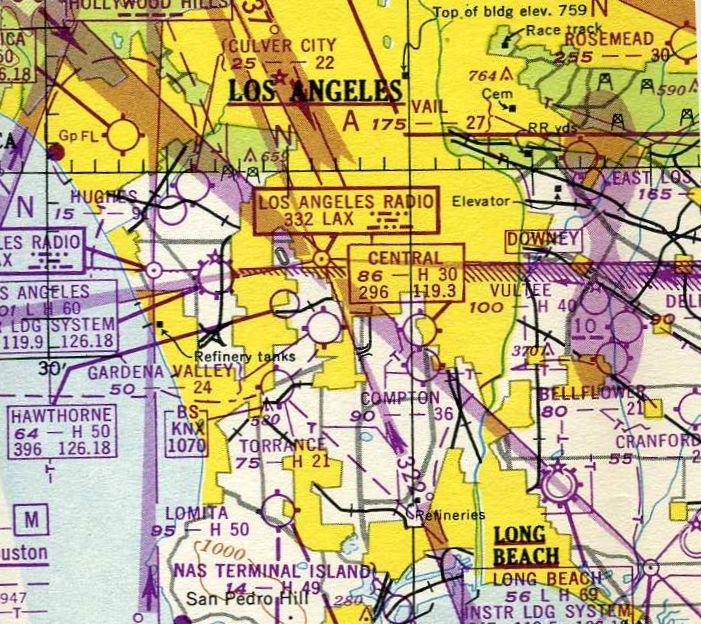
The last aeronautical chart depiction which is available of Central Airport was on the February 1949 LA Sectional Chart,
which depicted Central Airport as having a 3,000' paved runway.

The 1949 USGS topo map depicted Central Airport as having an east/west runway bracketed by parallel taxiways.
According to Harry Gordon, “The airport manager was 'Slim' Kidwell.
They had a control tower of sorts at some point, and the tower operator was Stuart Nelson, the brother of my best friend.”
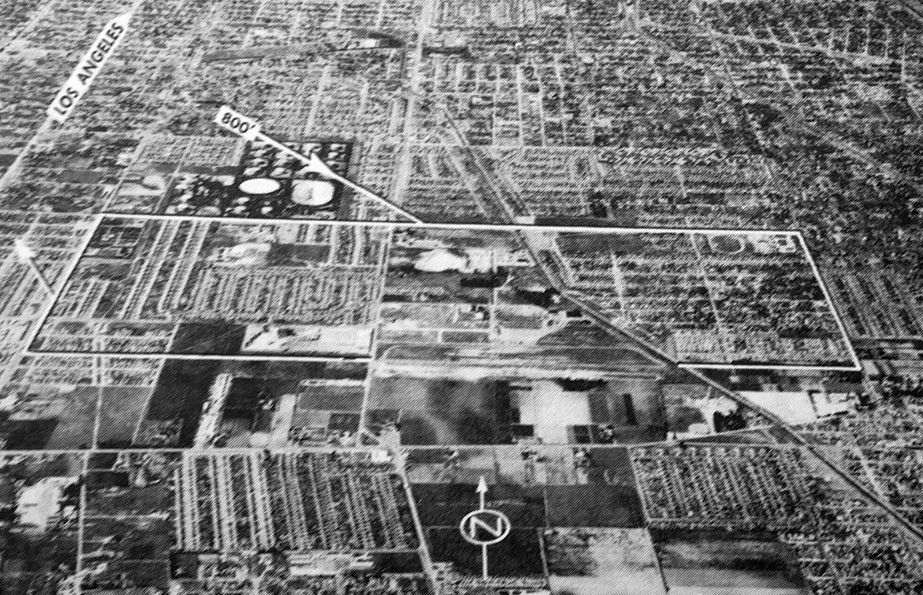
The last depiction which has been located of Central Airport was an undated aerial view looking north from the 1950 Air Photo Guide (courtesy of Kevin Walsh).
The guide described Central Airport as having a 3,000' paved Runway 7/25, and listed the manager as Slim Kidwell.
Central Airport was still depicted as an active airfield on the 1950 LAX Chart, according to Bob Cannon.
A 5/12/51 LA Daily News article (courtesy of Dick Morris) reported the sad news of the end for Central Airport:
“Biltmore Homes has purchased the 80-acre Central Airport & had started construction on 458 homes.”
A 1952 aerial photo showed houses covering the majority of the Central Airport property,
except what appeared to be a section of paved east/west runway & a former hangar.
The street adjacent to the airport (what eventually became the present-day 134th or 135th Street)
was still depicted as "Airport Way" on a 1954 street map & a 1956 street map (courtesy of Kevin Walsh).
Central Airport was no longer depicted at all on the September 1954 USAF LA Sectional Chart (courtesy of Chris Kennedy).
By the time of a 1972 aerial photo, dense housing covered the site of Central Airport.
A 1980 aerial view showed the only only remaining trace of Central Airport:
a sheetmetal hangar on the east side of Water Avenue.

A circa 1983 aerial view (courtesy of Kevin Walsh) of the site of Compton Central Airport.
A 2003 aerial view showed that the former hangar had evidently been removed
and replaced with another row of houses at some point between 1980-2003,
erasing the last trace of Central Airport.
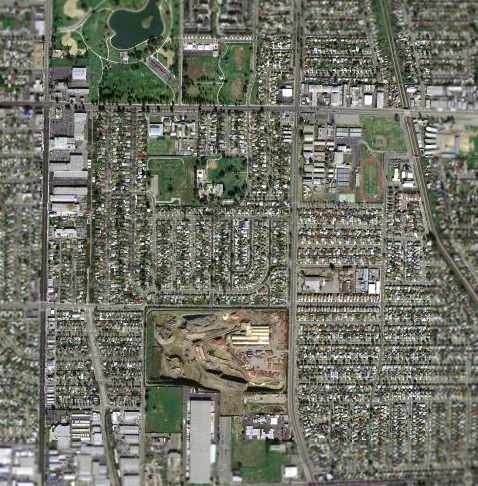
A March 2004 USGS aerial photo showed the site of Compton Central Airport has become a densely developed area.
The site of Central Airport is located at the intersection of North Central Avenue & 135th Street.
____________________________________________________
____________________________________________________
This site covers airfields in all 50 states.